Paul van Yperen's Blog, page 82
July 2, 2023
Ruth Taylor
Ruth Taylor (1905-1984) was an American silent film and early talkie actress of the late 1920s. The vivacious blond Mack Sennett comedienne nabbed the most sought-after role in 1928, Lorelei Lee in the silent film version of Anita Loos' Gentleman Prefer Blondes. Her son was the writer, comic, and actor Buck Henry.

French postcard by Cinémagazine-Edition, no. 611. Photo: Paramount Pictures.
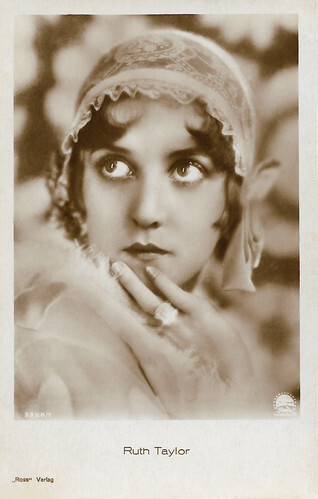
German postcard by Ross Verlag, no. 3388/1, 1928-1929. Photo: Paramount Pictures.
The little girl with a big personality
Ruth Alice Taylor was born in 1905 in Grand Rapids, Michigan. Her parents were Norman and Ivah (Bates) Taylor. She was only two years old when her parents decided to move to Portland, Oregon.
She graduated from the University of Oregon, where she discovered amateur theatre. In 1924, at the age of nineteen, Ruth persuaded her mother to take her to Hollywood. There the teenager spent a year working as an extra at Universal Studios.
Responding to an advertisement, the blonde, blue-eyed girl went to a casting call where she was selected by Mack Sennett out of 200 girls to play a blonde in the Harry Langdon comedy Lucky Stars (Harry Edwards, 1925).
Elizabeth Ann at IMDb : "In 1925 she signed a two-year contract with Mack Sennett and became one of his bathing beauties. With her perky smile and blonde spit curls Ruth quickly became one of Sennett's most popular actresses. She had supporting roles in several comedies including the short A Yankee Doodle Duke (Charles Lamont, 1926) and The Pride Of Pikeville (Charles Lamont, 1927) starring Ben Turpin. Ruth was nicknamed "The Little Girl With A Big Personality"."
She also appeared in such Sennett comedies as Lucky Stars with Harry Langdon and the Puppy Love series with Eddy Cline. For two years, she acted alongside Billy Bevan, Andy Clyde, Alice Day, Vernon Dent, Ralph Graves, Raymond McKee, Eddie Quillan and Ben Turpin in both leading and supporting roles.
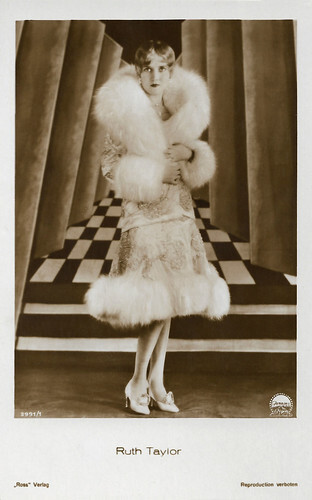
German postcard by Ross Verlag, no. 2991/1, 1928-1929. Photo: Paramount Pictures.
Blue-eyed, gold-digging Lorelei Lee
When her two-year contract with Mack Sennett came to an end, she went through a period of uncertainty during which, having gone freelance in the hope of playing great characters, she was turned down for all her castings. Finally, in August 1927, she unexpectedly signed with the Paramount Famous Lasky Corporation.
She played the role of blue-eyed, gold-digging Lorelei Lee opposite Alice White as Dorothy Shaw and Ford Sterling as Gus Eisman in the silent film version of Gentlemen Prefer Blondes (Malcolm St. Clair, 1928), co-written by Anita Loos based on her 1925 novel.
Her diary reveals that at this time, John Emerson, casting director and co-writer, and director Malcolm St Clair retained her after interviewing two hundred actresses and conducting as many screen tests. "All the blonde actresses of Hollywood were there", she wrote.
Anita Loos, the screenwriter and author of the novel of the same name for which they were looking for the ideal actress to play the main character, also chose Ruth Taylor, telling her at a press conference, in the form of a joke, "Your screen test was the worst, so we're choosing you."
Having become the role of the year, coveted by so many famous actresses, the "chosen one" received congratulations from all sides and went from press conference to photo shoot to photo shoot. Responding to a poll on the best actress for the role, fans sent Paramount Pictures nearly 14,000 letters supporting Ruth Taylor's candidacy. They each received a photo of the actress in return. It was the largest mailing ever recorded by Hollywood for an actress.
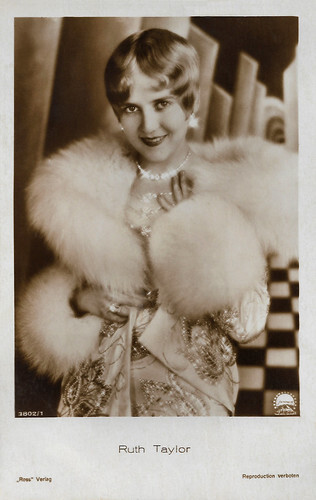
German postcard by Ross Verlag, no. 3802/1, 1928-1929. Photo: Paramount Pictures.
Member of the 1928 WAMPAS Baby Stars class
That same year, following the success of Gentlemen Prefer Blondes, Ruth Taylor starred in Just Married (Frank R. Strayer, 1929), produced by B. P. Schulberg. It featured a new comedy couple, played by Ruth Taylor and James Hall .
Along with Lupe Vélez , Lina Basquette and Sue Carol, she was a member of the 1928 WAMPAS Baby Stars class.
Ruth Taylor acted in her first talkie A Hint to Brides (Leslie Pearce, 1929) for the Christie Film Company. For Paramount Studios she starred in The College Coquette (George Archainbaud, 1929) with William Collier Jr., and for Columbia Pictures Corporation in This Thing Called Love (Paul L. Stein, 1929) with Edmund Lowe and Constance Bennett .
The next year, she played for Pathé Exchange Incorporated in the short comedy Scrappily Married (Leslie Pearce, 1930) with Bert Roach. In 1930, she married retired USAF Brigadier General and New York stockbroker Paul Steinberg Zuckerman. He had served in the Lafayette Escadrille during World War I and as a senior officer in World War II. She decided to quit making films and became a housewife.
Ruth and Paul lived in Palm Springs and were happily married until he died in 1965. The couple had a son Henry Zuckerman aka Buck Henry. At age 16, he picked up his Equity card in 1946 for a role in the long-running comedy, Life With Father. Later he became the successful screenwriter behind such hits as The Graduate (Mike Nichols, 1967). Ruth Taylor died in Palm Springs in 1984 at the age of 79. She is buried at Forest Lawn Memorial Park in Hollywood Hills, California.
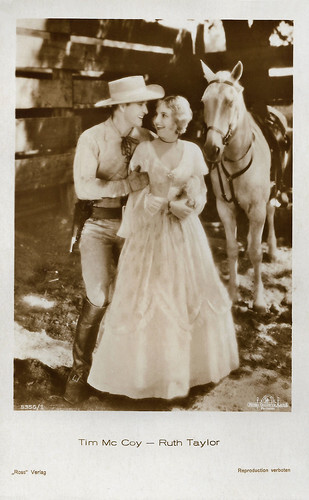
German postcard by Ross Verlag, no. 5356/1, 1930-1931. Photo: Metro Goldwyn Mayer Pictures. Tim McCoy and Ruth Taylor.
Sources: (IMDb), Find A Grave, Wikipedia (French, Spanish and English) and .

French postcard by Cinémagazine-Edition, no. 611. Photo: Paramount Pictures.

German postcard by Ross Verlag, no. 3388/1, 1928-1929. Photo: Paramount Pictures.
The little girl with a big personality
Ruth Alice Taylor was born in 1905 in Grand Rapids, Michigan. Her parents were Norman and Ivah (Bates) Taylor. She was only two years old when her parents decided to move to Portland, Oregon.
She graduated from the University of Oregon, where she discovered amateur theatre. In 1924, at the age of nineteen, Ruth persuaded her mother to take her to Hollywood. There the teenager spent a year working as an extra at Universal Studios.
Responding to an advertisement, the blonde, blue-eyed girl went to a casting call where she was selected by Mack Sennett out of 200 girls to play a blonde in the Harry Langdon comedy Lucky Stars (Harry Edwards, 1925).
Elizabeth Ann at IMDb : "In 1925 she signed a two-year contract with Mack Sennett and became one of his bathing beauties. With her perky smile and blonde spit curls Ruth quickly became one of Sennett's most popular actresses. She had supporting roles in several comedies including the short A Yankee Doodle Duke (Charles Lamont, 1926) and The Pride Of Pikeville (Charles Lamont, 1927) starring Ben Turpin. Ruth was nicknamed "The Little Girl With A Big Personality"."
She also appeared in such Sennett comedies as Lucky Stars with Harry Langdon and the Puppy Love series with Eddy Cline. For two years, she acted alongside Billy Bevan, Andy Clyde, Alice Day, Vernon Dent, Ralph Graves, Raymond McKee, Eddie Quillan and Ben Turpin in both leading and supporting roles.

German postcard by Ross Verlag, no. 2991/1, 1928-1929. Photo: Paramount Pictures.
Blue-eyed, gold-digging Lorelei Lee
When her two-year contract with Mack Sennett came to an end, she went through a period of uncertainty during which, having gone freelance in the hope of playing great characters, she was turned down for all her castings. Finally, in August 1927, she unexpectedly signed with the Paramount Famous Lasky Corporation.
She played the role of blue-eyed, gold-digging Lorelei Lee opposite Alice White as Dorothy Shaw and Ford Sterling as Gus Eisman in the silent film version of Gentlemen Prefer Blondes (Malcolm St. Clair, 1928), co-written by Anita Loos based on her 1925 novel.
Her diary reveals that at this time, John Emerson, casting director and co-writer, and director Malcolm St Clair retained her after interviewing two hundred actresses and conducting as many screen tests. "All the blonde actresses of Hollywood were there", she wrote.
Anita Loos, the screenwriter and author of the novel of the same name for which they were looking for the ideal actress to play the main character, also chose Ruth Taylor, telling her at a press conference, in the form of a joke, "Your screen test was the worst, so we're choosing you."
Having become the role of the year, coveted by so many famous actresses, the "chosen one" received congratulations from all sides and went from press conference to photo shoot to photo shoot. Responding to a poll on the best actress for the role, fans sent Paramount Pictures nearly 14,000 letters supporting Ruth Taylor's candidacy. They each received a photo of the actress in return. It was the largest mailing ever recorded by Hollywood for an actress.

German postcard by Ross Verlag, no. 3802/1, 1928-1929. Photo: Paramount Pictures.
Member of the 1928 WAMPAS Baby Stars class
That same year, following the success of Gentlemen Prefer Blondes, Ruth Taylor starred in Just Married (Frank R. Strayer, 1929), produced by B. P. Schulberg. It featured a new comedy couple, played by Ruth Taylor and James Hall .
Along with Lupe Vélez , Lina Basquette and Sue Carol, she was a member of the 1928 WAMPAS Baby Stars class.
Ruth Taylor acted in her first talkie A Hint to Brides (Leslie Pearce, 1929) for the Christie Film Company. For Paramount Studios she starred in The College Coquette (George Archainbaud, 1929) with William Collier Jr., and for Columbia Pictures Corporation in This Thing Called Love (Paul L. Stein, 1929) with Edmund Lowe and Constance Bennett .
The next year, she played for Pathé Exchange Incorporated in the short comedy Scrappily Married (Leslie Pearce, 1930) with Bert Roach. In 1930, she married retired USAF Brigadier General and New York stockbroker Paul Steinberg Zuckerman. He had served in the Lafayette Escadrille during World War I and as a senior officer in World War II. She decided to quit making films and became a housewife.
Ruth and Paul lived in Palm Springs and were happily married until he died in 1965. The couple had a son Henry Zuckerman aka Buck Henry. At age 16, he picked up his Equity card in 1946 for a role in the long-running comedy, Life With Father. Later he became the successful screenwriter behind such hits as The Graduate (Mike Nichols, 1967). Ruth Taylor died in Palm Springs in 1984 at the age of 79. She is buried at Forest Lawn Memorial Park in Hollywood Hills, California.

German postcard by Ross Verlag, no. 5356/1, 1930-1931. Photo: Metro Goldwyn Mayer Pictures. Tim McCoy and Ruth Taylor.
Sources: (IMDb), Find A Grave, Wikipedia (French, Spanish and English) and .
Published on July 02, 2023 22:00
July 1, 2023
Klaus Kinski
Today is the final day of Il Cinema Ritrovato 2023. The official poster of this year's festival showed Lou Castel, Klaus Kinski, Martine Beswick and Gian Maria Volonté, with their eyes fixed on the horizon on the set of Quién sabe?/El chuncho, quien sabe?/A Bullet for the General (Damiano Damiani, 1966). On the tenth anniversary of the death of Damiani, Il Cinema Ritrovato remembers him with the restoration of Quién sabe?. In this post, we focus on one of the stars of the film, the intense and eccentric Klaus Kinski (1926–1991), one of the most colourful stars of European cinema. In a film career of over 40 years, the German actor appeared in more than 130 films, including numerous parts as a villain in Edgar Wallace thrillers and Spaghetti Westerns. The talented but tempestuous Kinski is probably best known for his riveting star turn in Aguirre, der Zorn Gottes/Aguirre: The Wrath of God (1972), Nosferatu: Phantom der Nacht/Nosferatu the Vampyre (1979), Fitzcarraldo (1982) and other films directed by Werner Herzog.
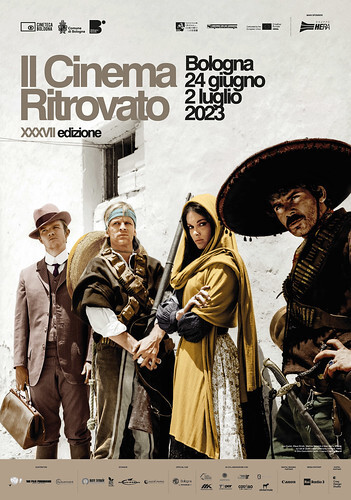 The official poster of Il Cinema Ritrovato 2023. Photo: Divo Cavicchioli / Surf Film. Lou Castel, Klaus Kinski, Martine Beswick and Gian Maria Volonté, with their eyes fixed on the horizon. A shot taken by Divo Cavicchioli on the 1966 set of Quién sabe?/El chuncho, quien sabe?/A Bullet for the General by Damiano Damiani.
The official poster of Il Cinema Ritrovato 2023. Photo: Divo Cavicchioli / Surf Film. Lou Castel, Klaus Kinski, Martine Beswick and Gian Maria Volonté, with their eyes fixed on the horizon. A shot taken by Divo Cavicchioli on the 1966 set of Quién sabe?/El chuncho, quien sabe?/A Bullet for the General by Damiano Damiani.
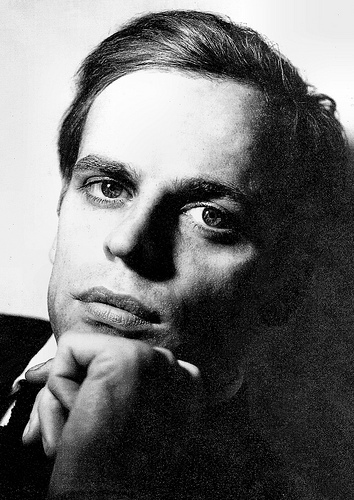
German postcard by Limited Editions, AZ/Drehbuch, Film, no. 124. Photo: I. Letto, ca. 1956.
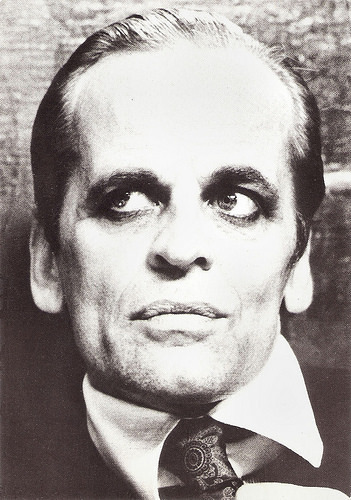
French postcard by Humour a la Carte, Paris, no. 82-11.
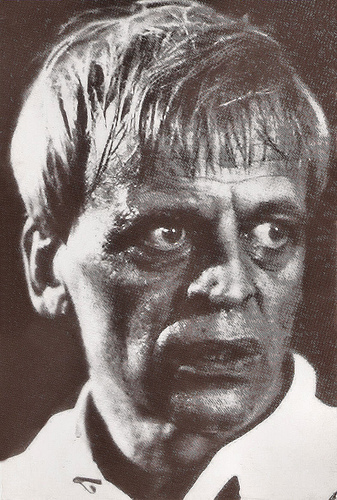
French postcard by Ébullitions, no. 26.
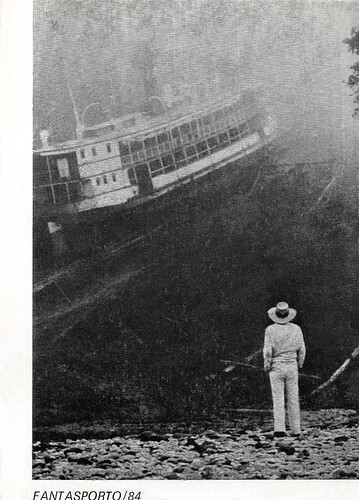
Portugese postcard for Concurso Fantasporto 83 by IV Edicao Internacional de Cinema Fantastico, Porto, 1984. Klaus Kinski in Fitzcarraldo (Werner Herzog, 1982).
Wild and unconventional behaviour
Klaus Kinski was born Nikolaus Günther Nakszyński in Zoppot, Danzig, Germany (now Sopot, Poland), in 1926. He was the son of a German father of Polish descent, Bruno Nakszyński, a pharmacist and a failed opera singer, and a German mother, Susanne Nakszyński-Lutze, a nurse and a daughter of a local pastor. He had three older siblings: Inge, Arne and Hans-Joachim. Because of the depression, the poor family was unable to make a living in Danzig and was forced to move to Berlin in 1931. They settled in a flat in the suburb of Schöneberg. From 1936 on, Kinski attended the Prinz-Heinrich-Gymnasium there.
During World War II, the 16-year-old enlisted in the Wehrmacht. Kinski saw no action until the winter of 1944 when his unit was transferred to the Netherlands. His obituary in Variety magazine states that there he was wounded and captured by the British on the second day of combat, but Kinski's autobiography Ich bin so wild nach deinem Erdbeermund (I Am So Wild About Your Strawberry Mouth, 1975) claims he made a conscious decision to desert.
However, Kinski was transferred to the Prisoner of War Camp 186 in Colchester, Great Britain. The ship transporting him to England was torpedoed by a German U-Boat but managed to arrive safely at its destination. At the POW camp, Kinski played his first theatre roles in shows staged by fellow prisoners intending to maintain morale. Following the end of the war in Europe in May 1945, Kinski was finally allowed in 1946 to return to Germany, after spending a year and four months in captivity.
Arriving in Berlin, Kinski learned his father had died during the war and his mother had been killed in an Allied air attack. Without having ever attended any professional training, he started out as an actor, first at a small touring company in Offenburg and already using his new name Klaus Kinski. He was hired by the renowned Schlosspark-Theater in Berlin but was fired by the manager in 1947 due to his unpredictable behaviour.
Other companies followed, but his already wild and unconventional behaviour regularly got him into trouble. His first film role was a small part in Morituri (Eugen York, 1948) a drama about refugees from a concentration camp. In 1950, he stayed in a psychiatric hospital for three days; medical records from the period listed a preliminary diagnosis of schizophrenia. He only could find bit roles in films, and in 1955 Kinski twice tried to commit suicide.
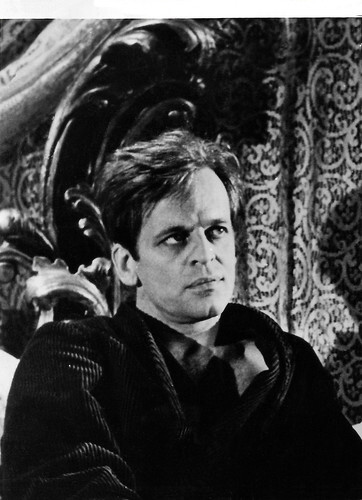
Vintage photo.
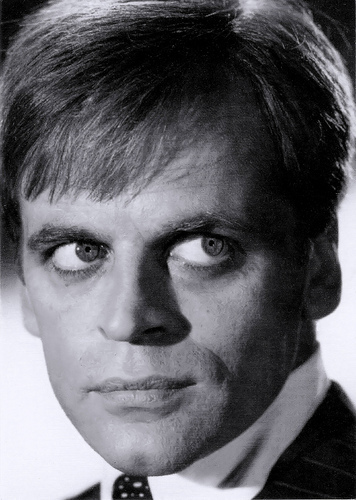
Danish postcard by Forlaget Holger Danske, no. 115. Photo: publicity still for Das Geheimnis der schwarzen Witwe/The Secret of the Black Widow (Franz Josef Gottlieb, 1963).
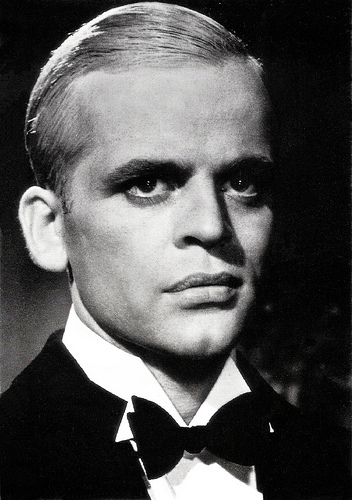
Danish postcard by Forlaget Holger Danske, no. 124. Photo: defd / Kinoarchiv Hamburg.
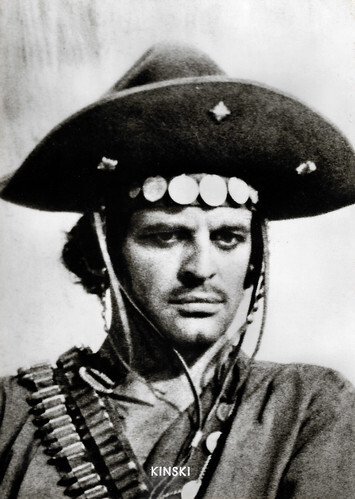
German postcard by Graphima, Berlin, no. 10. Photo: Klaus Kinski in Der letzte Ritt nach Santa Cruz/The Last Ride to Santa Cruz (Rolf Olsen, 1964).
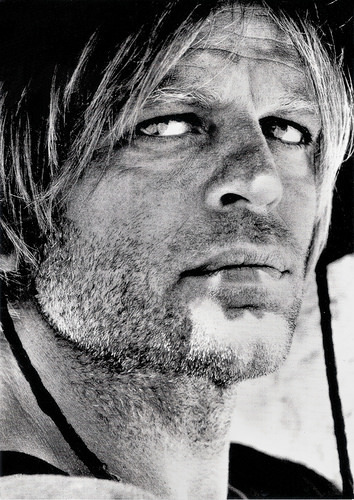
Danish postcard by Forlaget Holger Danske, no. 704. Photo: publicity still for E Dio disse a Caino.../And God Said to Cain (Antonio Margheriti, 1970).
Effective screen villain
Then Klaus Kinski got a supporting part in Ludwig II: Glanz und Ende eines Königs/Ludwig II (Helmut Käutner, 1955) about the frustrated and tragic King Ludwig II of Bavaria played by O.W. Fischer . More supporting parts in German films followed. In March 1956 Kinski made one single guest appearance at Vienna's Burgtheater in Goethe's Torquato Tasso.
Although respected by his colleagues, and cheered by the audience, Kinski's hope to get a permanent contract was not fulfilled, as the Burgtheater's management ultimately became aware of the actor's earlier difficulties in Germany. He unsuccessfully tried to sue the company. Living jobless in Vienna, and without any prospects for his future, Kinski reinvented himself as a monologist and spoken word artist. He presented the prose and verse of François Villon, William Shakespeare and Oscar Wilde among others. Thus he managed to establish himself as a well-known actor touring Austria, Germany, and Switzerland with his shows.
In 1960 he returned to the cinema as a sinister character on the verge between genius and madness in the thriller Der Rächer/The Avenger (Karl Anton, 1960) based on a crime novel by British writer Edgar Wallace. In another Wallace adaptation, Die toten Augen von London/The Dead Eyes of London (Alfred Vohrer, 1961), Kinski’s psychopathic bad guy refused any personal guilt for his evil deeds and claimed to have only followed the orders given to him. During the 1960s, Kinski appeared in several Wallace Krimis, which enjoyed enormous success in Germany and are now considered cult classics.
He also appeared in many other European genre films such as the Karl May Western Winnetou - 2. Teil/Last of the Renegades (Harald Reinl, 1964) featuring Pierre Brice . In these films, he built a reputation as an effective screen villain. In 1964, he relocated to Italy and was cast in the international production Doctor Zhivago (David Lean, 1965) as an Anarchist prisoner on his way to the Gulag. That year he also had a small part as a hunchback in the classic Italian western Per qualche dollaro in più/For Few Dollars More (Sergio Leone, 1965) starring Clint Eastwood .
Roles in numerous other Spaghetti westerns followed, including El chuncho, quien sabe?/A Bullet for the General (Damiano Damiani, 1966) with Gian Maria Volonté, Il grande silenzio/The Great Silence (Sergio Corbucci, 1968) starring Jean-Louis Trintignant , and Un genio, due compari, un pollo/A Genius, Two Partners and a Dupe (Damiano Damiani, 1975) with Terence Hill . When the Spaghetti Western genre was over its top, Kinski started to appear in other exploitation genres. Often these films proved to be brainless trash.
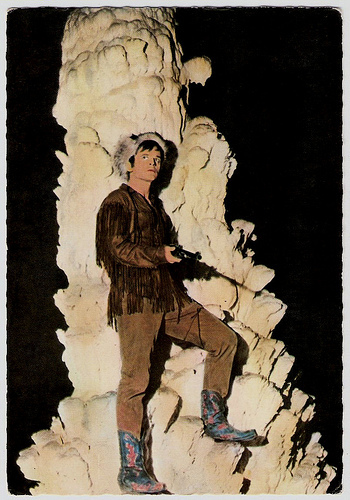
German postcard, no. R 21. Photo: publicity still for Winnetou - 2. Teil/Last of the Renegades (Harald Reinl, 1964).
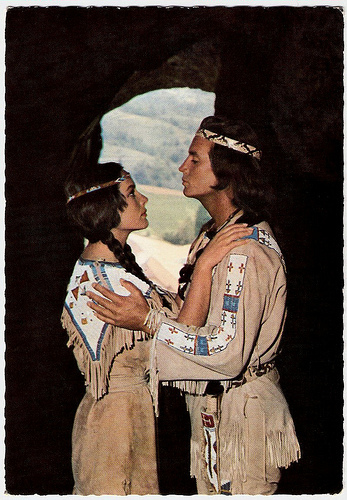
German postcard, no. R 24. Photo: still from Winnetou - 2. Teil/Last of the Renegades (Harald Reinl, 1964) with Karin Dor as Ribanna and Pierre Brice as Winnetou.
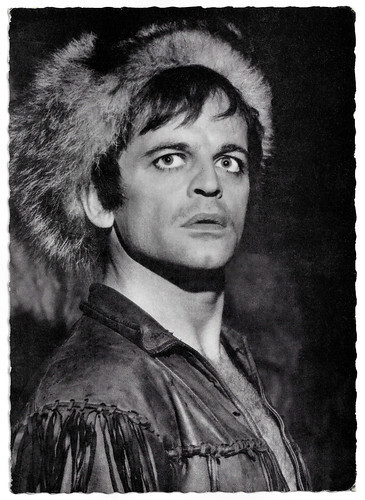
German postcard by Filmbilder-Vertrieb Ernst Freihoff, Essen, no. 891. Photo: Lothar Winkler. Klaus Kinski in Winnetou - 2. Teil/Last of the Renegades (Harald Reinl, 1964).
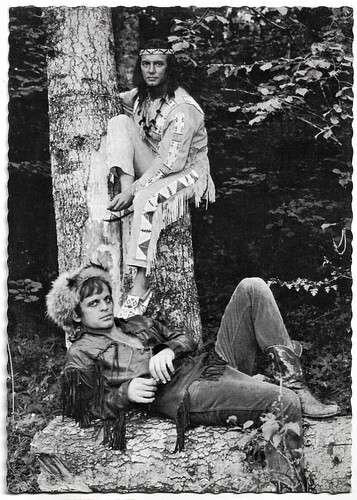
With Pierre Brice . German postcard by Filmbilder-Vertrieb Ernst Freihoff, Essen, no. 901. Photo: Lothar Winkler.
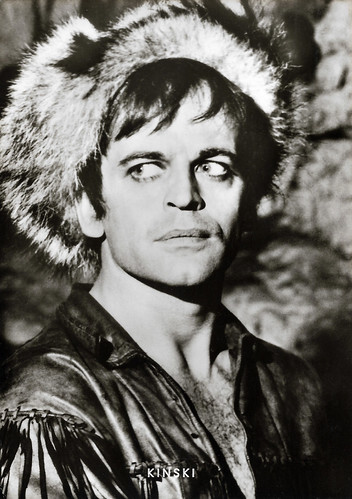
German postcard by Graphima, no. 1. Photo: publicity still for Winnetou - 2. Teil/Last of the Renegades (Harald Reinl, 1964).
An obsessive, terrifying, and emotionally unpredictable antihero
In 1972, in between his countless appearances in genre and exploitation films, Klaus Kinski suddenly found international recognition with the German production Aguirre, der Zorn Gottes/Aguirre: The Wrath of God (Werner Herzog, 1972).
At AllMovie , Karl Williams writes: “The most famed and well-regarded collaboration between New German Cinema director Werner Herzog and his frequent leading man, Klaus Kinski, this epic historical drama was legendary for the arduousness of its on-location filming and the convincing zealous obsession employed by Kinski in playing the title role. Exhausted and near to admitting failure in its quest for riches, the 1650-51 expedition of Spanish conquistador Gonzalo Pizarro (Alejandro Repulles) bogs down in the impenetrable jungles of Peru.
As a last-ditch effort to locate treasure, Pizarro orders a party to scout ahead for signs of El Dorado, the fabled seven cities of gold. In command are a trio of nobles, Pedro de Ursua (Ruy Guerra), Fernando de Guzman (Peter Berling), and Lope de Aguirre (Kinski). Travelling by river raft, the explorers are besieged by hostile natives, disease, starvation and treacherous waters. Crazed with greed and mad with power, Aguirre takes over the enterprise, slaughtering any that oppose him.”
Kinski delivered a bravura performance that typified his screen image: that of an obsessive, terrifying, and emotionally unpredictable antihero. Kinski and Herzog would make five films together, including Woyzeck (1978), Nosferatu: Phantom der Nacht/Nosferatu the Vampyre (1979) with Isabelle Adjani , and Fitzcarraldo (1982) with Claudia Cardinale .
The volatile love-hate relationship between Kinski and his equally driven and obsessive director Herzog resulted in some of the best work from both men, and both are best known for the films on which they collaborated. Kinski and Herzog pushed each other to extremes over a 15-year working relationship, which finally ended after filming Cobra Verde (Werner Herzog, 1987), a production plagued by volcanic clashes between the star and director, involving violent physical altercations and mutual death threats.
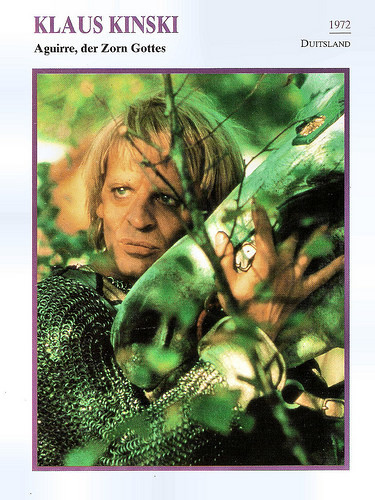
Dutch collectors card in the series 'Filmsterren: een portret' by Edito Service, 1995. Photo: Pele / Stills. Publicity still for Aguirre der Zorn Gottes/Aguirre, the Wrath of God (Werner Herzog, 1972).
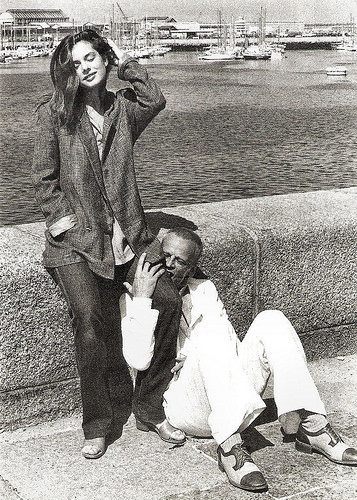
With his daughter Nastassja Kinski . French postcard in the Collection Cinéma by Editions Malibran, Paris, no. CF 50. Photo: Guidotti, 1978.
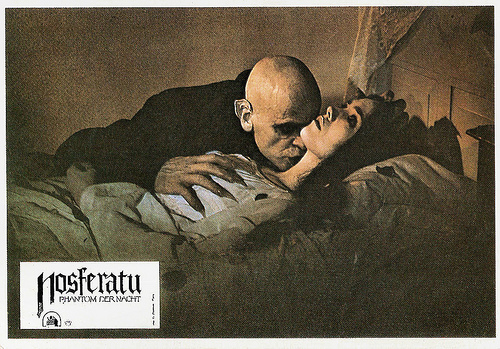
British postcard by Moviedrome, no. M45. Photo: 20th Century Fox. Publicity still for Nosferatu: Phantom der Nacht/Nosferatu the Vampyre (Werner Herzog, 1979) with Isabelle Adjani .
'Cretins' or 'scum'
The Encyclopaedia Britannica writes that Klaus Kinski “disdained his chosen profession, once saying, ‘I wish I’d never been an actor. I’d rather have been a streetwalker, selling my body, than selling my tears and my laughter, my grief and my joy’. Numerous offers from prestigious directors—whom Kinski categorised as ‘cretins’ or ‘scum’—were refused; he worked only when the money suited him.”
Kinski was also notorious – and in high demand – for his scandalous TV appearances and interviews. The scandals paid off. Although he continued to appear for the money in countless trash films, Kinski also starred in such respectable films as the French melodrama L'important c'est d'aimer/The Main Thing Is to Love (Andrzej Zulawski, 1975) starring a memorable Romy Schneider , and the Oscar-nominated Israeli production Mivtsa Yonatan/Operation Thunderbolt (Menahem Golan, 1977), based on the 1976 hijacking of a Tel Aviv-Athens-Paris Air France flight and the daring rescue of its 104 passengers in Entebbe, Uganda.
In the 1980s Kinski appeared prominently in such Hollywood productions as the comedy Buddy Buddy (Billy Wilder, 1981) as a neurotic sex scientist opposite Jack Lemmon and Walter Matthau, and the thriller The Little Drummer Girl (George Roy Hill, 1984) featuring Diane Keaton. Kinski’s last film was Kinski Paganini (Klaus Kinski, 1989), in which he played the 19th-century ‘devil’ violinist Niccolò Paganini. He also wrote and directed the film and his wife Debora and his son Nikolai also starred in the film. The production was marked by chaos and clashes between Kinski and his producers, who accused him of turning their production into a pornographic film and sued him in court. The result was a commercial and critical flop.
Kinski reinforced his image as a wild-eyed, sex-crazed maniac in his autobiography 'Ich bin so wild nach deinem Erdbeermund' (1975). In 1988 he updated and rereleased it as 'Ich brauche Liebe' (All I Need Is Love) and in 1997 it was again rereleased as 'Kinski Uncut'. The book infuriated many, and prompted his daughter Nastassja Kinski to file a libel suit against him. Werner Herzog would later say in his retrospective film Mein liebster Feind - Klaus Kinski/Kinski, My Best Fiend (Werner Herzog, 1999) that much of the autobiography was fabricated to generate sales; the two even collaborated on the insults about the director.
Klaus Kinski died of a heart attack in Lagunitas, California, U.S. at age 65. His ashes were scattered into the Pacific Ocean. He was married four times: to Gislinde Kühbeck (1952-1955), Brigitte Ruth Tocki (1960-1971), Minhoi Geneviève Loanic (1971-1979), and to Debora Caprioglio (1987-1989). His three children Pola Kinski (1952), Nastassja Kinski (1961) and Nikolai Kinski (1976) are all actors. In 2006 Christian David published the first comprehensive biography based on newly discovered archived material, personal letters and interviews with Kinski's friends and colleagues.
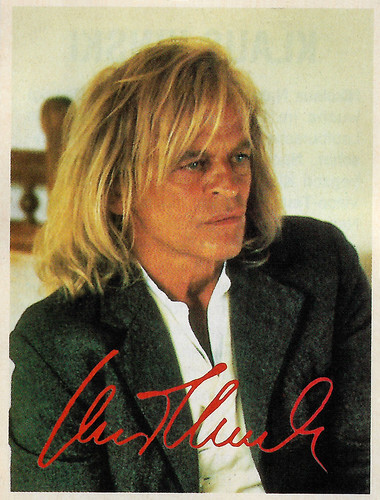
Small German collectors card.
Trailer for Il grande silenzio/The Great Silence (Sergio Corbucci, 1968). Dource: Danios12345 (YouTube).
Trailer for Nosferatu: Phantom der Nacht/Nosferatu the Vampyre (Werner Herzog, 1979). Source: Danios12345 (YouTube).
Long scene from Mein liebster Feind - Klaus Kinski/Kinski, My Best Fiend (Werner Herzog, 1999) with a raging Kinski during the shooting of Fitzcarraldo (1982). Source: Baranowski (YouTube).
Sources: Dan Schneider (Alt Film Guide), (IMDb), Hal Erickson (AllMovie), Karl Williams (AllMovie), Encyclopaedia Britannica, Filmportal.de, Wikipedia and .
 The official poster of Il Cinema Ritrovato 2023. Photo: Divo Cavicchioli / Surf Film. Lou Castel, Klaus Kinski, Martine Beswick and Gian Maria Volonté, with their eyes fixed on the horizon. A shot taken by Divo Cavicchioli on the 1966 set of Quién sabe?/El chuncho, quien sabe?/A Bullet for the General by Damiano Damiani.
The official poster of Il Cinema Ritrovato 2023. Photo: Divo Cavicchioli / Surf Film. Lou Castel, Klaus Kinski, Martine Beswick and Gian Maria Volonté, with their eyes fixed on the horizon. A shot taken by Divo Cavicchioli on the 1966 set of Quién sabe?/El chuncho, quien sabe?/A Bullet for the General by Damiano Damiani.
German postcard by Limited Editions, AZ/Drehbuch, Film, no. 124. Photo: I. Letto, ca. 1956.

French postcard by Humour a la Carte, Paris, no. 82-11.

French postcard by Ébullitions, no. 26.

Portugese postcard for Concurso Fantasporto 83 by IV Edicao Internacional de Cinema Fantastico, Porto, 1984. Klaus Kinski in Fitzcarraldo (Werner Herzog, 1982).
Wild and unconventional behaviour
Klaus Kinski was born Nikolaus Günther Nakszyński in Zoppot, Danzig, Germany (now Sopot, Poland), in 1926. He was the son of a German father of Polish descent, Bruno Nakszyński, a pharmacist and a failed opera singer, and a German mother, Susanne Nakszyński-Lutze, a nurse and a daughter of a local pastor. He had three older siblings: Inge, Arne and Hans-Joachim. Because of the depression, the poor family was unable to make a living in Danzig and was forced to move to Berlin in 1931. They settled in a flat in the suburb of Schöneberg. From 1936 on, Kinski attended the Prinz-Heinrich-Gymnasium there.
During World War II, the 16-year-old enlisted in the Wehrmacht. Kinski saw no action until the winter of 1944 when his unit was transferred to the Netherlands. His obituary in Variety magazine states that there he was wounded and captured by the British on the second day of combat, but Kinski's autobiography Ich bin so wild nach deinem Erdbeermund (I Am So Wild About Your Strawberry Mouth, 1975) claims he made a conscious decision to desert.
However, Kinski was transferred to the Prisoner of War Camp 186 in Colchester, Great Britain. The ship transporting him to England was torpedoed by a German U-Boat but managed to arrive safely at its destination. At the POW camp, Kinski played his first theatre roles in shows staged by fellow prisoners intending to maintain morale. Following the end of the war in Europe in May 1945, Kinski was finally allowed in 1946 to return to Germany, after spending a year and four months in captivity.
Arriving in Berlin, Kinski learned his father had died during the war and his mother had been killed in an Allied air attack. Without having ever attended any professional training, he started out as an actor, first at a small touring company in Offenburg and already using his new name Klaus Kinski. He was hired by the renowned Schlosspark-Theater in Berlin but was fired by the manager in 1947 due to his unpredictable behaviour.
Other companies followed, but his already wild and unconventional behaviour regularly got him into trouble. His first film role was a small part in Morituri (Eugen York, 1948) a drama about refugees from a concentration camp. In 1950, he stayed in a psychiatric hospital for three days; medical records from the period listed a preliminary diagnosis of schizophrenia. He only could find bit roles in films, and in 1955 Kinski twice tried to commit suicide.

Vintage photo.

Danish postcard by Forlaget Holger Danske, no. 115. Photo: publicity still for Das Geheimnis der schwarzen Witwe/The Secret of the Black Widow (Franz Josef Gottlieb, 1963).

Danish postcard by Forlaget Holger Danske, no. 124. Photo: defd / Kinoarchiv Hamburg.

German postcard by Graphima, Berlin, no. 10. Photo: Klaus Kinski in Der letzte Ritt nach Santa Cruz/The Last Ride to Santa Cruz (Rolf Olsen, 1964).

Danish postcard by Forlaget Holger Danske, no. 704. Photo: publicity still for E Dio disse a Caino.../And God Said to Cain (Antonio Margheriti, 1970).
Effective screen villain
Then Klaus Kinski got a supporting part in Ludwig II: Glanz und Ende eines Königs/Ludwig II (Helmut Käutner, 1955) about the frustrated and tragic King Ludwig II of Bavaria played by O.W. Fischer . More supporting parts in German films followed. In March 1956 Kinski made one single guest appearance at Vienna's Burgtheater in Goethe's Torquato Tasso.
Although respected by his colleagues, and cheered by the audience, Kinski's hope to get a permanent contract was not fulfilled, as the Burgtheater's management ultimately became aware of the actor's earlier difficulties in Germany. He unsuccessfully tried to sue the company. Living jobless in Vienna, and without any prospects for his future, Kinski reinvented himself as a monologist and spoken word artist. He presented the prose and verse of François Villon, William Shakespeare and Oscar Wilde among others. Thus he managed to establish himself as a well-known actor touring Austria, Germany, and Switzerland with his shows.
In 1960 he returned to the cinema as a sinister character on the verge between genius and madness in the thriller Der Rächer/The Avenger (Karl Anton, 1960) based on a crime novel by British writer Edgar Wallace. In another Wallace adaptation, Die toten Augen von London/The Dead Eyes of London (Alfred Vohrer, 1961), Kinski’s psychopathic bad guy refused any personal guilt for his evil deeds and claimed to have only followed the orders given to him. During the 1960s, Kinski appeared in several Wallace Krimis, which enjoyed enormous success in Germany and are now considered cult classics.
He also appeared in many other European genre films such as the Karl May Western Winnetou - 2. Teil/Last of the Renegades (Harald Reinl, 1964) featuring Pierre Brice . In these films, he built a reputation as an effective screen villain. In 1964, he relocated to Italy and was cast in the international production Doctor Zhivago (David Lean, 1965) as an Anarchist prisoner on his way to the Gulag. That year he also had a small part as a hunchback in the classic Italian western Per qualche dollaro in più/For Few Dollars More (Sergio Leone, 1965) starring Clint Eastwood .
Roles in numerous other Spaghetti westerns followed, including El chuncho, quien sabe?/A Bullet for the General (Damiano Damiani, 1966) with Gian Maria Volonté, Il grande silenzio/The Great Silence (Sergio Corbucci, 1968) starring Jean-Louis Trintignant , and Un genio, due compari, un pollo/A Genius, Two Partners and a Dupe (Damiano Damiani, 1975) with Terence Hill . When the Spaghetti Western genre was over its top, Kinski started to appear in other exploitation genres. Often these films proved to be brainless trash.

German postcard, no. R 21. Photo: publicity still for Winnetou - 2. Teil/Last of the Renegades (Harald Reinl, 1964).

German postcard, no. R 24. Photo: still from Winnetou - 2. Teil/Last of the Renegades (Harald Reinl, 1964) with Karin Dor as Ribanna and Pierre Brice as Winnetou.

German postcard by Filmbilder-Vertrieb Ernst Freihoff, Essen, no. 891. Photo: Lothar Winkler. Klaus Kinski in Winnetou - 2. Teil/Last of the Renegades (Harald Reinl, 1964).

With Pierre Brice . German postcard by Filmbilder-Vertrieb Ernst Freihoff, Essen, no. 901. Photo: Lothar Winkler.

German postcard by Graphima, no. 1. Photo: publicity still for Winnetou - 2. Teil/Last of the Renegades (Harald Reinl, 1964).
An obsessive, terrifying, and emotionally unpredictable antihero
In 1972, in between his countless appearances in genre and exploitation films, Klaus Kinski suddenly found international recognition with the German production Aguirre, der Zorn Gottes/Aguirre: The Wrath of God (Werner Herzog, 1972).
At AllMovie , Karl Williams writes: “The most famed and well-regarded collaboration between New German Cinema director Werner Herzog and his frequent leading man, Klaus Kinski, this epic historical drama was legendary for the arduousness of its on-location filming and the convincing zealous obsession employed by Kinski in playing the title role. Exhausted and near to admitting failure in its quest for riches, the 1650-51 expedition of Spanish conquistador Gonzalo Pizarro (Alejandro Repulles) bogs down in the impenetrable jungles of Peru.
As a last-ditch effort to locate treasure, Pizarro orders a party to scout ahead for signs of El Dorado, the fabled seven cities of gold. In command are a trio of nobles, Pedro de Ursua (Ruy Guerra), Fernando de Guzman (Peter Berling), and Lope de Aguirre (Kinski). Travelling by river raft, the explorers are besieged by hostile natives, disease, starvation and treacherous waters. Crazed with greed and mad with power, Aguirre takes over the enterprise, slaughtering any that oppose him.”
Kinski delivered a bravura performance that typified his screen image: that of an obsessive, terrifying, and emotionally unpredictable antihero. Kinski and Herzog would make five films together, including Woyzeck (1978), Nosferatu: Phantom der Nacht/Nosferatu the Vampyre (1979) with Isabelle Adjani , and Fitzcarraldo (1982) with Claudia Cardinale .
The volatile love-hate relationship between Kinski and his equally driven and obsessive director Herzog resulted in some of the best work from both men, and both are best known for the films on which they collaborated. Kinski and Herzog pushed each other to extremes over a 15-year working relationship, which finally ended after filming Cobra Verde (Werner Herzog, 1987), a production plagued by volcanic clashes between the star and director, involving violent physical altercations and mutual death threats.

Dutch collectors card in the series 'Filmsterren: een portret' by Edito Service, 1995. Photo: Pele / Stills. Publicity still for Aguirre der Zorn Gottes/Aguirre, the Wrath of God (Werner Herzog, 1972).

With his daughter Nastassja Kinski . French postcard in the Collection Cinéma by Editions Malibran, Paris, no. CF 50. Photo: Guidotti, 1978.

British postcard by Moviedrome, no. M45. Photo: 20th Century Fox. Publicity still for Nosferatu: Phantom der Nacht/Nosferatu the Vampyre (Werner Herzog, 1979) with Isabelle Adjani .
'Cretins' or 'scum'
The Encyclopaedia Britannica writes that Klaus Kinski “disdained his chosen profession, once saying, ‘I wish I’d never been an actor. I’d rather have been a streetwalker, selling my body, than selling my tears and my laughter, my grief and my joy’. Numerous offers from prestigious directors—whom Kinski categorised as ‘cretins’ or ‘scum’—were refused; he worked only when the money suited him.”
Kinski was also notorious – and in high demand – for his scandalous TV appearances and interviews. The scandals paid off. Although he continued to appear for the money in countless trash films, Kinski also starred in such respectable films as the French melodrama L'important c'est d'aimer/The Main Thing Is to Love (Andrzej Zulawski, 1975) starring a memorable Romy Schneider , and the Oscar-nominated Israeli production Mivtsa Yonatan/Operation Thunderbolt (Menahem Golan, 1977), based on the 1976 hijacking of a Tel Aviv-Athens-Paris Air France flight and the daring rescue of its 104 passengers in Entebbe, Uganda.
In the 1980s Kinski appeared prominently in such Hollywood productions as the comedy Buddy Buddy (Billy Wilder, 1981) as a neurotic sex scientist opposite Jack Lemmon and Walter Matthau, and the thriller The Little Drummer Girl (George Roy Hill, 1984) featuring Diane Keaton. Kinski’s last film was Kinski Paganini (Klaus Kinski, 1989), in which he played the 19th-century ‘devil’ violinist Niccolò Paganini. He also wrote and directed the film and his wife Debora and his son Nikolai also starred in the film. The production was marked by chaos and clashes between Kinski and his producers, who accused him of turning their production into a pornographic film and sued him in court. The result was a commercial and critical flop.
Kinski reinforced his image as a wild-eyed, sex-crazed maniac in his autobiography 'Ich bin so wild nach deinem Erdbeermund' (1975). In 1988 he updated and rereleased it as 'Ich brauche Liebe' (All I Need Is Love) and in 1997 it was again rereleased as 'Kinski Uncut'. The book infuriated many, and prompted his daughter Nastassja Kinski to file a libel suit against him. Werner Herzog would later say in his retrospective film Mein liebster Feind - Klaus Kinski/Kinski, My Best Fiend (Werner Herzog, 1999) that much of the autobiography was fabricated to generate sales; the two even collaborated on the insults about the director.
Klaus Kinski died of a heart attack in Lagunitas, California, U.S. at age 65. His ashes were scattered into the Pacific Ocean. He was married four times: to Gislinde Kühbeck (1952-1955), Brigitte Ruth Tocki (1960-1971), Minhoi Geneviève Loanic (1971-1979), and to Debora Caprioglio (1987-1989). His three children Pola Kinski (1952), Nastassja Kinski (1961) and Nikolai Kinski (1976) are all actors. In 2006 Christian David published the first comprehensive biography based on newly discovered archived material, personal letters and interviews with Kinski's friends and colleagues.

Small German collectors card.
Trailer for Il grande silenzio/The Great Silence (Sergio Corbucci, 1968). Dource: Danios12345 (YouTube).
Trailer for Nosferatu: Phantom der Nacht/Nosferatu the Vampyre (Werner Herzog, 1979). Source: Danios12345 (YouTube).
Long scene from Mein liebster Feind - Klaus Kinski/Kinski, My Best Fiend (Werner Herzog, 1999) with a raging Kinski during the shooting of Fitzcarraldo (1982). Source: Baranowski (YouTube).
Sources: Dan Schneider (Alt Film Guide), (IMDb), Hal Erickson (AllMovie), Karl Williams (AllMovie), Encyclopaedia Britannica, Filmportal.de, Wikipedia and .
Published on July 01, 2023 22:00
June 30, 2023
One Hundred Years Ago: Films Albatros
Oliver Hanley curates the One Hundred Years Ago section at Il Cinema Ritrovato this year. He explores the rich and varied history of the cinema in 1923 and selected classics, archival rarities and thought-provoking documentaries from 1923. In Hollywood, the Western became a serious genre in Hollywood, in Germany, the expressionist cinema reached its pinnacle and in Italy, the final Diva films were made. In this post, EFSP focuses on France where the exiled Russian filmmakers started to work at the studio Films Albatros in a suburb of Paris and produced several highlights of the European silent cinema.
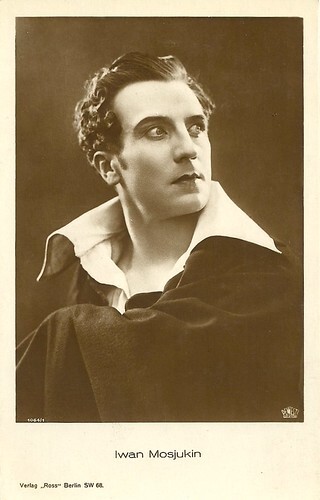
German postcard by Ross Verlag. no. 1064/1. Photo: DeWesti Film-Verleih. Ivan Mozzhukhin in Kean/Edmund Kean: Prince Among Lovers (Alexandre Volkoff, 1924).

Romanian postcard. Nathalie Kovanko in Le chant de l'amour triomphant/The song of triumphant love (Viktor Tourjansky, 1923).
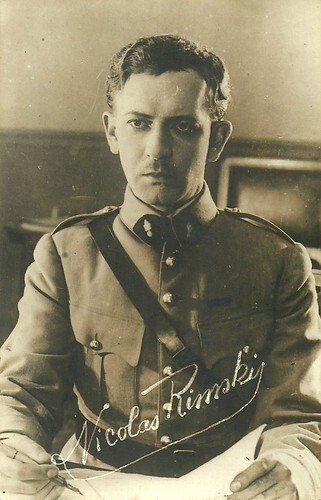
French postcard. Nicolas Rimsky probably in the Albatros producton Calvaire d'amour (Viktor Tourjansky, 1923).

French postcard, with names written in Russian. Nathalie Lissenko , Nicolas Koline and Nicolas Rimsky in the Albatros producton Calvaire d'amour (Viktor Tourjansky, 1923).
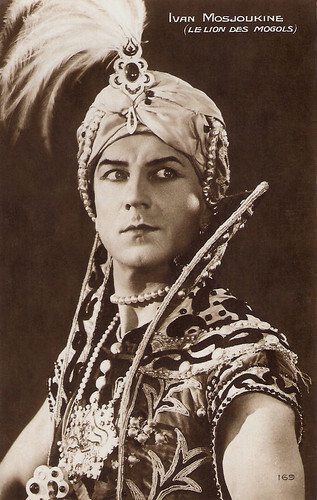
French postcard by Cinémagazine no. 169. Ivan Mozzhukhin played the male lead of Prince Roundghito-Sing in the Albatross production Le lion des Mogols/The Lion of the Moguls (Jean Epstein, 1924). While the Moghol empire is falling apart, Prince Roundghito-Sing decides to leave and make films in Paris, where he falls for the attractions of the city.
Upright in the storm
Films Albatros was a French film production company established in 1922. It was formed by a group of White Russian exiles who had been forced to flee following the 1917 Russian Revolution and subsequent Russian Civil War. Initially, the firm's personnel consisted mainly of Russian exiles, but over time French actors and directors were employed by the company too. Its operations continued until the late 1930s. Faced with increasingly difficult working conditions in Russia after the revolution of 1917, the film producer Joseph Ermolieff decided to move his operations to Paris where he had connections with the Pathé company.
Arriving in 1920 with a group of close associates, Ermolieff took over a studio in Montreuil-sous-Bois in the eastern suburbs of Paris and began making films through his company Ermolieff-Cinéma. His co-founder of the company was Alexandre Kamenka, another Russian exile. In 1922 Ermolieff moved to Germany. Kamenka and his colleagues Noë Bloch and Maurice Hache decided to take over the company. They re-established it as the Société des Films Albatros. Kamenka also set up a distribution company called Les Films Armor in order to control the distribution of his own films. Various explanations have been given for the choice of the name Albatros. Was it the name of a boat which brought some of the émigrés from Russia? Was it a symbol of White Russia? Did an incident with an albatross happen on the journey? As well as adopting the image of the albatross as its symbol, the company took the motto 'Debout dans la tempête' (Upright in the storm).
Among the group of Russian artists who stayed to work with Albatros were the directors Victor Tourjansky and Alexandre Volkoff, the art director Alexandre Lochakoff, the costume designer Boris Bilinsky, and the actors Ivan Mozzhukhin (in French Ivan Mosjoukine and in German Iwan Mosjukin), Nathalie Lissenko , Nicolas Koline , and Nicolas Rimsky . Although this Russian company initially favoured Russian themes, Kamenka quickly realised the need for greater integration with French film production, and they turned increasingly to French subjects. In 1924 a number of Kamenka's Russian associates left Albatros, and Kamenka offered opportunities to several innovative French filmmakers including Jean Epstein, Jacques Feyder, Marcel L'Herbier and René Clair.
Kamenka's production policy combined prestige projects with openly commercial films, and his consistent record made him the most successful French producer during the 1920s, according to Charles Spaak, who came to the company as a scriptwriter in 1928. Kamenka successfully achieved international distribution for many of his films - even in Soviet Russia with which his company had so little political sympathy. From 1927, he entered into co-production arrangements with production companies in other European countries, driven by growing financial difficulties in the French film industry.
The arrival of sound pictures posed a serious difficulty for Albatros which had hitherto relied considerably upon Russian actors, especially Mozzhukhin whose accent precluded a successful transition into the talking era. The company's output diminished in the 1930s, but it achieved one further artistic success of note when Jean Renoir joined them for his adaptation of Maxim Gorky's Les Bas-fonds/The Lower Depths (1936). By this time, Albatros was the longest surviving film company operating in France, but with the outbreak of World War II, Kamenka wound up the company which had remained particularly associated with silent cinema.
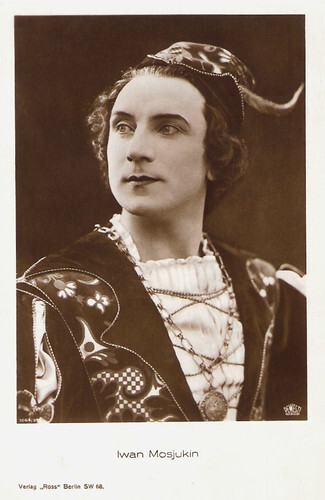
German postcard by Ross Verlag, no. 1064/3, 1927-1928. Photo: DeWesti Film-Verleih. Ivan Mozzhukhin in the Albatros production Kean (Alexandre Volkoff, 1924).
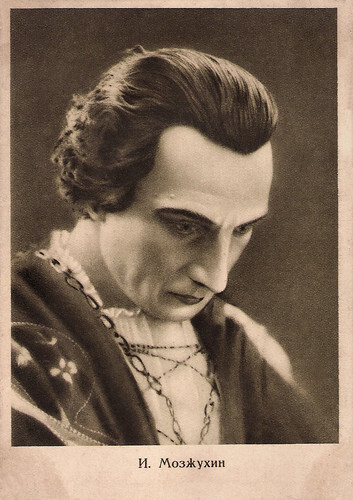
Russian postcard by Goznak, Moscow, Serie no. 5, no. A 4711, 1928. The card was issued in an edition of 25.000 copies. The price was 10 Kop. Photo: Ivan Mozzhukhin in Kean/Edmund Kean: Prince Among Lovers (Alexandre Volkoff, 1924).
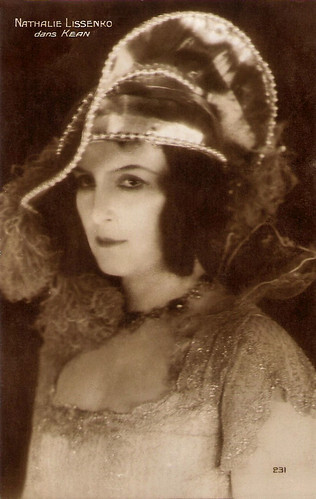
French postcard by Cinémagazine Editions, no. 231. Photo: Nathalie Lissenko in Kean/Edmund Kean (Alexandre Volkoff a.k.a. Alexander Volkov, 1924).
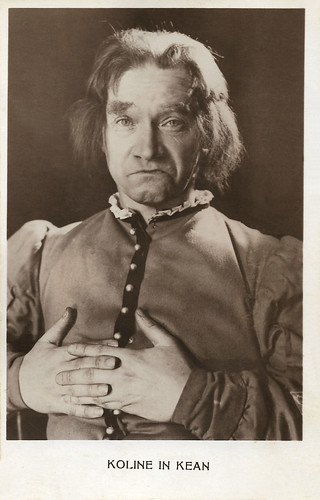
German postcard. Photo: Nicolas Koline in Kean/Edmund Kean: Prince Among Lovers (Alexandre Volkoff a.k.a. Alexander Volkov, 1924).
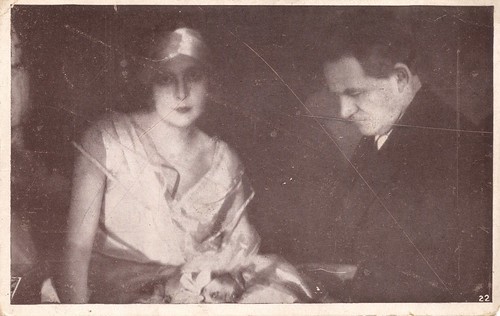
Belgian postcard. Nathalie Kovanko and Nicolas Koline in the Albatros production La dame masquée (Viktor Tourjansky 1924).
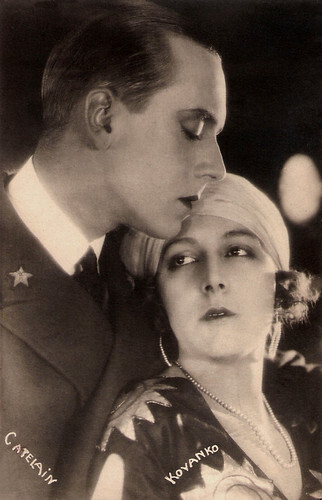
French postcard. Jaque Catelain and Nathalie Kovanko in Le prince charmant/Prince Charming (Viktor Tourjansky, 1925).
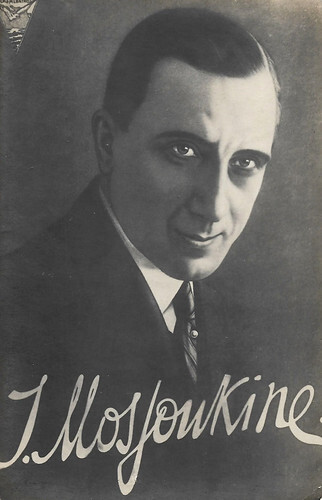
French or Romanian postcard. Photo: Albatros Films. Ivan Mozzhukhin .
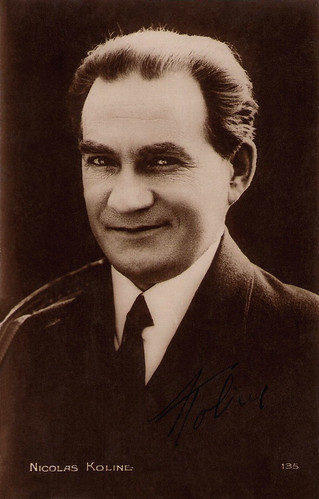
French postcard by Cinémagazine Editions, no. 135. Nicolas Koline .
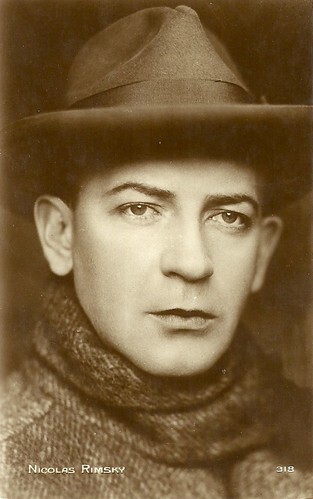
French postcard by Editions Cinémagazine, no. 318. Nicolas Rimsky.
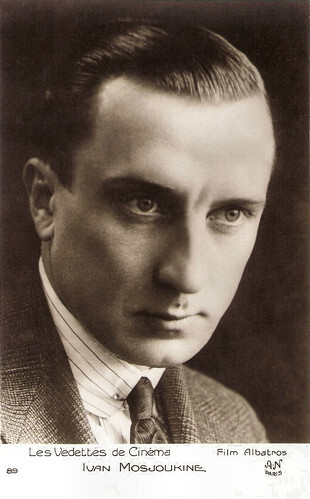
French postcard in the Les Vedettes de Cinéma series by A.N., Paris, no. 89. Photo: Film Albatros. Ivan Mozzhukhin .
Sources: Il Cinema Ritrovato, Wikipedia (English and French) and .

German postcard by Ross Verlag. no. 1064/1. Photo: DeWesti Film-Verleih. Ivan Mozzhukhin in Kean/Edmund Kean: Prince Among Lovers (Alexandre Volkoff, 1924).

Romanian postcard. Nathalie Kovanko in Le chant de l'amour triomphant/The song of triumphant love (Viktor Tourjansky, 1923).

French postcard. Nicolas Rimsky probably in the Albatros producton Calvaire d'amour (Viktor Tourjansky, 1923).

French postcard, with names written in Russian. Nathalie Lissenko , Nicolas Koline and Nicolas Rimsky in the Albatros producton Calvaire d'amour (Viktor Tourjansky, 1923).

French postcard by Cinémagazine no. 169. Ivan Mozzhukhin played the male lead of Prince Roundghito-Sing in the Albatross production Le lion des Mogols/The Lion of the Moguls (Jean Epstein, 1924). While the Moghol empire is falling apart, Prince Roundghito-Sing decides to leave and make films in Paris, where he falls for the attractions of the city.
Upright in the storm
Films Albatros was a French film production company established in 1922. It was formed by a group of White Russian exiles who had been forced to flee following the 1917 Russian Revolution and subsequent Russian Civil War. Initially, the firm's personnel consisted mainly of Russian exiles, but over time French actors and directors were employed by the company too. Its operations continued until the late 1930s. Faced with increasingly difficult working conditions in Russia after the revolution of 1917, the film producer Joseph Ermolieff decided to move his operations to Paris where he had connections with the Pathé company.
Arriving in 1920 with a group of close associates, Ermolieff took over a studio in Montreuil-sous-Bois in the eastern suburbs of Paris and began making films through his company Ermolieff-Cinéma. His co-founder of the company was Alexandre Kamenka, another Russian exile. In 1922 Ermolieff moved to Germany. Kamenka and his colleagues Noë Bloch and Maurice Hache decided to take over the company. They re-established it as the Société des Films Albatros. Kamenka also set up a distribution company called Les Films Armor in order to control the distribution of his own films. Various explanations have been given for the choice of the name Albatros. Was it the name of a boat which brought some of the émigrés from Russia? Was it a symbol of White Russia? Did an incident with an albatross happen on the journey? As well as adopting the image of the albatross as its symbol, the company took the motto 'Debout dans la tempête' (Upright in the storm).
Among the group of Russian artists who stayed to work with Albatros were the directors Victor Tourjansky and Alexandre Volkoff, the art director Alexandre Lochakoff, the costume designer Boris Bilinsky, and the actors Ivan Mozzhukhin (in French Ivan Mosjoukine and in German Iwan Mosjukin), Nathalie Lissenko , Nicolas Koline , and Nicolas Rimsky . Although this Russian company initially favoured Russian themes, Kamenka quickly realised the need for greater integration with French film production, and they turned increasingly to French subjects. In 1924 a number of Kamenka's Russian associates left Albatros, and Kamenka offered opportunities to several innovative French filmmakers including Jean Epstein, Jacques Feyder, Marcel L'Herbier and René Clair.
Kamenka's production policy combined prestige projects with openly commercial films, and his consistent record made him the most successful French producer during the 1920s, according to Charles Spaak, who came to the company as a scriptwriter in 1928. Kamenka successfully achieved international distribution for many of his films - even in Soviet Russia with which his company had so little political sympathy. From 1927, he entered into co-production arrangements with production companies in other European countries, driven by growing financial difficulties in the French film industry.
The arrival of sound pictures posed a serious difficulty for Albatros which had hitherto relied considerably upon Russian actors, especially Mozzhukhin whose accent precluded a successful transition into the talking era. The company's output diminished in the 1930s, but it achieved one further artistic success of note when Jean Renoir joined them for his adaptation of Maxim Gorky's Les Bas-fonds/The Lower Depths (1936). By this time, Albatros was the longest surviving film company operating in France, but with the outbreak of World War II, Kamenka wound up the company which had remained particularly associated with silent cinema.

German postcard by Ross Verlag, no. 1064/3, 1927-1928. Photo: DeWesti Film-Verleih. Ivan Mozzhukhin in the Albatros production Kean (Alexandre Volkoff, 1924).

Russian postcard by Goznak, Moscow, Serie no. 5, no. A 4711, 1928. The card was issued in an edition of 25.000 copies. The price was 10 Kop. Photo: Ivan Mozzhukhin in Kean/Edmund Kean: Prince Among Lovers (Alexandre Volkoff, 1924).

French postcard by Cinémagazine Editions, no. 231. Photo: Nathalie Lissenko in Kean/Edmund Kean (Alexandre Volkoff a.k.a. Alexander Volkov, 1924).

German postcard. Photo: Nicolas Koline in Kean/Edmund Kean: Prince Among Lovers (Alexandre Volkoff a.k.a. Alexander Volkov, 1924).

Belgian postcard. Nathalie Kovanko and Nicolas Koline in the Albatros production La dame masquée (Viktor Tourjansky 1924).

French postcard. Jaque Catelain and Nathalie Kovanko in Le prince charmant/Prince Charming (Viktor Tourjansky, 1925).

French or Romanian postcard. Photo: Albatros Films. Ivan Mozzhukhin .

French postcard by Cinémagazine Editions, no. 135. Nicolas Koline .

French postcard by Editions Cinémagazine, no. 318. Nicolas Rimsky.

French postcard in the Les Vedettes de Cinéma series by A.N., Paris, no. 89. Photo: Film Albatros. Ivan Mozzhukhin .
Sources: Il Cinema Ritrovato, Wikipedia (English and French) and .
Published on June 30, 2023 22:00
June 29, 2023
Anna Magnani
Perhaps the greatest, certainly the most admired and imitated – not only was Anna Magnani unique, but she was also a model of acting style and an Italian icon. At Il Cinema Ritrovato 2023, Emiliano Morreale curated 'Anna Magnani, the One and Only'. After first presenting herself as a brilliant actress – thanks to the triumph of Rome, Open City – she subsequently diversified from the many incarnations of her popular Roman character to play very different roles, such as those in Jean Renoir’s The Golden Coach or the monodrama The Human Voice (an episode in Roberto Rossellini’s L’Amore), to finally arriving in Hollywood and winning an Oscar for The Rose Tattoo. Her image was somewhat eccentric, amid the glamour of the 1950s and her golden moment lasted just over ten years, but an actress such as Magnani is unimaginable today. The legacy and unattainable model of Anna Magnani continue to inspire actresses in Italy and beyond.
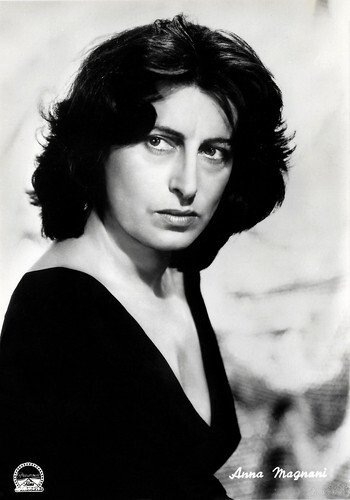
Italian postcard by Bromofoto, Milano, no. 1504. Photo: Paramount.
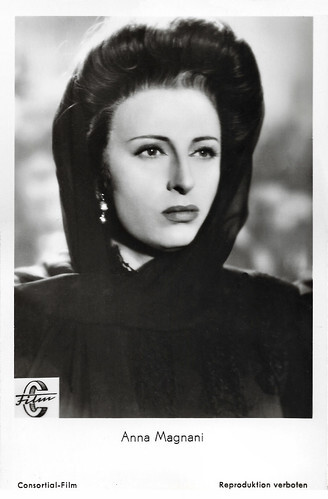
West German postcard by F.J. Rüdel, Filmpostkartenverlag, Hamburg-Bergedorf, no. 291. Photo: Consortial-Film. Anna Magnani in Assunta Spina (Mario Mattoli, 1948). In Germany, the film was titled Die Gezeichnete.
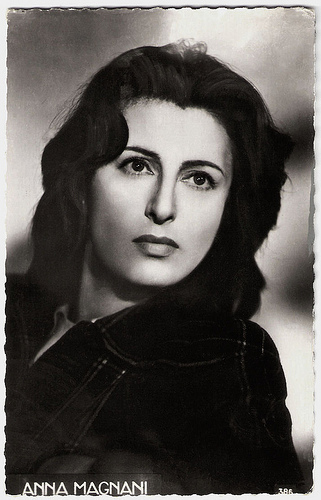
French postcard by Editions P.I., Paris, no. 386.
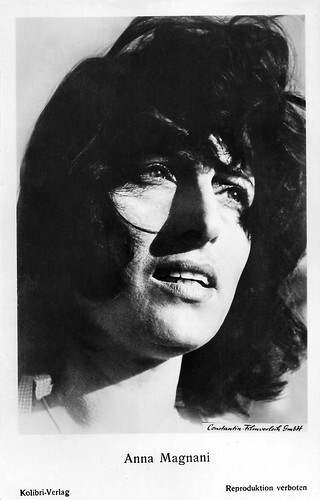
West-German postcard by Kolibri-Verlag. Photo: Constantin Film-Verleih GmbH. Anna Magnani in Vulcano (William Dieterle, 1950).
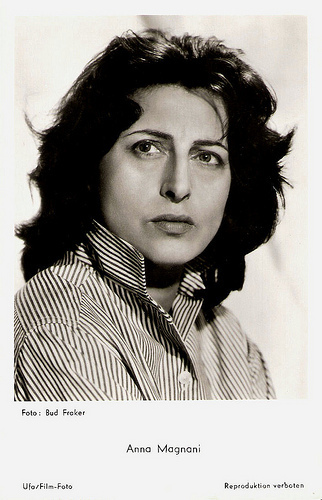
German postcard by Ufa, Berlin-Tempelhof, no. FK 4136. Photo: Bud Fraker. Anna Magnani in The Rose Tattoo (Daniel Mann, 1955).
The Italian Edith Piaf
Anna Magnani was born in Rome in 1908. She was the illegitimate child of Marina Magnani and an unknown father, whom Anna herself claimed was from the Calabria region of Italy (according to Wikipedia he was called Francesco Del Duce). She was raised by her maternal grandmother in a slum district of Rome after her mother left her.
At 14, she enrolled in a French convent school in Rome, where, she learned to speak French and play piano. She also developed a passion for acting from watching the nuns stage their Christmas play. At age 17, she went on to study at Santa Cecilia's Corso Eleanora Duse (the Eleanora Duse Royal Academy of Dramatic Art) in Rome. To support herself, Magnani sang bawdy Roman songs in nightclubs and cabarets leading to her being dubbed ‘the Italian Edith Piaf’.
She began touring the countryside with small repertory companies and had a small role in the silent film Scampolo (Augusto Genina, 1928) starring Carmen Boni . In 1933 she was acting in experimental plays in Rome when she was discovered by Italian filmmaker Goffredo Alessandrini. She played in La Cieca di Sorrento/The Blind Woman of Sorrento (Nunzio Malasomma, 1934). They married in 1933, shortly before the film was released. Magnani retired from full-time acting to devote herself exclusively to her husband, although she continued to play smaller film parts.
Under Alessandrini, she next appeared in Cavalleria/Cavalry (Goffredo Alessandrini, 1936) with Amedeo Nazzari , followed by La Principessa Tarakanova/Betrayal (Fyodor Otsep, Mario Soldati, 1938) featuring Annie Vernay . Alessandrini and Magnani separated in 1942 and finally divorced in 1950. After their separation her son Luca was born, the result of a brief affair with Italian matinée idol Massimo Serato. Magnani's life was struck by tragedy when Luca came down with crippling polio at only 18 months of age. He never regained the use of his legs. As a result, she spent most of her early earnings on specialists and hospitals.
In 1941, Magnani played the second female lead in the comedy of errors Teresa Venerdì/Do You Like Women (Vittorio De Sica, 1941) which writer-director Vittorio De Sica called Magnani’s ‘first true film’. In it, she plays Loletta Prima, the girlfriend of Di Sica’s character, Pietro Vignali. But her international breakthrough role had still to come.
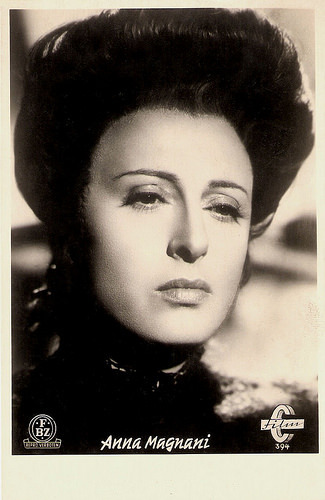
German postcard by FBZ, no. 394. Photo: Cfilm. Anna Magnani in Assunta Spina (Mario Mattoli, 1948).
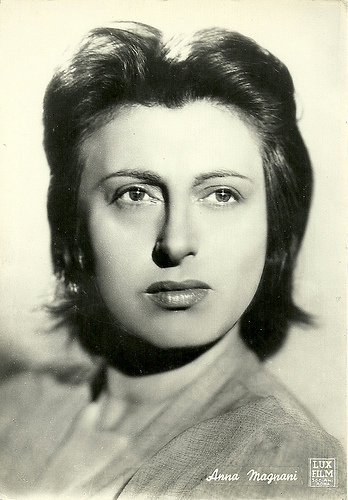
Italian postcard by Bromofoto, Milano, no. 104. Photo: Lux Film, Rome.
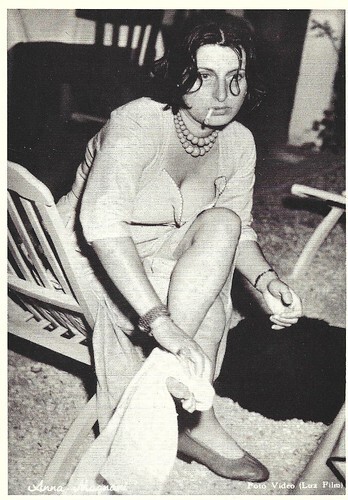
Vintage postcard in the Moviestar series. Photo: Video (Lux Film).
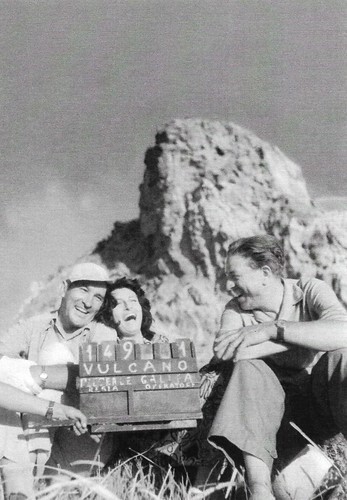
Vintage postcard by Liceo Artistico statale di Venezia / Panaria Film. Photo by Fosco Maraini. Anna Magnani and director William Dieterle in between the takes of the Italian film Vulcano (William Dieterle, 1950), shot in 1949. The man on the right could be producer Renzo Avanzo. The card was released by Panaria Film on the occasion of the preservation of the film in 2007.
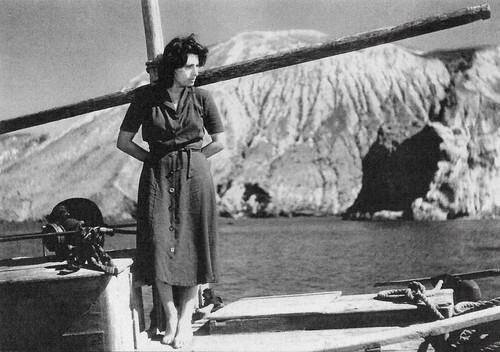
Italian postcard by Liceo Artistico statale di Venezia, 2007. Photo: Fosco Maraini. Anna Magnani in Vulcano (William Dieterle, 1950). Caption: Anna Magnani, with the island of Vulcano in the background.
One of cinema's most devastating moments
Anna Magnani’s film career had spread over 18 years before she gained international renown as Pina in the neorealist milestone Roma, città aperta/Rome, Open City (Roberto Rossellini, 1945) about the final days of the Nazi occupation of Rome.
Magnani gave a brilliant performance as a woman who dies fighting to protect her husband, an underground fighter against the Nazis. Her harrowing death scene remains one of cinema's most devastating moments.
It established her as a star, although she lacked the conventional beauty and glamour often associated with the term. Slightly plump and rather short in stature with a face framed by unkempt raven hair and eyes encircled by deep, dark shadows, she smouldered with seething earthiness and volcanic temperament.
Roberto Rossellini was her lover at the time, and she collaborated with him on other films, including L'Amore/Love (Roberto Rossellini, 1948) a two-part film including Il miracolo/The Miracle and Una voce umana/The Human Voice. In the former, she played a pregnant outcast peasant who was seduced by a stranger and comes to believe the child she subsequently carries is Christ. Magnani plumbs both the sorrow and the righteousness of being alone in the world. The latter film is based on Jean Cocteau 's play about a woman desperately trying to salvage a relationship over the telephone. It is remarkable for the ways in which Magnani's powerful moments of silence segue into cries of despair.
Rossellini promised to direct her again in Stromboli, the next film he was preparing. However, when the screenplay was completed, he gave the role to Ingrid Bergman . This and his affair with the Swedish Hollywood star caused Magnani's breakup with Rossellini. As a result, she took on the starring role of Volcano/Vulcano (William Dieterle, 1949) with Rossano Brazzi , which was deliberately produced to invite comparison.
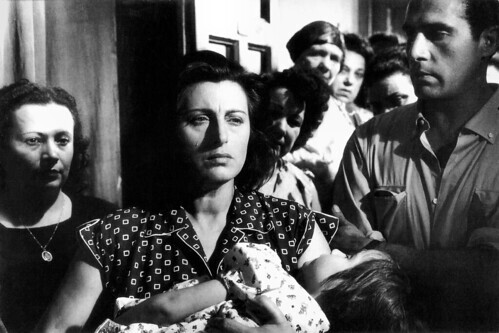
Italian postcard Marsilio Edizioni di Bianco & Nero. Photo: Paul Ronald. Anna Magnani in Bellissima (Luchino Visconti, 1951).
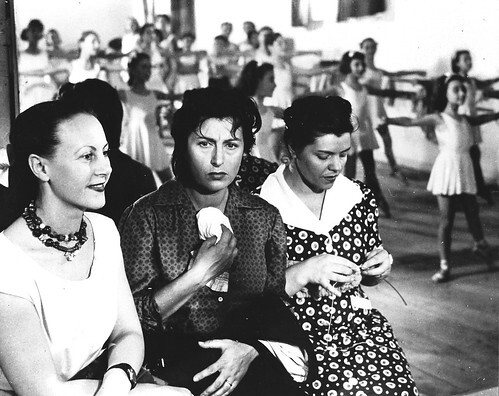
Reproduction of press photo. Photo: Paul Ronald. Anna Magnani in Bellissima (Luchino Visconti, 1951).
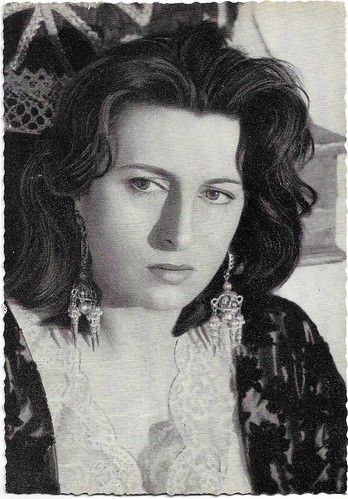
German film card by Filmbilder-Filmvertrieb Ernst Freihoff, Essen, no. 100. Photo: Dial / Unitalia Film. Anna Magnani as Camilla in the comedy La carrozza d'oro/ La carrosse d'or/The Golden Coach (Jean Renoir, 1952).
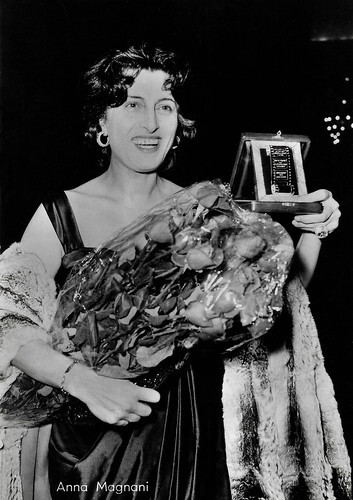
Italian postcard, no. 195. In 1957, Anna Magnani received the Nastri d'Argento (Silver Ribbon) award for Best Actress in a Leading Role for the film Suor Letizia/When Angels Don't Fly (Mario Camerini, 1956).
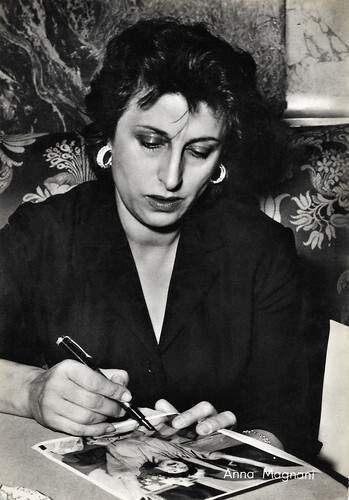
Italian postcard by Bromostampa, Milano, no. 110.
Prostitutes and suffering mothers
In 1950, Life magazine stated that Anna Magnani was "one of the most impressive actresses since Garbo." In Bellissima (Luchino Visconti, 1951) she played Maddalena, a blustery, obstinate stage mother who drags her daughter to Cinecittà for the 'Prettiest Girl in Rome' contest, with dreams that her plain daughter will be a star. Her emotions in the film went from those of rage and humiliation to maternal love. She later starred as Camille, a commedia dell'arte actress torn between three men, a soldier, a bullfighter, and a viceroy, in Le Carrosse d'or/The Golden Coach (Jean Renoir, 1953).
In Hollywood, she starred opposite Burt Lancaster as Serafina, the widowed mother of a teenage daughter in The Rose Tattoo (Daniel Mann, 1955). Screenwriter and close friend Tennessee Williams based the character of Serafina on Magnani. He even stipulated that the film must star Magnani. It was Magnani's first English-speaking role in a mainstream Hollywood movie, winning her the Academy Award, the BAFTA, the Golden Globe and the New York Film Critics Circle Award for Best Actress. Magnani worked with Tennessee Williams again on The Fugitive Kind (Sidney Lumet, 1959), co-starring with Marlon Brando . In Hollywood she also appeared in Wild is the Wind (George Cukor, 1957), for which she was again nominated for the Academy Award.
In Italy, she played strong-willed prostitutes and suffering mothers in such films as the women-in-prison drama Nella città l'inferno/The Wild, Wild Women (Renato Castellani, 1958) with Giulietta Masina , and Mamma Roma (Pier Paolo Pasolini, 1962). In Mama Roma Magnani is both the mother and the whore, playing an irrepressible prostitute determined to give her teenage son a respectable middle-class life. It was controversial but also one of Magnani's most critically acclaimed films.
In this later period of her career, she also appeared on Italian television and acted on the stage, most notably in 1965 when she starred in 'La Lupa' (She-Wolf), directed by Franco Zeffirelli, and in 1966 when she played the lead in Jean Anouilh's 'Medea', directed by Gian Carlo Menotti. In the film comedy The Secret of Santa Vittoria (Stanley Kramer, 1969), she co-starred with Anthony Quinn as a fighting husband and wife. Magnani and Quinn did also feud in private and their animosity spilled over into their scenes. Reportedly she bit Quinn in the neck and kicked him so hard that she broke a bone in her right foot. Her final screen performance was a cameo in Fellini's Roma (Federico Fellini, 1972).
In 1973, Anna Magnani died at the age of 65 in Rome, after a long battle with pancreatic cancer. Her son Luca and her favourite director Roberto Rossellini were at her bedside. With Rossellini, she'd patched up her disagreements some years before. It was reported that an enormous crowd turned out for her funeral in Italy, in a final public salute that is more typically reserved for Popes.
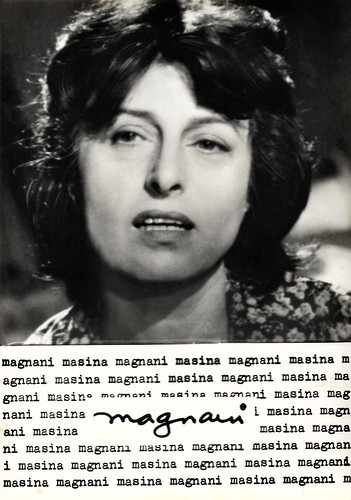
Italian postcard La Rotografica Romana. Photo: Anna Magnani in Nella città l'inferno/Caged (Renato Castellani, 1959).
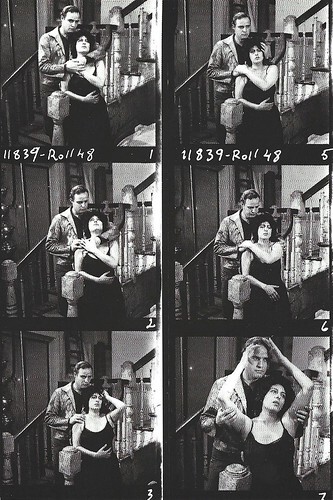
Vintage postcard by News Productions, Switzerland/Germany/UK. Photos: Sam Shaw. Anna Magnani and Marlon Brando in The Fugitive Kind (Sidney Lumet, 1960).
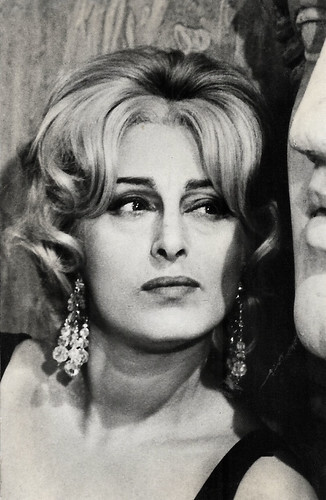
Czech collectors card by Pressfoto, Praha (Prague), no. S 37/2, 1964. Anna Magnani in Risate de Gioia/The Passionate Thief (Mario Monicelli, 1960).
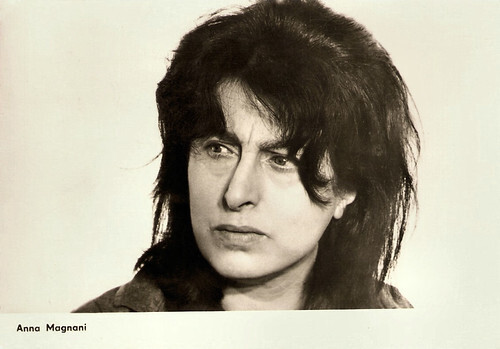
East-German postcard by VEB Progress Film-Vertrieb, Berlin, no. 2823, 1967. Sent by mail in East Germany in 1974. Anna Magnani in Mamma Roma (Pier Paolo Pasolini, 1962).
Scene from The Rose Tattoo (1953). Source: The SuppActress (YouTube).
Anna Magnani sings Scapricciatiello in Wild is the Wind (1957). Source: Minuit (YouTube).
Sources: Il Cinema Ritrovato 2023, Jason Ankeny (All Movie), (IMDb), Answers.com, Wikipedia and .

Italian postcard by Bromofoto, Milano, no. 1504. Photo: Paramount.

West German postcard by F.J. Rüdel, Filmpostkartenverlag, Hamburg-Bergedorf, no. 291. Photo: Consortial-Film. Anna Magnani in Assunta Spina (Mario Mattoli, 1948). In Germany, the film was titled Die Gezeichnete.

French postcard by Editions P.I., Paris, no. 386.

West-German postcard by Kolibri-Verlag. Photo: Constantin Film-Verleih GmbH. Anna Magnani in Vulcano (William Dieterle, 1950).

German postcard by Ufa, Berlin-Tempelhof, no. FK 4136. Photo: Bud Fraker. Anna Magnani in The Rose Tattoo (Daniel Mann, 1955).
The Italian Edith Piaf
Anna Magnani was born in Rome in 1908. She was the illegitimate child of Marina Magnani and an unknown father, whom Anna herself claimed was from the Calabria region of Italy (according to Wikipedia he was called Francesco Del Duce). She was raised by her maternal grandmother in a slum district of Rome after her mother left her.
At 14, she enrolled in a French convent school in Rome, where, she learned to speak French and play piano. She also developed a passion for acting from watching the nuns stage their Christmas play. At age 17, she went on to study at Santa Cecilia's Corso Eleanora Duse (the Eleanora Duse Royal Academy of Dramatic Art) in Rome. To support herself, Magnani sang bawdy Roman songs in nightclubs and cabarets leading to her being dubbed ‘the Italian Edith Piaf’.
She began touring the countryside with small repertory companies and had a small role in the silent film Scampolo (Augusto Genina, 1928) starring Carmen Boni . In 1933 she was acting in experimental plays in Rome when she was discovered by Italian filmmaker Goffredo Alessandrini. She played in La Cieca di Sorrento/The Blind Woman of Sorrento (Nunzio Malasomma, 1934). They married in 1933, shortly before the film was released. Magnani retired from full-time acting to devote herself exclusively to her husband, although she continued to play smaller film parts.
Under Alessandrini, she next appeared in Cavalleria/Cavalry (Goffredo Alessandrini, 1936) with Amedeo Nazzari , followed by La Principessa Tarakanova/Betrayal (Fyodor Otsep, Mario Soldati, 1938) featuring Annie Vernay . Alessandrini and Magnani separated in 1942 and finally divorced in 1950. After their separation her son Luca was born, the result of a brief affair with Italian matinée idol Massimo Serato. Magnani's life was struck by tragedy when Luca came down with crippling polio at only 18 months of age. He never regained the use of his legs. As a result, she spent most of her early earnings on specialists and hospitals.
In 1941, Magnani played the second female lead in the comedy of errors Teresa Venerdì/Do You Like Women (Vittorio De Sica, 1941) which writer-director Vittorio De Sica called Magnani’s ‘first true film’. In it, she plays Loletta Prima, the girlfriend of Di Sica’s character, Pietro Vignali. But her international breakthrough role had still to come.

German postcard by FBZ, no. 394. Photo: Cfilm. Anna Magnani in Assunta Spina (Mario Mattoli, 1948).

Italian postcard by Bromofoto, Milano, no. 104. Photo: Lux Film, Rome.

Vintage postcard in the Moviestar series. Photo: Video (Lux Film).

Vintage postcard by Liceo Artistico statale di Venezia / Panaria Film. Photo by Fosco Maraini. Anna Magnani and director William Dieterle in between the takes of the Italian film Vulcano (William Dieterle, 1950), shot in 1949. The man on the right could be producer Renzo Avanzo. The card was released by Panaria Film on the occasion of the preservation of the film in 2007.

Italian postcard by Liceo Artistico statale di Venezia, 2007. Photo: Fosco Maraini. Anna Magnani in Vulcano (William Dieterle, 1950). Caption: Anna Magnani, with the island of Vulcano in the background.
One of cinema's most devastating moments
Anna Magnani’s film career had spread over 18 years before she gained international renown as Pina in the neorealist milestone Roma, città aperta/Rome, Open City (Roberto Rossellini, 1945) about the final days of the Nazi occupation of Rome.
Magnani gave a brilliant performance as a woman who dies fighting to protect her husband, an underground fighter against the Nazis. Her harrowing death scene remains one of cinema's most devastating moments.
It established her as a star, although she lacked the conventional beauty and glamour often associated with the term. Slightly plump and rather short in stature with a face framed by unkempt raven hair and eyes encircled by deep, dark shadows, she smouldered with seething earthiness and volcanic temperament.
Roberto Rossellini was her lover at the time, and she collaborated with him on other films, including L'Amore/Love (Roberto Rossellini, 1948) a two-part film including Il miracolo/The Miracle and Una voce umana/The Human Voice. In the former, she played a pregnant outcast peasant who was seduced by a stranger and comes to believe the child she subsequently carries is Christ. Magnani plumbs both the sorrow and the righteousness of being alone in the world. The latter film is based on Jean Cocteau 's play about a woman desperately trying to salvage a relationship over the telephone. It is remarkable for the ways in which Magnani's powerful moments of silence segue into cries of despair.
Rossellini promised to direct her again in Stromboli, the next film he was preparing. However, when the screenplay was completed, he gave the role to Ingrid Bergman . This and his affair with the Swedish Hollywood star caused Magnani's breakup with Rossellini. As a result, she took on the starring role of Volcano/Vulcano (William Dieterle, 1949) with Rossano Brazzi , which was deliberately produced to invite comparison.

Italian postcard Marsilio Edizioni di Bianco & Nero. Photo: Paul Ronald. Anna Magnani in Bellissima (Luchino Visconti, 1951).

Reproduction of press photo. Photo: Paul Ronald. Anna Magnani in Bellissima (Luchino Visconti, 1951).

German film card by Filmbilder-Filmvertrieb Ernst Freihoff, Essen, no. 100. Photo: Dial / Unitalia Film. Anna Magnani as Camilla in the comedy La carrozza d'oro/ La carrosse d'or/The Golden Coach (Jean Renoir, 1952).

Italian postcard, no. 195. In 1957, Anna Magnani received the Nastri d'Argento (Silver Ribbon) award for Best Actress in a Leading Role for the film Suor Letizia/When Angels Don't Fly (Mario Camerini, 1956).

Italian postcard by Bromostampa, Milano, no. 110.
Prostitutes and suffering mothers
In 1950, Life magazine stated that Anna Magnani was "one of the most impressive actresses since Garbo." In Bellissima (Luchino Visconti, 1951) she played Maddalena, a blustery, obstinate stage mother who drags her daughter to Cinecittà for the 'Prettiest Girl in Rome' contest, with dreams that her plain daughter will be a star. Her emotions in the film went from those of rage and humiliation to maternal love. She later starred as Camille, a commedia dell'arte actress torn between three men, a soldier, a bullfighter, and a viceroy, in Le Carrosse d'or/The Golden Coach (Jean Renoir, 1953).
In Hollywood, she starred opposite Burt Lancaster as Serafina, the widowed mother of a teenage daughter in The Rose Tattoo (Daniel Mann, 1955). Screenwriter and close friend Tennessee Williams based the character of Serafina on Magnani. He even stipulated that the film must star Magnani. It was Magnani's first English-speaking role in a mainstream Hollywood movie, winning her the Academy Award, the BAFTA, the Golden Globe and the New York Film Critics Circle Award for Best Actress. Magnani worked with Tennessee Williams again on The Fugitive Kind (Sidney Lumet, 1959), co-starring with Marlon Brando . In Hollywood she also appeared in Wild is the Wind (George Cukor, 1957), for which she was again nominated for the Academy Award.
In Italy, she played strong-willed prostitutes and suffering mothers in such films as the women-in-prison drama Nella città l'inferno/The Wild, Wild Women (Renato Castellani, 1958) with Giulietta Masina , and Mamma Roma (Pier Paolo Pasolini, 1962). In Mama Roma Magnani is both the mother and the whore, playing an irrepressible prostitute determined to give her teenage son a respectable middle-class life. It was controversial but also one of Magnani's most critically acclaimed films.
In this later period of her career, she also appeared on Italian television and acted on the stage, most notably in 1965 when she starred in 'La Lupa' (She-Wolf), directed by Franco Zeffirelli, and in 1966 when she played the lead in Jean Anouilh's 'Medea', directed by Gian Carlo Menotti. In the film comedy The Secret of Santa Vittoria (Stanley Kramer, 1969), she co-starred with Anthony Quinn as a fighting husband and wife. Magnani and Quinn did also feud in private and their animosity spilled over into their scenes. Reportedly she bit Quinn in the neck and kicked him so hard that she broke a bone in her right foot. Her final screen performance was a cameo in Fellini's Roma (Federico Fellini, 1972).
In 1973, Anna Magnani died at the age of 65 in Rome, after a long battle with pancreatic cancer. Her son Luca and her favourite director Roberto Rossellini were at her bedside. With Rossellini, she'd patched up her disagreements some years before. It was reported that an enormous crowd turned out for her funeral in Italy, in a final public salute that is more typically reserved for Popes.

Italian postcard La Rotografica Romana. Photo: Anna Magnani in Nella città l'inferno/Caged (Renato Castellani, 1959).

Vintage postcard by News Productions, Switzerland/Germany/UK. Photos: Sam Shaw. Anna Magnani and Marlon Brando in The Fugitive Kind (Sidney Lumet, 1960).

Czech collectors card by Pressfoto, Praha (Prague), no. S 37/2, 1964. Anna Magnani in Risate de Gioia/The Passionate Thief (Mario Monicelli, 1960).

East-German postcard by VEB Progress Film-Vertrieb, Berlin, no. 2823, 1967. Sent by mail in East Germany in 1974. Anna Magnani in Mamma Roma (Pier Paolo Pasolini, 1962).
Scene from The Rose Tattoo (1953). Source: The SuppActress (YouTube).
Anna Magnani sings Scapricciatiello in Wild is the Wind (1957). Source: Minuit (YouTube).
Sources: Il Cinema Ritrovato 2023, Jason Ankeny (All Movie), (IMDb), Answers.com, Wikipedia and .
Published on June 29, 2023 22:00
June 28, 2023
Tribute to Suso Cecchi d’Amico
Over the course of a career that began at the time of the birth of neorealism and lasted more than 60 years, Suso Cecchi d’Amico worked on the screenplays of more than 120 films (mainly, but not exclusively, Italian) directed by both newcomers and established directors. Il Cinema Ritrovato 2023 presents a tribute to her, curated by her children, Masolino, Silvia and Caterina d’Amico. Suso Cecchi d’Amico's aim was never to impose her own ideas but to understand and support the projects and poetics of the authors with whom she worked. On the other hand, like any artist, she clearly possessed her own voice and personality, which this section proposes to trace through films that are very different in tone, genre and language. It is certainly a partial but undoubtedly fascinating selection, presenting significant works chosen from a rich and heterogeneous filmography that few other screenwriters can boast. For this post, Ivo Blom selected a series of postcards and stills of her films and wrote the text for this post for which he used an interview he had with her in 2004.
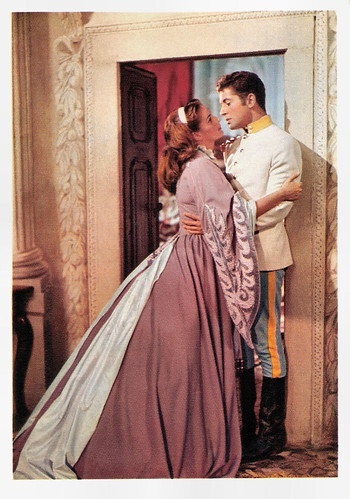
Italian postcard by Rotocalco Dagnino, Torino. Photo: Lux Film. Alida Valli as Countess Livia Serpieri and Farley Granger as Lt. Franz Mahler in Luchino Visconti's historical film Senso (1954).
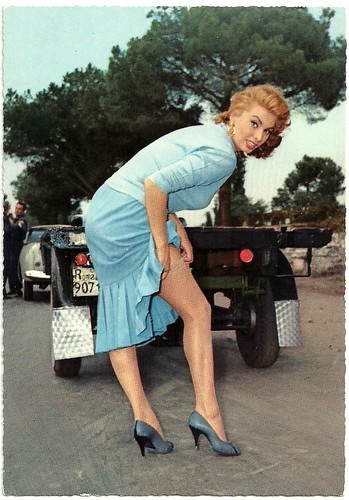
German postcard. Photo Ufa. Sophia Loren in La fortuna di essere donna/What a Woman! (Alessandro Blasetti, 1956).
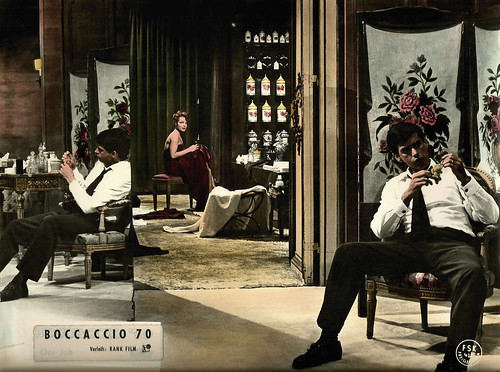
Publicity still used in Germany, distributed by Rank, the mark of the German censor FSK. Thomas Milian and Romy Schneider in Luchino Visconti 's episode Il Lavoro in the episode film Boccaccio 70 (1962).
First screenplay
Suso Cecchi D’Amico, pseudonym of Giovanna Cecchi D'Amico, was born in Rome in 1914 to Tuscan parents: the writer Emilio Cecchi (from whom she took her birth name Cecchi) and the painter Leonetta Pieraccini. After finishing the Lycée Chateaubriand in Rome, she did not enrol at university, as she had not taken a diploma in Latin and Greek. 'To continue my studies I could only enrol in one or two faculties, such as botany, which frankly did not interest me'. After a stay abroad, in Switzerland and England, she decided to get a job. Thanks to the intervention of Minister Giuseppe Bottai, "the only hierarch who had any relationship with intellectuals", she was hired at the Ministry of Corporations, later the Ministry of Trade and Currency, where she worked for almost seven years as personal secretary to Eugenio Anzilotti, Director General of Foreign Trade.
In 1938 she married musicologist Fedele D'Amico, Silvio's son, by whom she had three children: Masolino, Silvia and Caterina, who all later on would have important careers in Italian culture. Alone or together with her father, she performed many translations from English and French, including Thomas Hardy's 'Jude the Obscure', 'Tobacco Road', 'Life with Father', 'Look Homeward, Angel', William Shakespeare ’s 'The Merry Wives of Windsor' and 'Othello'. She abandoned this activity, in which she did not show the facility that her son Masolino would have when he began working for the cinema.
During the Second World War, while her husband, a member of the communist Catholics with Adriano Ossicini and Franco Rodano, led a clandestine life in Rome and directed the newspaper Voce Operaia, she moved for six to seven months to Poggibonsi, to the villa of her uncle Gaetano Pieraccini, a doctor and politician who would be the first mayor of Florence after the Liberation. At the end of the conflict, while her husband was hospitalised in Switzerland to recover from tuberculosis, she was "forced to scramble every which way to support herself, her first two children [...] and the house, populated by nannies and other women". Among the curious occupations of this period, she gave lessons in good manners to Maria Michi and English conversation to Giovanna Galletti, both of whom were actresses in Roberto Rossellini’s Roma città aperta/Rome Open City (1945).
Suso Cecchi D’Amico worked on her first screenplay, Avatar, a romantic story set in Venice, inspired by a story by Théophile Gautier, with Ennio Flaiano, Renato Castellani and Alberto Moravia, for Carlo Ponti, then not yet a major producer. But the project was abandoned before even arriving at a proper screenplay, Castellani alone completing a treatment. Together with Castellani, she worked on a story based on a subject by playwright Aldo De Benedetti, Mio figlio professore (1946), directed by Castellani himself and starring Aldo Fabrizi and the Nava sisters. Together with Piero Tellini, she wrote Vivere in pace (1947) and L'onorevole Angelina (1947), both directed by Luigi Zampa and starring Aldo Fabrizi and Anna Magnani respectively, with whom she began to associate assiduously, forging one of her rare friendships with actors. For the subject of Vivere in pace, also signed by Tellini and Zampa but essentially her own, she won the Nastro d'argento for the best subject.
Suso Cecchi participated with Federico Fellini , although almost always absent from meetings, in the screenplay for the film Il delitto di Giovanni Episcopo (1947), based on a novel by Gabriele D'Annunzio and directed by Alberto Lattuada. She wrote with Ennio Flaiano the screenplay for Roma città libera (1947), by Marcello Pagliero, based on La notte porta consiglio, a subject by Flaiano himself. The screenplay sessions with Flaiano passed 'between chats, criticisms and digressions on the subject. There was matter to be extracted to season ten films, and all would have been lost if it had been up to him to extract the juice'. She wrote the screenplays of Vittorio De Sica ’s Ladri di biciclette/Bicycle Thieves (1948) with Cesare Zavattini, proposing the finale with the attempted bicycle theft, of Le Mura di Malapaga (1949), directed by René Clément and Oscar winner for best foreign work, and also collaborated on the screenplay of De Sica’s Miracolo a Milano (1951). Her professional association with Zavattini was interrupted when he disowned the film È più facile che un cammello... directed by Zampa, for which he wrote the subject, while Cecchi D'Amico and Vitaliano Brancati edited the screenplay.

Italian postcard by Ed. Gel. Aldo Fabrizi and Gar Moore in Vivere in pace (Luigi Zampa, 1947).
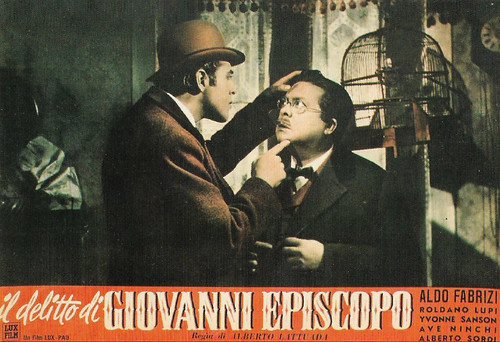
Italian postcard by Ed. Gel, series Aldo Fabrizi. Poster/lobby card for Il delitto di Giovanni Episcopo/Flesh Will Surrender (Alberto Lattuada, 1947), based on the novel by D'Annunzio.
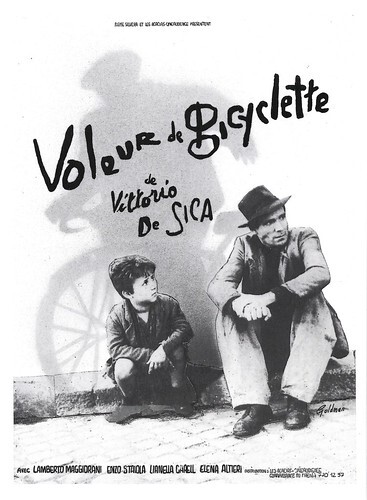
Postcard, reproduction of a French poster based on a classic still from Ladri di biciclette/Bicycle Thieves (Vittorio De Sica, 1948), with Lamberto Maggiorani and Enzo Staiola.
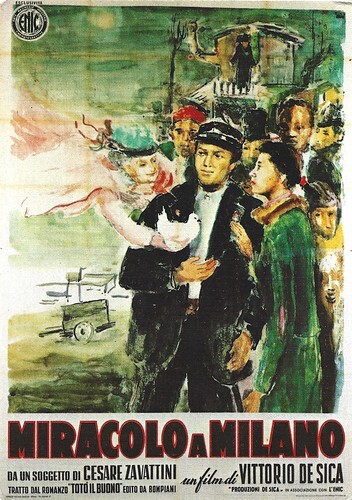
Postcard, reproduction of Italian poster for Miracolo a Milano (Vittorio De Sica, 1951). Poster design by Ercole Brini for ENIC. Hardly recognisable are the leading actors Irma Gramatica , Francesco Golisano and Brunella Bovo.
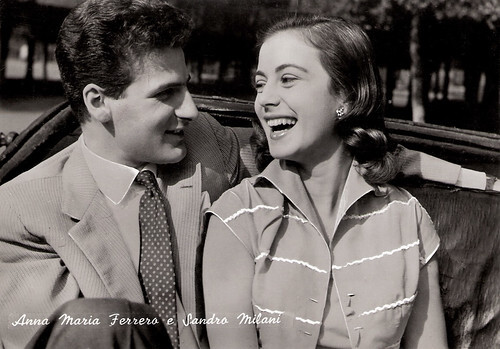
Italian postcard by Bromofoto, Milano (Milan), no. 466. Photo: Anna Maria Ferrero and Sandro Milani in Febbre di vivere/Eager to live (Claudio Gora, 1953).
Monicelli and Visconti
Suso Cecchi D’Amico worked with Mario Monicelli and the couple Age & Scarpelli on the writing of I soliti ignoti/Big Deal on Madonna Street (1958). Screenplay meetings often ended with arguments between Age and Scarpelli, which Monicelli and Cecchi D'Amico kept out of, so as not to give them importance. Uncredited she participated in the script of Alessandro Blasetti’s Fabiola (1940), and while credited she co-wrote the script for William Wyler’s Roman Holiday (1953). With Ennio Flaiano, she wrote the screenplays for the adorable comedies Peccato che sia una canaglia (1955), forcing Sophia Loren into the lead role, after seeing her in Cinecittà, "Beautiful, excessive, decorative as a Christmas Tree" as Cecchi said herself, and La fortuna di essere donna (1956), again starring Loren.
From ca. 1950, Suso Cecchi D’Amico became the regular (co-)screenwriter of Luchino Visconti . The first screenplay for Visconti was La carrozza del Santissimo Sacramento, which was not made because the producer feared the anticlerical stance in the film script, so the project passed to Jean Renoir . Then it was the turn of Bellissima (Luchino Visconti, 1951), with Anna Magnani and Walter Chiari . The latter plays a major character who, barely hinted at in the first version of the screenplay, was later developed for reasons related to the film's distribution. Afterwards, she co-wrote the script of Visconti’s episode Anna of ‘the portmanteau film Siamo donne (1953). The screenplay for Visconti’s Senso (Luchino Visconti, 1954), based on a novella by Camillo Boito, was not entirely shot. D'Amico recounts: "I did not yet have much filming experience with Luchino and I did not foresee all the delays in the villa scenes, all the crossing of rooms to fetch something. At a certain point in the shoot, producer Gualino called me and asked me to tell Visconti that he was going to close. There was more footage than the length of the film and the budget had been greatly exceeded. So the scenes of Alida Valli crossing the battlefields in a carriage were never shot. The Countess Serpieri's journey is reduced to an apparition of the woman in the carriage that was supposed to pass through the bloody troops.” Also, the final scenes were shot in Rome instead, in Trastevere and in a ditch of Castel Sant-Angelo.
In 1957 Suso Cecchi with Visconti, producer Cristaldi and others raised a cooperative to make Le notti bianche (Luchino Visconti, 1957). Suso Cecchi collaborated with Vasco Pratolini on the subject of Visconti’s Rocco e i suoi fratelli/Rocco and His Brothers (Luchino Visconti, 1960). She wrote the screenplay with Pasquale Festa Campanile and Massimo Franciosa, both of whom, coming from the south of Italy, proved very useful for the psychology of the characters and the tone of the dialogues. In the screenplay for Il Gattopardo/The Leopard (Luchino Visconti, 1963), at Visconti's suggestion, she cut the entire final part of Tomasi di Lampedusa's novel to give in the ball scene the sense of the Prince's death and the collapse of the Gattopardi's aristocratic society. For the screenplay of the film Vaghe stelle dell'Orsa.../Sandra (Luchino Visconti, 1965), she took her cue from the tragedy of 'Electra'. For the film Lo straniero/The Stranger (Luchino Visconti, 1967) she was obliged to faithfully transpose Camus' book. Before the editing phase of the film Ludwig (Luchino Visconti, 1973), she was with Visconti when the director suffered a stroke that half paralyzed him, and from which he only recovered with great difficulty. Suso Cecchi also worked on the scripts of Gruppo di famiglia in un interno/Conversation Piece (Luchino Visconti, 1974) and L'innocente/The Innocent (Luchino Visconti, 1976).
As for the development of Senso (Luchino Visconti, 1954), Visconti and Suso had worked beforehand on a screenplay called Marcia nuziale. It was a script with many characters, which the state censors banned because it was about a divorce. There were demonstrations for divorces at the time and the censors did not want to get involved. Gualino instructed Visconti and Suso to come up with a new suggestion within days. Thus Boito's novella rolled out. Concerning the change of characters in the film, not only the introduction of Camillo Ussoni's character but also Franz's character changing from a bonehead to a devilish seducer, Suso remarked: “That had partly to do with the actors we wanted. Originally, Visconti wanted Marlon Brando and not Farley Granger but the producer, in view of foreign exports, wanted Granger, even though he was not at all well known in Italy at the time.
A notable change in production happened after the death of the director of photography, Aldo (Aldo Graziati alias G.R. Aldò). Visconti was used to discussing every shot at length with Aldo , who was a creative genius. They both enjoyed it and learned from each other. Robert Krasker replaced Aldo after his death in a car crash. Krasker was a highly respected cameraman, who had done the colour film Henry V with Laurence Olivier . Krasker asked Visconti why the shoot had to be discussed so extensively beforehand, and from then on, there was no discussion of the shoots at all, much to Visconti's disappointment.” When asked about the reason for changing the title of Boito's Senso to Uragano d'estate and eventually back to Senso, Suso responded: “We had a whole page of titles at one point, not just Uragano d'estate. We spent a whole day making up titles. There was little reasoning for that, the only thing was that sometimes in films people protested like in Rocco because their name was used and they were the only ones with that name (in Rocco, Pafundi became Parondi). In Senso, the Count is first called Pietromarchi, then Serpieri, and Franz Mahler was originally called Hans Weil”. (Interview by Ivo Blom with Suso Cecchi D’Amico, 11 May 2004.)
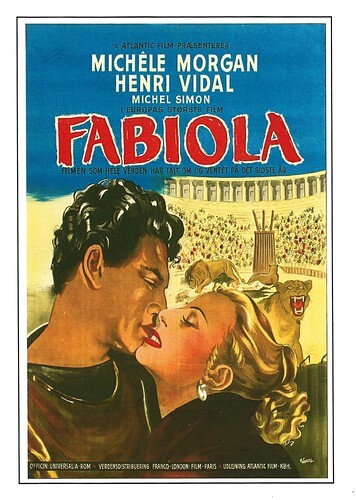
Postcard, reproduction. Danish poster by Atlantic Film for the film Fabiola (Alessandro Blasetti, 1949), starring Michèle Morgan and Henri Vidal .

Reproduction of press photo. Photo by Paul Ronald. Anna Magnani in Bellissima (Luchino Visconti, 1951). Collection Ivo Blom, ex-collection Egbert Barten.
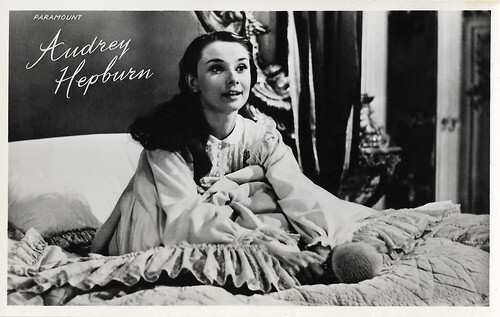
Dutch postcard by Takken / 't Sticht, Utrecht, no. 1469. Photo: Paramount. Audrey Hepburn in Roman Holiday (William Wyler, 1953).
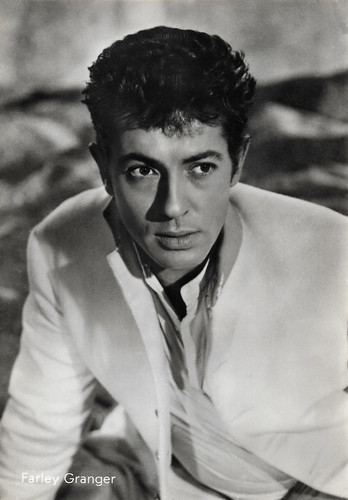
Italian postcard by Bromostampa, Milano, no. 7. Photo: Farley Granger in Senso (1954).
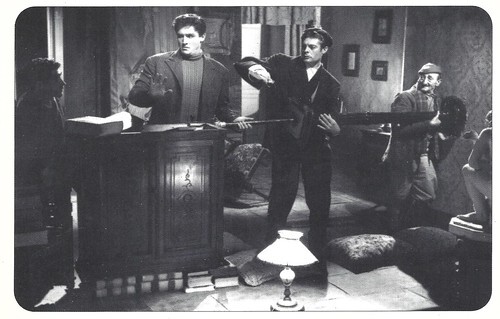
Italian postcard by Coop. soc. Archivio immagini cinema. Card made for exhibition on Marcello Mastroianni. Vittorio Gassman , Marcello Mastroianni and Carlo Pisacane in I soliti ignoti/Big Deal on Madonna Street (Mario Monicelli, 1958).
Visconti, Antonioni, Rosi and Monicelli
Il Gattopardo/The Leopard (Luchino Visconti, 1963) officially employed five screenwriters: Luchino Visconti , Suso Cecchi D’Amico, Enrico Medioli (who was just starting out at the time and was a protege of Suso and Visconti) and two men added on behalf of the Titanus production company, Massimo Franciosa and Pasquale Festa Campanile. The latter two had also collaborated on Rocco and His Brothers, with each writer writing one act. Suso Cecchi D’Amico said in an interview with Ivo Blom in 2004: “At first, Visconti was sour about the imposed addition of Franciosa and Festa Campanile, but the two turned out to be intelligent and sympathetic and Visconti thawed. In the end, everyone wrote one part, Visconti part one: The ‘Rosario’, I did part two: the villeggiatura, and the war scenes (then still in the middle of the villeggiatura scene), Festa Campanile part three: the plebiscite, Medioli part four: the attics and the meeting with Chevalley, and Franciosa part five: the ball."
This did not mean that you still recognise the signature of each individual writer in the film. Each written part was talked through and edited with the whole group. The screenplay had a huge number of versions and expanded so much, because the authors wanted to explain so much about Italian history, especially for the international market, that the screenplay became endlessly long. Suso Cecchi D’Amico: "At some point, it was decided: back to the novel and if people abroad don't understand everything, so be it. Huge scenes were either cut out or condensed, which is a common process. You first grow to absurd proportions and then you cut back."
It was not just because of length that scenes were cut out. Suso Cecchi D’Amico: "The cut of the scene of the fusillade at the end was a deliberate choice by Visconti, to prevent that scene from becoming the climax of the film, rather than the Proustian ball with its slowing down of time and its image of decline of don Fabrizio and of his class. It would become too explanatory. Of Salina's daughters, there is now only one, Concetta, who has real form and dialogue; the others have become sort of extras. This was a conscious choice; you can't give too many people body and it has to do with identification with the audience. Incidentally, many characters in the film were based on characters from the screenwriters' environment; character traits were borrowed from contemporary acquaintances.” (Interview by Ivo Blom with Suso Cecchi D’Amico, 11 May 2004.)
With Michelangelo Antonioni, Suso Cecchi made I vinti (1952), inspired by news events, carrying out investigations and collecting material found in the press and court documents, La signora senza camelie (1953) and Le amiche (1955), winner of the Silver Lion at the Venice Film Festival. She collaborated on the screenplay for the film Camicie rosse (Anita Garibaldi) (1952), directed by Francesco Rosi and Goffredo Alessandrini, starring Anna Magnani , but the film was defined by Cecchi d'Amico as a "senseless adventure". With Francesco Rosi she worked on three other films: La sfida (1957), I magliari (1959) and Salvatore Giuliano (1962). With Luigi Comencini she worked on the films Proibito rubare (1948), La finestra sul Luna Park (1956), Le avventure di Pinocchio (1972), written for television, Cuore (1984) and Infanzia, vocazione e primi esperienze di Giacomo Casanova, veneziano (1969). In her later life, Suso Cecchi often collaborated with her good friend Mario Monicelli, with whom she worked for the first time on Proibito (1954), followed by I soliti ignoti (1958), Risate di gioia (1960), and 14 other films, the last time for Le rose del deserto (2010). Other memorable films on which she co-wrote were Cielo sulla palude (Augusto Genina, 1949), Prima comunione (Blasetti, 1950), Il mondo le condanna (Gianni Franciolini, 1953), Nella città l'inferno (Renato Castellani, 1959), Estate violenta (Valerio Zurlini, 1959), Gli indifferenti (Francesco Maselli, 1964), Metello (Mauro Bolognini, 1970), etc.
Suso Cecchi d’Amico shared several Italian awards with her co-writers for various films and was co-nominated for an Oscar for best screenplay for Mario Monicelli’s Casanova 70, in 1980 she received lifetime career David di Donatello. In 1988, the University of Bari awarded her an honorary degree in Foreign Languages and Literature with the following motivation: “Her fierce technique and vast culture were invaluable in the literary work of film ... She reworked the original subjects with profound literary insight and extraordinary cinematographic sense". In 1994 the Venice Film Festival awarded her the Golden Lion for Lifetime Achievement. Since 2012, the city of Rosignano Marittimo awards the Premio Suso Cecchi D'Amico Castiglioncello per la sceneggiatura, for the best original screenplay for an Italian film.
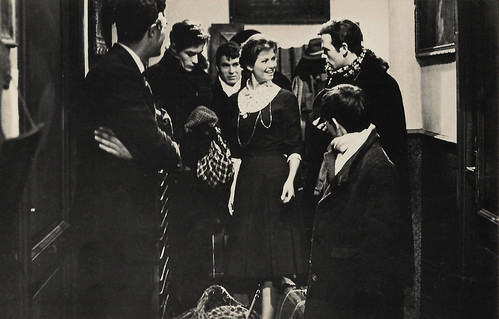
Small Czech collectors card by Pressfoto, Praha (Prague), 1965, no. S 101/5. Photo: Claudia Cardinale , Alain Delon , Max Cartier and Renato Salvatori in Rocco e i suoi fratelli/Rocco and His Brothers (Luchino Visconti, 1960).
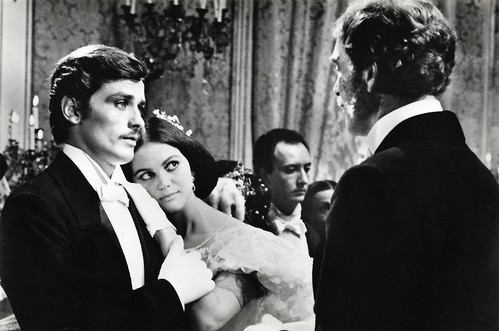
Czech postcard by UPTF / Pressfoto, Praha (Prague), no. C 198, 1965. Photo: G.B. Poletto. Alain Delon , Claudia Cardinale and Burt Lancaster in Il Gattopardo/The Leopard (Luchino Visconti, 1963).
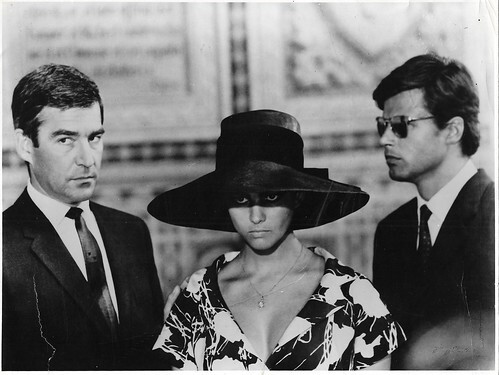
Vintage press photo. Publicity still for Vaghe stelle dell'Orsa/ Sandra (Luchino Visconti, 1965), depicting Michael Craig , Claudia Cardinale and Jean Sorel . Photo by Mario Tursi. Collection: Ivo Blom, ex-collection Egbert Barten.
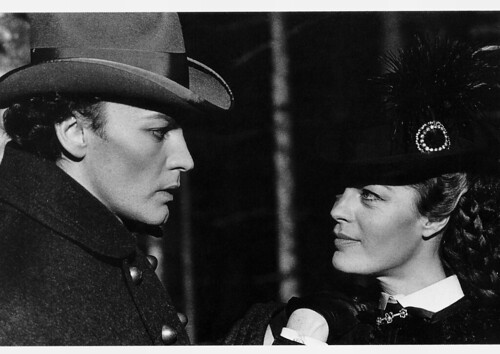
French postcard in the Collection Cinéma by Editions Art & Scene, Paris, no. CI 16, 1996. Photo: Mario Tursi. Helmut Berger and Romy Schneider in Ludwig (Luchino Visconti, 1972).
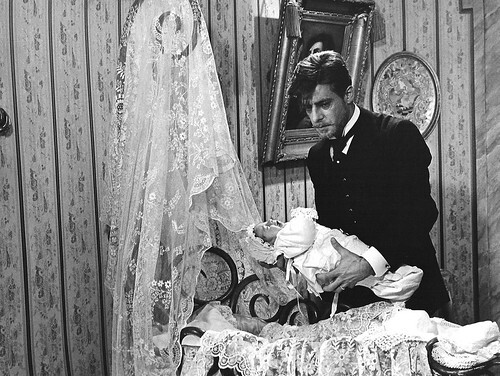
Italian press photo. Photo: Mario Tursi. Giancarlo Giannini in L'Innocente/The Innocent (Luchino Visconti, 1976). Collection: Ivo Blom.
Sources: Wikipedia (Italian, French and English), , and an unpublished interview by Ivo Blom with Suso Cecchi D’Amico, 11 May 2004.

Italian postcard by Rotocalco Dagnino, Torino. Photo: Lux Film. Alida Valli as Countess Livia Serpieri and Farley Granger as Lt. Franz Mahler in Luchino Visconti's historical film Senso (1954).

German postcard. Photo Ufa. Sophia Loren in La fortuna di essere donna/What a Woman! (Alessandro Blasetti, 1956).

Publicity still used in Germany, distributed by Rank, the mark of the German censor FSK. Thomas Milian and Romy Schneider in Luchino Visconti 's episode Il Lavoro in the episode film Boccaccio 70 (1962).
First screenplay
Suso Cecchi D’Amico, pseudonym of Giovanna Cecchi D'Amico, was born in Rome in 1914 to Tuscan parents: the writer Emilio Cecchi (from whom she took her birth name Cecchi) and the painter Leonetta Pieraccini. After finishing the Lycée Chateaubriand in Rome, she did not enrol at university, as she had not taken a diploma in Latin and Greek. 'To continue my studies I could only enrol in one or two faculties, such as botany, which frankly did not interest me'. After a stay abroad, in Switzerland and England, she decided to get a job. Thanks to the intervention of Minister Giuseppe Bottai, "the only hierarch who had any relationship with intellectuals", she was hired at the Ministry of Corporations, later the Ministry of Trade and Currency, where she worked for almost seven years as personal secretary to Eugenio Anzilotti, Director General of Foreign Trade.
In 1938 she married musicologist Fedele D'Amico, Silvio's son, by whom she had three children: Masolino, Silvia and Caterina, who all later on would have important careers in Italian culture. Alone or together with her father, she performed many translations from English and French, including Thomas Hardy's 'Jude the Obscure', 'Tobacco Road', 'Life with Father', 'Look Homeward, Angel', William Shakespeare ’s 'The Merry Wives of Windsor' and 'Othello'. She abandoned this activity, in which she did not show the facility that her son Masolino would have when he began working for the cinema.
During the Second World War, while her husband, a member of the communist Catholics with Adriano Ossicini and Franco Rodano, led a clandestine life in Rome and directed the newspaper Voce Operaia, she moved for six to seven months to Poggibonsi, to the villa of her uncle Gaetano Pieraccini, a doctor and politician who would be the first mayor of Florence after the Liberation. At the end of the conflict, while her husband was hospitalised in Switzerland to recover from tuberculosis, she was "forced to scramble every which way to support herself, her first two children [...] and the house, populated by nannies and other women". Among the curious occupations of this period, she gave lessons in good manners to Maria Michi and English conversation to Giovanna Galletti, both of whom were actresses in Roberto Rossellini’s Roma città aperta/Rome Open City (1945).
Suso Cecchi D’Amico worked on her first screenplay, Avatar, a romantic story set in Venice, inspired by a story by Théophile Gautier, with Ennio Flaiano, Renato Castellani and Alberto Moravia, for Carlo Ponti, then not yet a major producer. But the project was abandoned before even arriving at a proper screenplay, Castellani alone completing a treatment. Together with Castellani, she worked on a story based on a subject by playwright Aldo De Benedetti, Mio figlio professore (1946), directed by Castellani himself and starring Aldo Fabrizi and the Nava sisters. Together with Piero Tellini, she wrote Vivere in pace (1947) and L'onorevole Angelina (1947), both directed by Luigi Zampa and starring Aldo Fabrizi and Anna Magnani respectively, with whom she began to associate assiduously, forging one of her rare friendships with actors. For the subject of Vivere in pace, also signed by Tellini and Zampa but essentially her own, she won the Nastro d'argento for the best subject.
Suso Cecchi participated with Federico Fellini , although almost always absent from meetings, in the screenplay for the film Il delitto di Giovanni Episcopo (1947), based on a novel by Gabriele D'Annunzio and directed by Alberto Lattuada. She wrote with Ennio Flaiano the screenplay for Roma città libera (1947), by Marcello Pagliero, based on La notte porta consiglio, a subject by Flaiano himself. The screenplay sessions with Flaiano passed 'between chats, criticisms and digressions on the subject. There was matter to be extracted to season ten films, and all would have been lost if it had been up to him to extract the juice'. She wrote the screenplays of Vittorio De Sica ’s Ladri di biciclette/Bicycle Thieves (1948) with Cesare Zavattini, proposing the finale with the attempted bicycle theft, of Le Mura di Malapaga (1949), directed by René Clément and Oscar winner for best foreign work, and also collaborated on the screenplay of De Sica’s Miracolo a Milano (1951). Her professional association with Zavattini was interrupted when he disowned the film È più facile che un cammello... directed by Zampa, for which he wrote the subject, while Cecchi D'Amico and Vitaliano Brancati edited the screenplay.

Italian postcard by Ed. Gel. Aldo Fabrizi and Gar Moore in Vivere in pace (Luigi Zampa, 1947).

Italian postcard by Ed. Gel, series Aldo Fabrizi. Poster/lobby card for Il delitto di Giovanni Episcopo/Flesh Will Surrender (Alberto Lattuada, 1947), based on the novel by D'Annunzio.

Postcard, reproduction of a French poster based on a classic still from Ladri di biciclette/Bicycle Thieves (Vittorio De Sica, 1948), with Lamberto Maggiorani and Enzo Staiola.

Postcard, reproduction of Italian poster for Miracolo a Milano (Vittorio De Sica, 1951). Poster design by Ercole Brini for ENIC. Hardly recognisable are the leading actors Irma Gramatica , Francesco Golisano and Brunella Bovo.

Italian postcard by Bromofoto, Milano (Milan), no. 466. Photo: Anna Maria Ferrero and Sandro Milani in Febbre di vivere/Eager to live (Claudio Gora, 1953).
Monicelli and Visconti
Suso Cecchi D’Amico worked with Mario Monicelli and the couple Age & Scarpelli on the writing of I soliti ignoti/Big Deal on Madonna Street (1958). Screenplay meetings often ended with arguments between Age and Scarpelli, which Monicelli and Cecchi D'Amico kept out of, so as not to give them importance. Uncredited she participated in the script of Alessandro Blasetti’s Fabiola (1940), and while credited she co-wrote the script for William Wyler’s Roman Holiday (1953). With Ennio Flaiano, she wrote the screenplays for the adorable comedies Peccato che sia una canaglia (1955), forcing Sophia Loren into the lead role, after seeing her in Cinecittà, "Beautiful, excessive, decorative as a Christmas Tree" as Cecchi said herself, and La fortuna di essere donna (1956), again starring Loren.
From ca. 1950, Suso Cecchi D’Amico became the regular (co-)screenwriter of Luchino Visconti . The first screenplay for Visconti was La carrozza del Santissimo Sacramento, which was not made because the producer feared the anticlerical stance in the film script, so the project passed to Jean Renoir . Then it was the turn of Bellissima (Luchino Visconti, 1951), with Anna Magnani and Walter Chiari . The latter plays a major character who, barely hinted at in the first version of the screenplay, was later developed for reasons related to the film's distribution. Afterwards, she co-wrote the script of Visconti’s episode Anna of ‘the portmanteau film Siamo donne (1953). The screenplay for Visconti’s Senso (Luchino Visconti, 1954), based on a novella by Camillo Boito, was not entirely shot. D'Amico recounts: "I did not yet have much filming experience with Luchino and I did not foresee all the delays in the villa scenes, all the crossing of rooms to fetch something. At a certain point in the shoot, producer Gualino called me and asked me to tell Visconti that he was going to close. There was more footage than the length of the film and the budget had been greatly exceeded. So the scenes of Alida Valli crossing the battlefields in a carriage were never shot. The Countess Serpieri's journey is reduced to an apparition of the woman in the carriage that was supposed to pass through the bloody troops.” Also, the final scenes were shot in Rome instead, in Trastevere and in a ditch of Castel Sant-Angelo.
In 1957 Suso Cecchi with Visconti, producer Cristaldi and others raised a cooperative to make Le notti bianche (Luchino Visconti, 1957). Suso Cecchi collaborated with Vasco Pratolini on the subject of Visconti’s Rocco e i suoi fratelli/Rocco and His Brothers (Luchino Visconti, 1960). She wrote the screenplay with Pasquale Festa Campanile and Massimo Franciosa, both of whom, coming from the south of Italy, proved very useful for the psychology of the characters and the tone of the dialogues. In the screenplay for Il Gattopardo/The Leopard (Luchino Visconti, 1963), at Visconti's suggestion, she cut the entire final part of Tomasi di Lampedusa's novel to give in the ball scene the sense of the Prince's death and the collapse of the Gattopardi's aristocratic society. For the screenplay of the film Vaghe stelle dell'Orsa.../Sandra (Luchino Visconti, 1965), she took her cue from the tragedy of 'Electra'. For the film Lo straniero/The Stranger (Luchino Visconti, 1967) she was obliged to faithfully transpose Camus' book. Before the editing phase of the film Ludwig (Luchino Visconti, 1973), she was with Visconti when the director suffered a stroke that half paralyzed him, and from which he only recovered with great difficulty. Suso Cecchi also worked on the scripts of Gruppo di famiglia in un interno/Conversation Piece (Luchino Visconti, 1974) and L'innocente/The Innocent (Luchino Visconti, 1976).
As for the development of Senso (Luchino Visconti, 1954), Visconti and Suso had worked beforehand on a screenplay called Marcia nuziale. It was a script with many characters, which the state censors banned because it was about a divorce. There were demonstrations for divorces at the time and the censors did not want to get involved. Gualino instructed Visconti and Suso to come up with a new suggestion within days. Thus Boito's novella rolled out. Concerning the change of characters in the film, not only the introduction of Camillo Ussoni's character but also Franz's character changing from a bonehead to a devilish seducer, Suso remarked: “That had partly to do with the actors we wanted. Originally, Visconti wanted Marlon Brando and not Farley Granger but the producer, in view of foreign exports, wanted Granger, even though he was not at all well known in Italy at the time.
A notable change in production happened after the death of the director of photography, Aldo (Aldo Graziati alias G.R. Aldò). Visconti was used to discussing every shot at length with Aldo , who was a creative genius. They both enjoyed it and learned from each other. Robert Krasker replaced Aldo after his death in a car crash. Krasker was a highly respected cameraman, who had done the colour film Henry V with Laurence Olivier . Krasker asked Visconti why the shoot had to be discussed so extensively beforehand, and from then on, there was no discussion of the shoots at all, much to Visconti's disappointment.” When asked about the reason for changing the title of Boito's Senso to Uragano d'estate and eventually back to Senso, Suso responded: “We had a whole page of titles at one point, not just Uragano d'estate. We spent a whole day making up titles. There was little reasoning for that, the only thing was that sometimes in films people protested like in Rocco because their name was used and they were the only ones with that name (in Rocco, Pafundi became Parondi). In Senso, the Count is first called Pietromarchi, then Serpieri, and Franz Mahler was originally called Hans Weil”. (Interview by Ivo Blom with Suso Cecchi D’Amico, 11 May 2004.)

Postcard, reproduction. Danish poster by Atlantic Film for the film Fabiola (Alessandro Blasetti, 1949), starring Michèle Morgan and Henri Vidal .

Reproduction of press photo. Photo by Paul Ronald. Anna Magnani in Bellissima (Luchino Visconti, 1951). Collection Ivo Blom, ex-collection Egbert Barten.

Dutch postcard by Takken / 't Sticht, Utrecht, no. 1469. Photo: Paramount. Audrey Hepburn in Roman Holiday (William Wyler, 1953).

Italian postcard by Bromostampa, Milano, no. 7. Photo: Farley Granger in Senso (1954).

Italian postcard by Coop. soc. Archivio immagini cinema. Card made for exhibition on Marcello Mastroianni. Vittorio Gassman , Marcello Mastroianni and Carlo Pisacane in I soliti ignoti/Big Deal on Madonna Street (Mario Monicelli, 1958).
Visconti, Antonioni, Rosi and Monicelli
Il Gattopardo/The Leopard (Luchino Visconti, 1963) officially employed five screenwriters: Luchino Visconti , Suso Cecchi D’Amico, Enrico Medioli (who was just starting out at the time and was a protege of Suso and Visconti) and two men added on behalf of the Titanus production company, Massimo Franciosa and Pasquale Festa Campanile. The latter two had also collaborated on Rocco and His Brothers, with each writer writing one act. Suso Cecchi D’Amico said in an interview with Ivo Blom in 2004: “At first, Visconti was sour about the imposed addition of Franciosa and Festa Campanile, but the two turned out to be intelligent and sympathetic and Visconti thawed. In the end, everyone wrote one part, Visconti part one: The ‘Rosario’, I did part two: the villeggiatura, and the war scenes (then still in the middle of the villeggiatura scene), Festa Campanile part three: the plebiscite, Medioli part four: the attics and the meeting with Chevalley, and Franciosa part five: the ball."
This did not mean that you still recognise the signature of each individual writer in the film. Each written part was talked through and edited with the whole group. The screenplay had a huge number of versions and expanded so much, because the authors wanted to explain so much about Italian history, especially for the international market, that the screenplay became endlessly long. Suso Cecchi D’Amico: "At some point, it was decided: back to the novel and if people abroad don't understand everything, so be it. Huge scenes were either cut out or condensed, which is a common process. You first grow to absurd proportions and then you cut back."
It was not just because of length that scenes were cut out. Suso Cecchi D’Amico: "The cut of the scene of the fusillade at the end was a deliberate choice by Visconti, to prevent that scene from becoming the climax of the film, rather than the Proustian ball with its slowing down of time and its image of decline of don Fabrizio and of his class. It would become too explanatory. Of Salina's daughters, there is now only one, Concetta, who has real form and dialogue; the others have become sort of extras. This was a conscious choice; you can't give too many people body and it has to do with identification with the audience. Incidentally, many characters in the film were based on characters from the screenwriters' environment; character traits were borrowed from contemporary acquaintances.” (Interview by Ivo Blom with Suso Cecchi D’Amico, 11 May 2004.)
With Michelangelo Antonioni, Suso Cecchi made I vinti (1952), inspired by news events, carrying out investigations and collecting material found in the press and court documents, La signora senza camelie (1953) and Le amiche (1955), winner of the Silver Lion at the Venice Film Festival. She collaborated on the screenplay for the film Camicie rosse (Anita Garibaldi) (1952), directed by Francesco Rosi and Goffredo Alessandrini, starring Anna Magnani , but the film was defined by Cecchi d'Amico as a "senseless adventure". With Francesco Rosi she worked on three other films: La sfida (1957), I magliari (1959) and Salvatore Giuliano (1962). With Luigi Comencini she worked on the films Proibito rubare (1948), La finestra sul Luna Park (1956), Le avventure di Pinocchio (1972), written for television, Cuore (1984) and Infanzia, vocazione e primi esperienze di Giacomo Casanova, veneziano (1969). In her later life, Suso Cecchi often collaborated with her good friend Mario Monicelli, with whom she worked for the first time on Proibito (1954), followed by I soliti ignoti (1958), Risate di gioia (1960), and 14 other films, the last time for Le rose del deserto (2010). Other memorable films on which she co-wrote were Cielo sulla palude (Augusto Genina, 1949), Prima comunione (Blasetti, 1950), Il mondo le condanna (Gianni Franciolini, 1953), Nella città l'inferno (Renato Castellani, 1959), Estate violenta (Valerio Zurlini, 1959), Gli indifferenti (Francesco Maselli, 1964), Metello (Mauro Bolognini, 1970), etc.
Suso Cecchi d’Amico shared several Italian awards with her co-writers for various films and was co-nominated for an Oscar for best screenplay for Mario Monicelli’s Casanova 70, in 1980 she received lifetime career David di Donatello. In 1988, the University of Bari awarded her an honorary degree in Foreign Languages and Literature with the following motivation: “Her fierce technique and vast culture were invaluable in the literary work of film ... She reworked the original subjects with profound literary insight and extraordinary cinematographic sense". In 1994 the Venice Film Festival awarded her the Golden Lion for Lifetime Achievement. Since 2012, the city of Rosignano Marittimo awards the Premio Suso Cecchi D'Amico Castiglioncello per la sceneggiatura, for the best original screenplay for an Italian film.

Small Czech collectors card by Pressfoto, Praha (Prague), 1965, no. S 101/5. Photo: Claudia Cardinale , Alain Delon , Max Cartier and Renato Salvatori in Rocco e i suoi fratelli/Rocco and His Brothers (Luchino Visconti, 1960).

Czech postcard by UPTF / Pressfoto, Praha (Prague), no. C 198, 1965. Photo: G.B. Poletto. Alain Delon , Claudia Cardinale and Burt Lancaster in Il Gattopardo/The Leopard (Luchino Visconti, 1963).

Vintage press photo. Publicity still for Vaghe stelle dell'Orsa/ Sandra (Luchino Visconti, 1965), depicting Michael Craig , Claudia Cardinale and Jean Sorel . Photo by Mario Tursi. Collection: Ivo Blom, ex-collection Egbert Barten.

French postcard in the Collection Cinéma by Editions Art & Scene, Paris, no. CI 16, 1996. Photo: Mario Tursi. Helmut Berger and Romy Schneider in Ludwig (Luchino Visconti, 1972).

Italian press photo. Photo: Mario Tursi. Giancarlo Giannini in L'Innocente/The Innocent (Luchino Visconti, 1976). Collection: Ivo Blom.
Sources: Wikipedia (Italian, French and English), , and an unpublished interview by Ivo Blom with Suso Cecchi D’Amico, 11 May 2004.
Published on June 28, 2023 22:00
June 27, 2023
Century of Cinema: 1903
In 1903 Méliès was at the peak of his art, creating wonderful gems such as Le Royaume des fées, a film destined to be the centrepiece of a programme at Il Cinema Ritrovato 2023, curated by Mariann Lewinsky and Karl Wratschko, made up of several genres, always with its fair share of short comedies and visual tricks. While British pioneers were contributing to the cinema with their innovative spirit, in the US – see Edwin S. Porter’s The Great Train Robbery – violence and plot-driven films were already happening.
In the same year, Pathé Frères ambitiously rivalled the grand féeries with spectacular productions by Lucien Nonguet about historical figures (Napoléon, Marie Antoinette). Several Pathé titles – part of the Corricks (itinerant showmen) collection – will be presented in restored versions originating from gorgeously hand-coloured prints found in Australia. For this post, Ivo Blom selected postcards of several Pathé films from 1903.
Don Quichotte
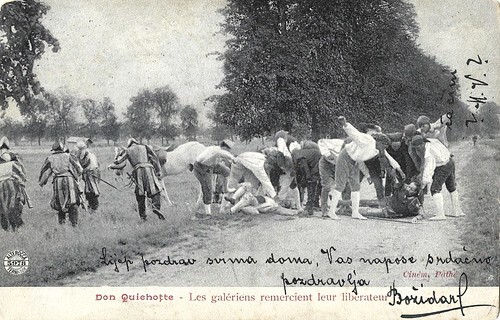
French postcard by Alterocca, Terni, Italy. Photo: Pathé Frères. Publicity still for Don Quichotte (Ferdinand Zecca, Lucien Nonguet, 1903). Sets were by Vincent Lorant-Heilbronn. Caption: Receiving the thanks of the liberated convicts. This scene lacks in the remaining print of the film. The 1903 version is the oldest film version of Cervantes' classic tale. It is unclear who the actors were. The writing on the card is in Slovenian and says: To the better healed at home, we extend our warmest regards to you.
Don Quichotte, fully titled Aventures de Don Quichotte de la Manche, was a film in 15 tableaux, measuring some 430 meters. A reduced version of 255 m. was also launched in 1903, possibly for exhibitors who thought a film of more than 15 minutes was too long for their audience. Pathé claimed in their catalogue that all the important scenes had been kept and the entire film had kept its original character.
La Vie et la Passion de Jésus-Christ
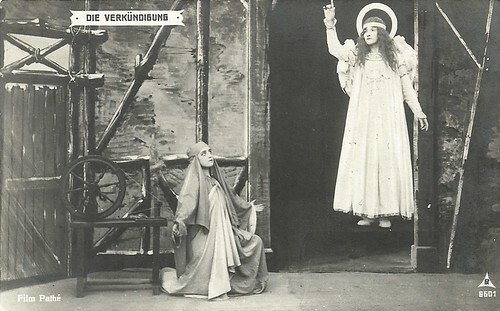
Franco-German postcard by PH, no. 6601. Photo: Film Pathé. This may be a scene from the 1903 film La Vie et la Passion de Jésus-Christ, started in 1902 by Ferdinand Zecca and finished in 1903 by Lucien Nonguet, when Zecca moved over to Gaumont. Caption: Vie de Christ, ep. 'Die Verkündigung' (the Annunciation).
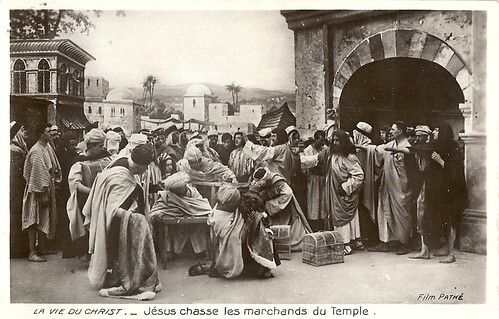
French postcard. Photo: Pathé Frères. Scene from the early Pathé film La vie du Christ which might be La Vie et la passion de Jésus-Christ (Lucien Nonguet, Ferdinand Zecca, 1903). Caption: Jesus chases the merchants from the Temple. This image deviates from the one in the existing prints of Vie et passion de notre seigneur Jésus-Christ (Ferdinand Zecca, 1907).
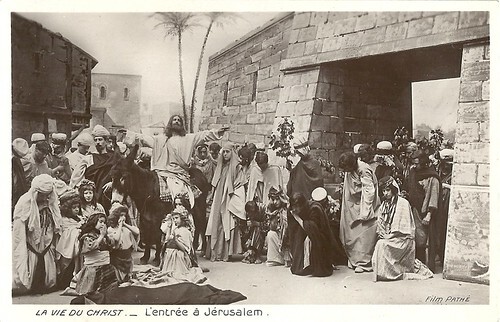
French postcard. Photo: Pathé Frères. Scene from the early Pathé film La vie du Christ, which might be La Vie et la passion de Jésus-Christ (Lucien Nonguet, Ferdinand Zecca, 1903). Caption: The Entrance to Jerusalem. This image deviates from the one in the existing prints of Vie et passion de notre seigneur Jésus-Christ (Ferdinand Zecca, 1907).
Le chat botté

French postcard by Croissant, Paris, mo. 3667. Photo: Pathé Frères. Scene from Le chat botté/Puss in Boots (Lucien Nonguet, 1903), based on the fairytale by Charles Perrault (1697). Actors: Bretteau and Edmond Boutillon. Caption: The King rescuing the Marquis of Carabas.
Guillaume Tell

French postcard by Croissant, Paris, series 3661. Photo: Film Pathé. Publicity still for Guillaume Tell (Lucien Nonguet, 1903) with Edmond Boutillon (Gessler). Sets: Vincent Lorant-Heilbronn. Théâtre Pathé Grolée, Lyon. It is unknown who played Tell. This exact image does not appear in the remaining print, as the acclamation at the end of the film takes place on a town square, while this setting refers to Tableau 1, near the river.
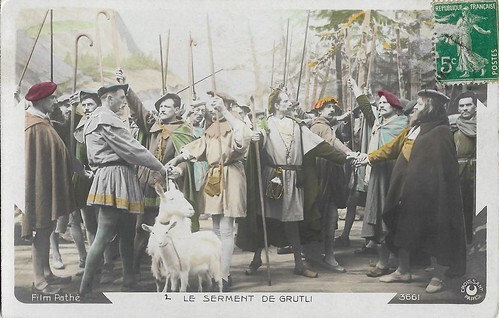
French postcard by Croissant, Paris, series 3661. Photo: Film Pathé. Publicity still for Guillaume Tell (Lucien Nonguet, 1903). This card depicts the so-called Rütli-Schwur, the legendary oath taken at the foundation of the Old Swiss Confederacy.
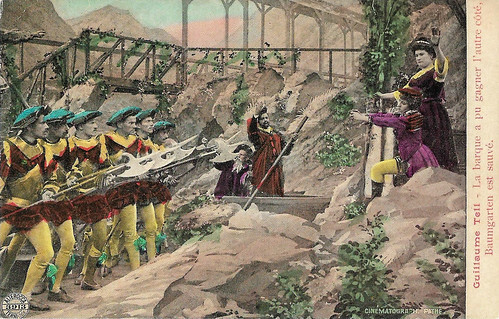
Reproduction of Italian postcard by Ed. Alterocca, Terni, no. 3913, card 1 of 5. Photo: Cinématographes Pathé. Publicity still for Guillaume Tell/ William Tell (Lucien Nonguet, 1903). Caption: The boat has reached the other shore, Baumgarten is saved. (William Tell helps a peasant escape on a rowing boat just before a group of soldiers enters). This is the first film adaptation of the eponymous play by Friedrich Schiller and the opera by Rossini.

Reproduction of Italian postcard by Ed. Alterocca, Terni, no. 3917. Photo: Cinématographes Pathé. Publicity still for Guillaume Tell/ William Tell (Lucien Nonguet, 1903). Caption: La mort de Gessler. La Suisse acclame Tell son libérateur. (The death of Gessler. Switzerland acclaims Tell as its liberator.)
The ogre throwing small children in a steaming cauldron
Richard Abel, in his study 'The Cine Goes To Town. French Cinema, 1896-1914', indicates how by 1903 French films, in particular those by Pathé, created what would become "a standard mode of representation and narration for Pathé's longer films", that is: a series of long-shot tableaux with brief intertitles. This is clearly visible in two 1903 films by Pathé: Don Quichotte and Le chat botté/Puss-in-Boots. The first was composed of fifteen shot scenes, of which only half survives. Most shots focused on the farcical episodes of Cervantes' novel, Stencil colouring increased the spectacular effects of e.g. the explosion of the fake horse or the garish clothes of Sancho Panza when he is made governor. "What is especially unusual is its strategy of repeatedly representing two different spaces with the same tableau", such as the scene in which Don Quichotte and Sancho Panza attack a mill and nearly drown. Using a matte shot, we also see the people inside the mill at the same time. Pathé's Don Quichotte is also credited as being the first Pathé film with intertitles.
In Le chat botté/Puss-in-Boots (remade in 1908 by Albert Capellani), the same tableaux-style interspaced with brief intertitles was used. It may well have been based on stage pantomimes after the classic Charles Perrault tale. While the film has gruesome scenes similar to Méliès'films, such as the ogre throwing small children in a steaming cauldron, it also opens with a calm, Millet-like tableau of the miller's family. The penultimate tableau has a dance scene, an almost obligatory part of the early fairy tale films by Méliès and Pathé. The film ends with a typical apotheosis with angels on a staircase leading children to the top. While this version was entirely shot in a studio, Capellani would shoot several exteriors outside in woods or the French countryside, signalling a new shift in Pathé's fairy tale films.
By 1903, companies like Pathé started to shift from real or staged actualities to historical and realist films. After the success of George Méliès' The Coronation of Edward VII (1902), Pathé started making historical films, first Epopée napoléonienne (1903), "whose success securely established the single, unified view of the autonomous shot-scene as a characteristic feature of the genre." The two-part film strongly relied on French historical painting, thus creating a series of tableaux vivant-like scenes but then put into motion, citing the works by Vernet, David and Von Steuben. These paintings had already been popularised by stage tableau vivant of famous paintings, called 'realisations' at the time, as well as by school textbooks on history. Exhibitors were free to reduce or rearrange the series of tableaux of the film.
This flexibility was also typical for another Pathé film of 1903: La Vie et la Passion de Jésus-Christ, which followed earlier Life of Christ films by Lumière (1897), Gaumont (1899) and Pathé itself (1900). While American adaptations often were based on the Oberammergau passion play, Pathé composed its own script. The film was distributed in at least three different versions, of which the longest was almost 600 meters (ca. half an hour), which was unheard of in those years. It adhered to the tableau style, with each shot preceded by a short intertitle. Exhibitors were entirely free to buy whichever series or shots they wanted and could choose a black-and-white or a stencil-coloured version. While very little of this film remains and is not available online, several Passion films by Pathé put online erroneously claiming it to be 1903 while being instead the version of 1907 or 1913.
Epopée napoléonienne gave the go-ahead for a series of Pathé historical films in 1903-1904, including Guillaume Tell (1903). Inspired by the play by Friedrich Schiller (1804) and the opera by Gioacchino Rossini (1829), Lucien Nonguet and his art director Vincent Lorant-Heilbronn staged a film of 145 meters (about 7 to 8 minutes), which contained the most important moments of the story of the heroic Swiss liberator. Some elements were condensed. Within the Schiller tale, Tell first escapes from the boat with Gessler and his men, during a storm. Later on, he kills Gessler when the latter is riding in the woods near Küssnacht. In the Pathé film Tell jumps from the boat and kills Gessler right away.
L'Epopée napoléonienne
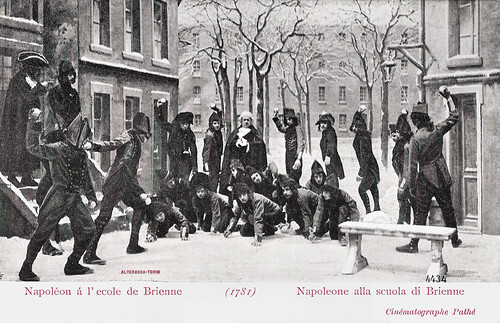
Italian postcard by Alterocca, Terni, no. 4434. Photo: Cinématographe Pathé. Publicity still for L'Epopée napoléonienne (Lucien Nonguet, 1903) by Pathé Frères. Caption: Napoléon à l'école de Brienne (1781).
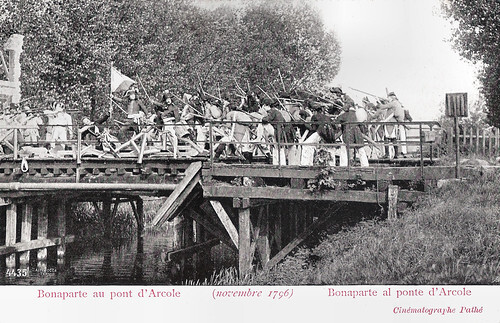
Italian postcard. Alterocca, Terni, no. 4435. Photo: Cinématographe Pathé. Publicity still for L'Epopée napoléonienne (Lucien Nonguet, 1903) by Pathé Frères. Caption: Bonaparte au pont d'Arcole (novembre 1796).
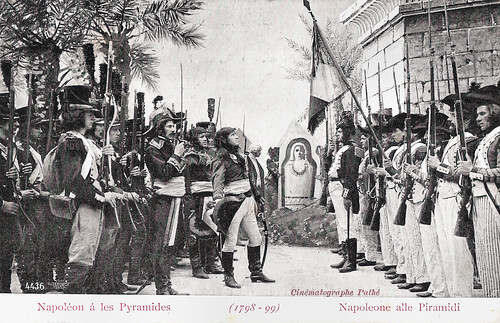
Italian postcard. Alterocca, Terni, no. 4436. Photo: Cinématographe Pathé. Publicity still for L'Epopée napoléonienne (Lucien Nonguet, 1903) by Pathé Frères. Caption: apoléon á les Pyramides (1798-99).
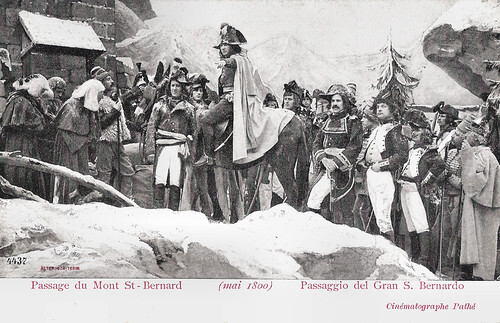
Italian postcard by Alterocca, Terni, no. 4437. Photo: Cinématographe Pathé. Publicity still for L'Epopée napoléonienne (Lucien Nonguet, 1903) by Pathé Frères. Passage du Mont St.-Bernard (mai 1800).
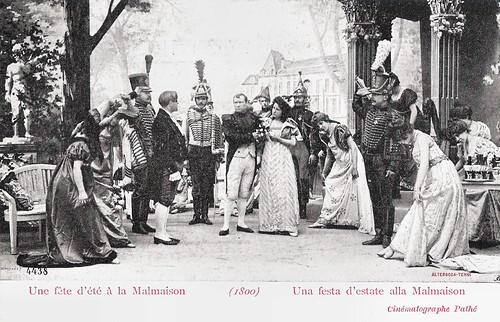
Italian postcard by Alterocca, Terni, no. 4438. Photo: Cinématographe Pathé. Publicity still for L'Epopée napoléonienne (Lucien Nonguet, 1903) by Pathé Frères. Caption: Une fête d'été à la Malmaison (1800).
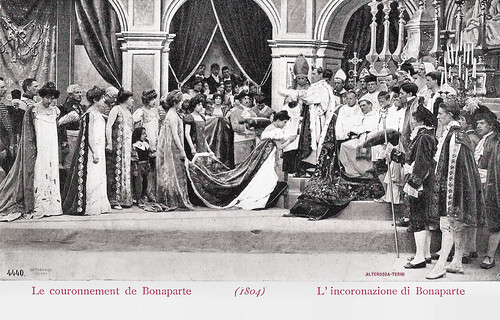
Italian postcard by Alterocca, Terni, no. 4440. Photo: Cinématographe Pathé. Publicity still for L'Epopée napoléonienne (Lucien Nonguet, 1903) by Pathé Frères. Caption: Le Couronnement de Bonaparte (1804).
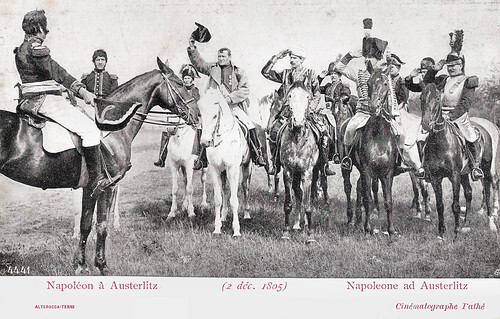
Italian postcard. Alterocca, Terni, no. 4441. Photo: Cinématographe Pathé. Publicity still for L'Epopée napoléonienne (Lucien Nonguet, 1903) by Pathé Frères. Caption: Napoléon à Austerlitz (2 déc. 1805).
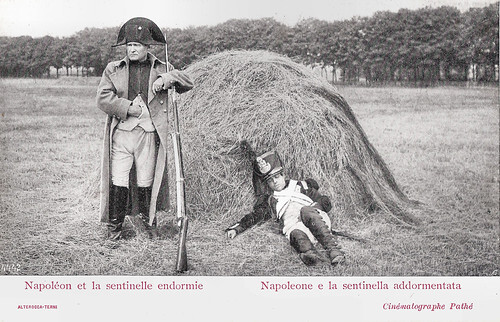
Italian postcard by Alterocca, Terni, no. 4442. Photo: Cinématographe Pathé. Publicity still for L'Epopée napoléonienne (Lucien Nonguet, 1903) by Pathé Frères. Caption: Napoléon et la sentinelle endormie.
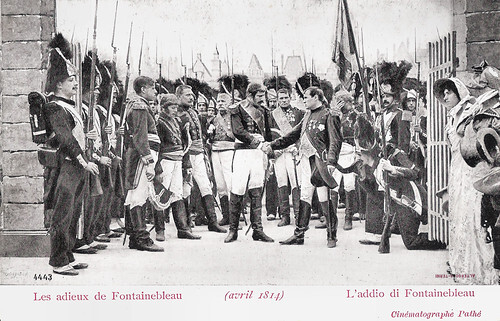
Italian postcard by Alterocca, Terni, no. 4443. Photo: Cinématographe Pathé. Publicity still for L'Epopée napoléonienne (Lucien Nonguet, 1903) by Pathé Frères. Caption: Les adieux de Fontainebleau (avril 1814).
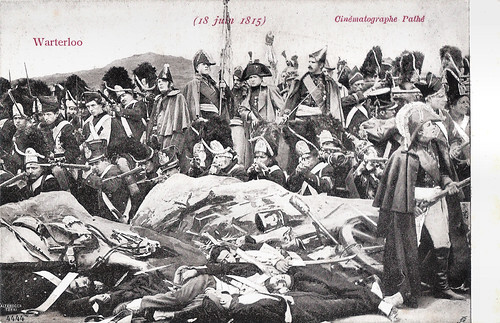
Italian postcard by Alterocca, Terni, no. 4444. Photo: Cinématographe Pathé. Publicity still for L'Epopée napoléonienne (Lucien Nonguet, 1903) by Pathé Frères. Caption: Waterloo (18 juin 1815).
Sources: Richard Abel (The Cine Goes To Town. French Cinema, 1896-1914), Henri Bousquet (Catalogue Pathé des années 1896-1914, Vol. I., 1896-1906 - French), Il Cinema Ritrovato, Fondation Jerome Seydoux Pathé, Wikipedia and IMDb.
In the same year, Pathé Frères ambitiously rivalled the grand féeries with spectacular productions by Lucien Nonguet about historical figures (Napoléon, Marie Antoinette). Several Pathé titles – part of the Corricks (itinerant showmen) collection – will be presented in restored versions originating from gorgeously hand-coloured prints found in Australia. For this post, Ivo Blom selected postcards of several Pathé films from 1903.
Don Quichotte

French postcard by Alterocca, Terni, Italy. Photo: Pathé Frères. Publicity still for Don Quichotte (Ferdinand Zecca, Lucien Nonguet, 1903). Sets were by Vincent Lorant-Heilbronn. Caption: Receiving the thanks of the liberated convicts. This scene lacks in the remaining print of the film. The 1903 version is the oldest film version of Cervantes' classic tale. It is unclear who the actors were. The writing on the card is in Slovenian and says: To the better healed at home, we extend our warmest regards to you.
Don Quichotte, fully titled Aventures de Don Quichotte de la Manche, was a film in 15 tableaux, measuring some 430 meters. A reduced version of 255 m. was also launched in 1903, possibly for exhibitors who thought a film of more than 15 minutes was too long for their audience. Pathé claimed in their catalogue that all the important scenes had been kept and the entire film had kept its original character.
La Vie et la Passion de Jésus-Christ

Franco-German postcard by PH, no. 6601. Photo: Film Pathé. This may be a scene from the 1903 film La Vie et la Passion de Jésus-Christ, started in 1902 by Ferdinand Zecca and finished in 1903 by Lucien Nonguet, when Zecca moved over to Gaumont. Caption: Vie de Christ, ep. 'Die Verkündigung' (the Annunciation).

French postcard. Photo: Pathé Frères. Scene from the early Pathé film La vie du Christ which might be La Vie et la passion de Jésus-Christ (Lucien Nonguet, Ferdinand Zecca, 1903). Caption: Jesus chases the merchants from the Temple. This image deviates from the one in the existing prints of Vie et passion de notre seigneur Jésus-Christ (Ferdinand Zecca, 1907).

French postcard. Photo: Pathé Frères. Scene from the early Pathé film La vie du Christ, which might be La Vie et la passion de Jésus-Christ (Lucien Nonguet, Ferdinand Zecca, 1903). Caption: The Entrance to Jerusalem. This image deviates from the one in the existing prints of Vie et passion de notre seigneur Jésus-Christ (Ferdinand Zecca, 1907).
Le chat botté

French postcard by Croissant, Paris, mo. 3667. Photo: Pathé Frères. Scene from Le chat botté/Puss in Boots (Lucien Nonguet, 1903), based on the fairytale by Charles Perrault (1697). Actors: Bretteau and Edmond Boutillon. Caption: The King rescuing the Marquis of Carabas.
Guillaume Tell

French postcard by Croissant, Paris, series 3661. Photo: Film Pathé. Publicity still for Guillaume Tell (Lucien Nonguet, 1903) with Edmond Boutillon (Gessler). Sets: Vincent Lorant-Heilbronn. Théâtre Pathé Grolée, Lyon. It is unknown who played Tell. This exact image does not appear in the remaining print, as the acclamation at the end of the film takes place on a town square, while this setting refers to Tableau 1, near the river.

French postcard by Croissant, Paris, series 3661. Photo: Film Pathé. Publicity still for Guillaume Tell (Lucien Nonguet, 1903). This card depicts the so-called Rütli-Schwur, the legendary oath taken at the foundation of the Old Swiss Confederacy.

Reproduction of Italian postcard by Ed. Alterocca, Terni, no. 3913, card 1 of 5. Photo: Cinématographes Pathé. Publicity still for Guillaume Tell/ William Tell (Lucien Nonguet, 1903). Caption: The boat has reached the other shore, Baumgarten is saved. (William Tell helps a peasant escape on a rowing boat just before a group of soldiers enters). This is the first film adaptation of the eponymous play by Friedrich Schiller and the opera by Rossini.

Reproduction of Italian postcard by Ed. Alterocca, Terni, no. 3917. Photo: Cinématographes Pathé. Publicity still for Guillaume Tell/ William Tell (Lucien Nonguet, 1903). Caption: La mort de Gessler. La Suisse acclame Tell son libérateur. (The death of Gessler. Switzerland acclaims Tell as its liberator.)
The ogre throwing small children in a steaming cauldron
Richard Abel, in his study 'The Cine Goes To Town. French Cinema, 1896-1914', indicates how by 1903 French films, in particular those by Pathé, created what would become "a standard mode of representation and narration for Pathé's longer films", that is: a series of long-shot tableaux with brief intertitles. This is clearly visible in two 1903 films by Pathé: Don Quichotte and Le chat botté/Puss-in-Boots. The first was composed of fifteen shot scenes, of which only half survives. Most shots focused on the farcical episodes of Cervantes' novel, Stencil colouring increased the spectacular effects of e.g. the explosion of the fake horse or the garish clothes of Sancho Panza when he is made governor. "What is especially unusual is its strategy of repeatedly representing two different spaces with the same tableau", such as the scene in which Don Quichotte and Sancho Panza attack a mill and nearly drown. Using a matte shot, we also see the people inside the mill at the same time. Pathé's Don Quichotte is also credited as being the first Pathé film with intertitles.
In Le chat botté/Puss-in-Boots (remade in 1908 by Albert Capellani), the same tableaux-style interspaced with brief intertitles was used. It may well have been based on stage pantomimes after the classic Charles Perrault tale. While the film has gruesome scenes similar to Méliès'films, such as the ogre throwing small children in a steaming cauldron, it also opens with a calm, Millet-like tableau of the miller's family. The penultimate tableau has a dance scene, an almost obligatory part of the early fairy tale films by Méliès and Pathé. The film ends with a typical apotheosis with angels on a staircase leading children to the top. While this version was entirely shot in a studio, Capellani would shoot several exteriors outside in woods or the French countryside, signalling a new shift in Pathé's fairy tale films.
By 1903, companies like Pathé started to shift from real or staged actualities to historical and realist films. After the success of George Méliès' The Coronation of Edward VII (1902), Pathé started making historical films, first Epopée napoléonienne (1903), "whose success securely established the single, unified view of the autonomous shot-scene as a characteristic feature of the genre." The two-part film strongly relied on French historical painting, thus creating a series of tableaux vivant-like scenes but then put into motion, citing the works by Vernet, David and Von Steuben. These paintings had already been popularised by stage tableau vivant of famous paintings, called 'realisations' at the time, as well as by school textbooks on history. Exhibitors were free to reduce or rearrange the series of tableaux of the film.
This flexibility was also typical for another Pathé film of 1903: La Vie et la Passion de Jésus-Christ, which followed earlier Life of Christ films by Lumière (1897), Gaumont (1899) and Pathé itself (1900). While American adaptations often were based on the Oberammergau passion play, Pathé composed its own script. The film was distributed in at least three different versions, of which the longest was almost 600 meters (ca. half an hour), which was unheard of in those years. It adhered to the tableau style, with each shot preceded by a short intertitle. Exhibitors were entirely free to buy whichever series or shots they wanted and could choose a black-and-white or a stencil-coloured version. While very little of this film remains and is not available online, several Passion films by Pathé put online erroneously claiming it to be 1903 while being instead the version of 1907 or 1913.
Epopée napoléonienne gave the go-ahead for a series of Pathé historical films in 1903-1904, including Guillaume Tell (1903). Inspired by the play by Friedrich Schiller (1804) and the opera by Gioacchino Rossini (1829), Lucien Nonguet and his art director Vincent Lorant-Heilbronn staged a film of 145 meters (about 7 to 8 minutes), which contained the most important moments of the story of the heroic Swiss liberator. Some elements were condensed. Within the Schiller tale, Tell first escapes from the boat with Gessler and his men, during a storm. Later on, he kills Gessler when the latter is riding in the woods near Küssnacht. In the Pathé film Tell jumps from the boat and kills Gessler right away.
L'Epopée napoléonienne

Italian postcard by Alterocca, Terni, no. 4434. Photo: Cinématographe Pathé. Publicity still for L'Epopée napoléonienne (Lucien Nonguet, 1903) by Pathé Frères. Caption: Napoléon à l'école de Brienne (1781).

Italian postcard. Alterocca, Terni, no. 4435. Photo: Cinématographe Pathé. Publicity still for L'Epopée napoléonienne (Lucien Nonguet, 1903) by Pathé Frères. Caption: Bonaparte au pont d'Arcole (novembre 1796).

Italian postcard. Alterocca, Terni, no. 4436. Photo: Cinématographe Pathé. Publicity still for L'Epopée napoléonienne (Lucien Nonguet, 1903) by Pathé Frères. Caption: apoléon á les Pyramides (1798-99).

Italian postcard by Alterocca, Terni, no. 4437. Photo: Cinématographe Pathé. Publicity still for L'Epopée napoléonienne (Lucien Nonguet, 1903) by Pathé Frères. Passage du Mont St.-Bernard (mai 1800).

Italian postcard by Alterocca, Terni, no. 4438. Photo: Cinématographe Pathé. Publicity still for L'Epopée napoléonienne (Lucien Nonguet, 1903) by Pathé Frères. Caption: Une fête d'été à la Malmaison (1800).

Italian postcard by Alterocca, Terni, no. 4440. Photo: Cinématographe Pathé. Publicity still for L'Epopée napoléonienne (Lucien Nonguet, 1903) by Pathé Frères. Caption: Le Couronnement de Bonaparte (1804).

Italian postcard. Alterocca, Terni, no. 4441. Photo: Cinématographe Pathé. Publicity still for L'Epopée napoléonienne (Lucien Nonguet, 1903) by Pathé Frères. Caption: Napoléon à Austerlitz (2 déc. 1805).

Italian postcard by Alterocca, Terni, no. 4442. Photo: Cinématographe Pathé. Publicity still for L'Epopée napoléonienne (Lucien Nonguet, 1903) by Pathé Frères. Caption: Napoléon et la sentinelle endormie.

Italian postcard by Alterocca, Terni, no. 4443. Photo: Cinématographe Pathé. Publicity still for L'Epopée napoléonienne (Lucien Nonguet, 1903) by Pathé Frères. Caption: Les adieux de Fontainebleau (avril 1814).

Italian postcard by Alterocca, Terni, no. 4444. Photo: Cinématographe Pathé. Publicity still for L'Epopée napoléonienne (Lucien Nonguet, 1903) by Pathé Frères. Caption: Waterloo (18 juin 1815).
Sources: Richard Abel (The Cine Goes To Town. French Cinema, 1896-1914), Henri Bousquet (Catalogue Pathé des années 1896-1914, Vol. I., 1896-1906 - French), Il Cinema Ritrovato, Fondation Jerome Seydoux Pathé, Wikipedia and IMDb.
Published on June 27, 2023 22:00
June 26, 2023
The Very Last Laugh: Gitta Alpár
Last year, Il Cinema Ritrovato presented a series of German musical comedies during 1930-1932. This year, Lukas Foerster curates 'The Very Last Laugh: German Exile Comedies, 1933-37', a follow-up on the fate and the continuing creativity of the talents involved during their exile years. The Nazi takeover in January 1933 resulted in the end of the Jewish influence on popular German filmmaking. It also marked, for a great many Jewish filmmakers (including directors, actors, screenwriters and producers), the beginning of life and work in exile. In the film studios of Vienna and Budapest, they kept the vision of another kind of German-language cinema alive, a cinema less polished yet much more free-spirited, irreverent and adventurous than the one dominating Nazi screens. Like the musical comedies of the late Weimar Republic, these films are filled with catchy tunes, light-hearted romances, bumbling hucksters and at times a sense of melancholia that speaks of displacement and an uncertain future. Il Cinema Ritrovato screens five German-language musical comedies produced in Austria and Hungary, including Ball im Savoy/Ball at the Savoy (Stefan (István) Székel a.k.a. Steve Sekely, 1935), starring Hungarian-born Gitta Alpár (1903-1991). This Jewish opera and operetta singer had a successful film career in Germany before her career and her marriage to film star Gustav Fröhlich were destroyed by the Nazis.
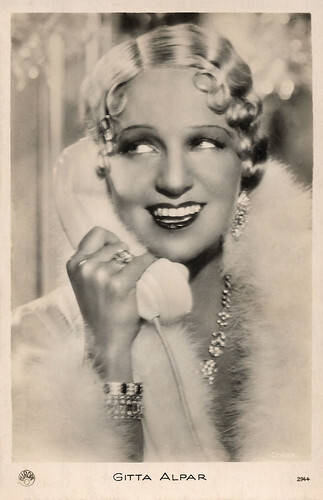
French postcard by Europe, no. 2944. Photo: Cinéma.
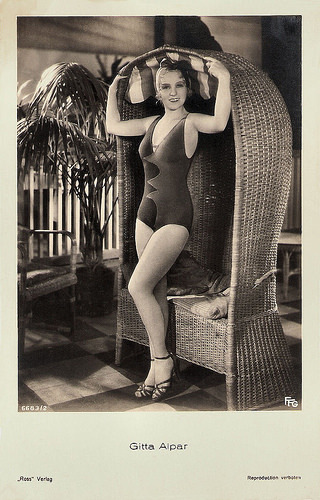
German postcard by Ross Verlag, no. 6683/2, 1931-1932. Photo: FFG.
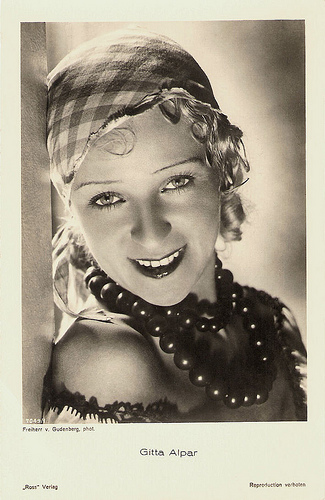
German postcard by Ross Verlag, no. 7049/1, 1932-1933. Photo: Frhr. von Gudenberg Phot.
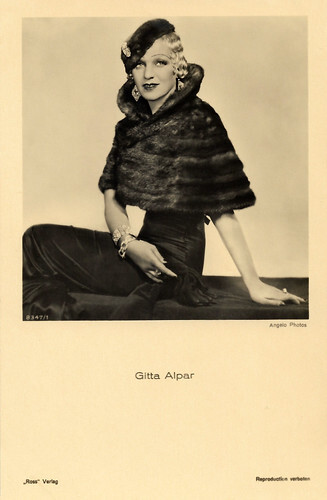
German postcard by Ross Verlag, no. 8347/1, 1933-1934. Photo: Angelo Photos, Budapest.
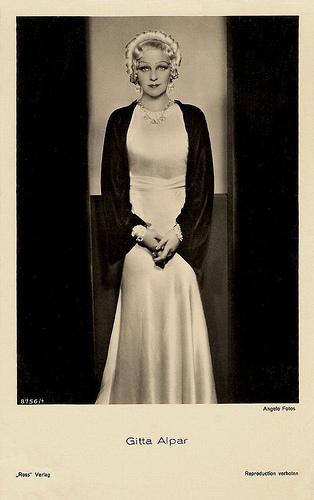
German postcard by Ross Verlag, no. 8756/1, 1933-1934. Photo: Angelo Fotos.
Opera
Gitta Alpár was born as Regina Klopfer in Budapest, Austria-Hungary (now Hungary) in 1903 as the daughter of a cantor, a clergy member who fills a diverse role within the Jewish community.
At 16, she studied singing and pianoforte at Liszt Ferenc Zeneművészeti Egyetem, the Conservatory of Budapest. With it, she laid the foundations for a successful singing career.
Her first public appearance as a coloratura soprano under the name of Alpár was in 1923 at the Magyar Állami Operaház (Hungarian State Opera House) in Budapest.
In 1927 she started to sing at the Wiener Staatsoper (Vienna State Opera). Her career there was promoted by eminent conductors such as Erich Kleiber. Her nickname was 'The Hungarian Nightingale'.
Later she moved on to Berlin, where she sang in operas like 'Die Zauberflöte' (The Magic Flute) by W.A. Mozart as the Queen of the Night, 'Il Barbiere di Siviglia' (The Barber of Seville) by Gioacchino Rossini, and 'Rigoletto' and 'La Traviata', both by Giuseppe Verdi.
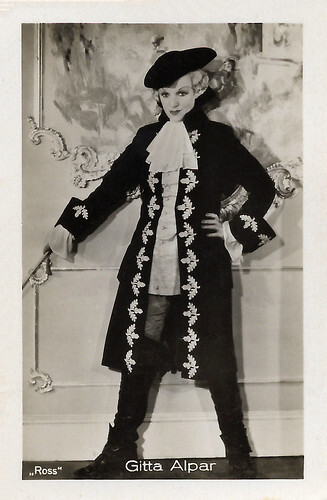
Small German collectors card by Ross Verlag.
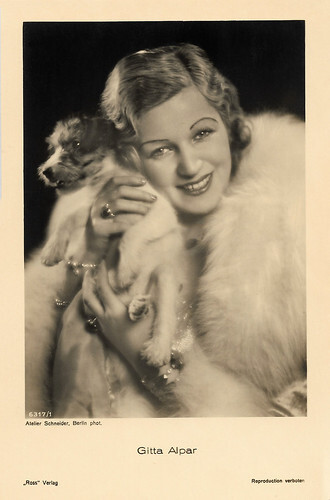
German postcard by Ross Verlag, no. 6317/1, 1931-1932. Photo: Atelier Schneider, Berlin.
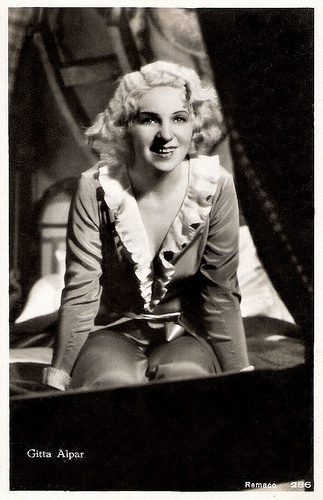
Dutch postcard by Remaco, no. 236. Publicity still for Gitta entdeckt ihr Herz/Gitta Discovers Her Heart (Carl Froelich, 1932).
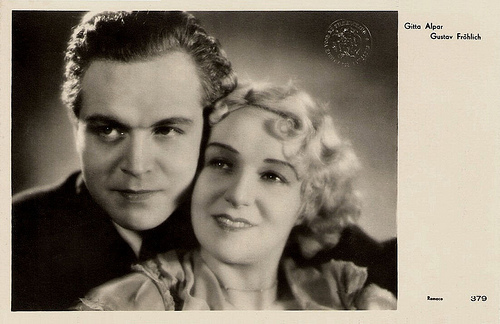
Dutch postcard by Jospe, no. 379. Photo: Remaco. Gitta Alpár and Gustav Fröhlich co-starred in Gitta entdeckt ihr Herz/Gitta discovers her heart (Carl Froelich, 1932).
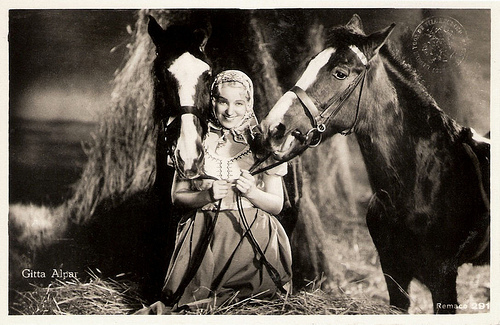
Dutch postcard by Remaco, no. 291. Photo: publicity still for Gitta entdeckt ihr Herz/Gitta Discovers Her Heart (Carl Froelich, 1932).
The new operetta diva
In 1930, Gitta Alpaá had a huge success in the operetta 'Der Bettelstudent' (The Beggar Student) by Carl Millocker at the Metropol Theater in Berlin, and she was hailed as 'the new operetta diva'.
At the Metropol Theater, she next created the role of Princess Elisabeth in the operetta 'Schön is die Welt' (The World is Beautiful, 1930), a reworking of 'Endlich allein' (Alone at Last) by Franz Lehár. Her co-star was Richard Tauber , and they recorded several excerpts for the Odeon Records company.
At the Admiralspalast in Berlin, she then played Marie Jeanne Bécu, a milliner, later Comtesse Dubarry in 'Die Dubarry' (The Dubarry, 1931), the radically revised version of 'Gräfin Dubarry' (Dubarry) by Carl Millöcker. The new version was prepared by Theo Mackeben with music from the original 'Gräfin Dubarry' as well as other works, and a new text was written by Paul Knepler, Ignaz Michael Welleminsky and Hans Martin Cremer.
Also in 1931, Gitta Alpar married film star Gustav Fröhlich , with whom she had a child, Julika Fröhlich. She had been married before to a businessman in Budapest.
The film industry became aware of the new darling of the public. For Carl Froelich-Film GmbH (FFG), she made films like Gitta entdeckt ihr Herz/Gitta Discovers Her Heart (Carl Froelich, 1932) with Gustav Fröhlich , and Die - oder keine/She, or Nobody (Carl Froelich, 1932), in which she co-starred with Max Hansen .
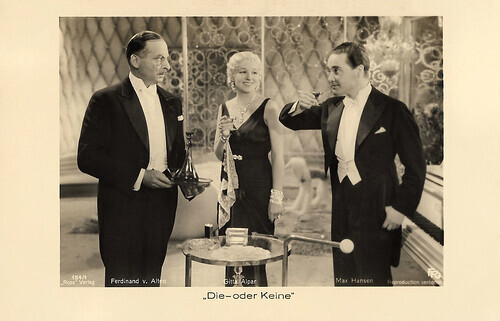
German postcard by Ross Verlag, no. 154/1. Photo: FFG (Carl Froelich Film Produktion). Ferdinand von Alten , Gitta Alpar and Max Hansen in Die - oder keine/She - or Nobody (Carl Froelich, 1932).
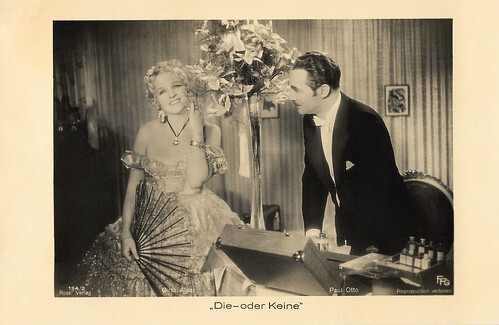
German postcard by Ross Verlag, no. 154/2. Photo: FFG. Gitta Alpar and Paul Otto in Die - oder keine/She, or Nobody (Carl Froelich, 1932).
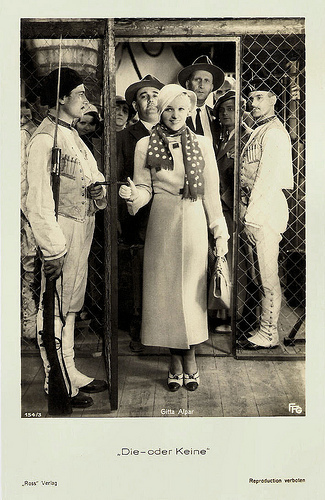
German postcard by Ross Verlag, no. 154/3. Photo: FFG. Publicity still for Die - oder keine/This One or None (Carl Froelich, 1932).
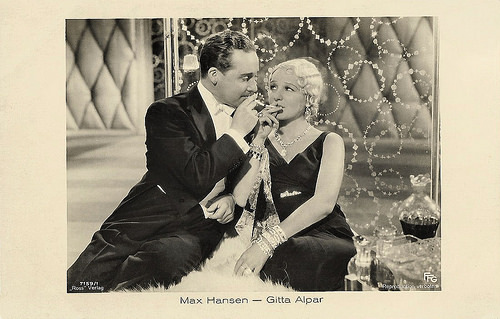
German postcard by Ross Verlag, no. 7159/1, 1932-1933. Photo: FFG. Publicity still for Die - oder keine/This One or None (Carl Froelich, 1932) with Max Hansen .
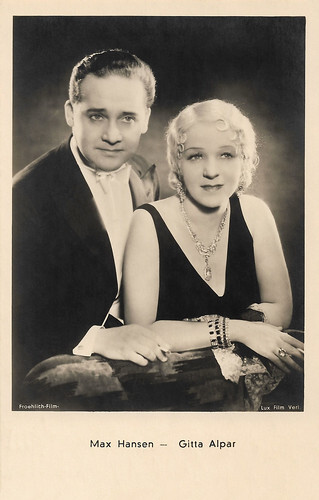
Austrian postcard by Iris Verlag, no. 6608. Photo: Froelich Film / Lux Film Verleih. Max Hansen and Gitta Alpar in Die - oder keine/She - or Nobody (Carl Froelich, 1932).
On Hitler's hit list
In 1932, Gitta Alpár had another stage success at the Großes Schauspielhaus, Berlin, when she created the part of Madeleine de Faublas in the operetta 'Ball im Savoy' (Ball at the Savoy) by Paul Abraham to a libretto by Alfred Grünwald and Fritz Löhner-Beda. This was Abraham's last major success, but also Alpár's. At the top of her success, Gitta Alpár's career abruptly came to an end because of the rise to power of Adolph Hitler. Alpár was Jewish and despite her popularity, she was forced to leave Germany. Alpár appeared on "Hitler's hit list", along with Charlie Chaplin and others, in the pages of the anti-semitic book, 'Juden sehen Dich an' by Johann von Leers. Her marriage to Gustav Fröhlich was dissolved in 1935 because it was illegal in National Socialist Germany. Fröhlich distanced from his wife because he didn't want to endanger his career. He later tried to apologise for his behaviour but Gitta Alpár could not answer his pleas. A circumstance which, according to IMDb , gave Fröhlich a hard time in his last leaving years and which beclouded his lust for life.
Alpár first emigrated to Austria where she took part in the film Ball im Savoy/Ball at Savoy (Steve Sekely, 1935) with Rose Barsony , another Jewish film actress who was forced to flee Nazi Germany. Alpár also acted in the British film I Give My Heart/The Loves of Madame Du Barry (Marcel Varnel, 1935), a faithful adaptation of the stage opera Die Dubarry (The Dubarry) with Owen Nares . Hal Erickson reviews at AllMovie : "The seamier aspects of DuBarry's rise to prominence (notably her brief stopover at a house of ill repute) are neatly glossed over, but that was to be expected. Among those responsible for adapting The Dubarry to the screen was Curt Siodmak. Curt and his brother Robert Siodmak went on to a rewarding Hollywood career".
Until 1936, Alpár worked in Austria, but then she had to emigrate again, first to Great Britain and one year later via Argentina to California. In Great Britain, Alpár appeared in Guilty Melody (Richard Pottier, 1936) with Nils Asther , and Everything in Life (J. Elder Wills, 1936). Guilty Melody (1936) was an alternative language version of the French film Le disque 413/Disk 413 (Richard Pottier, 1937) in which Alpar also starred, now opposite Jules Berry .
Her final film appearance was an appearance as an opera singer in the Universal Pictures period comedy/drama The Flame of New Orleans (René Clair, 1941) with Marlene Dietrich . Much of the film takes place with a background derived from Donizetti's Lucia, the love duet at the beginning of the opera. According to IMDb , her Hollywood career ultimately failed due to her heavy accent and poor command of the English language. In 1939 she married Niels Wessel Bagge. They divorced in 1951.
After the war, Gitta Alpár earned her living as a singing teacher. She seemed to be forgotten, but in 1987 Germany honoured her with the Filmband in Gold for her contributions to the German cinema. In 1991 Gitta Alpár passed away in Los Angeles, just before her 88th birthday.
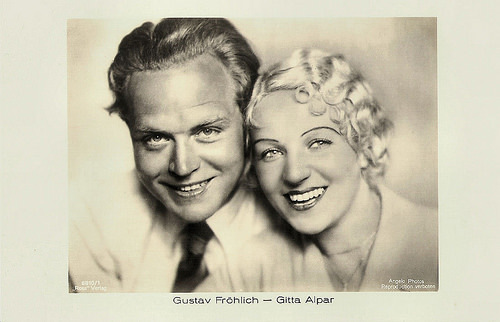
With Gustav Fröhlich . German postcard by Ross Verlag, no. 6810/1, 1931-1932. Photo: Angelo Photos.
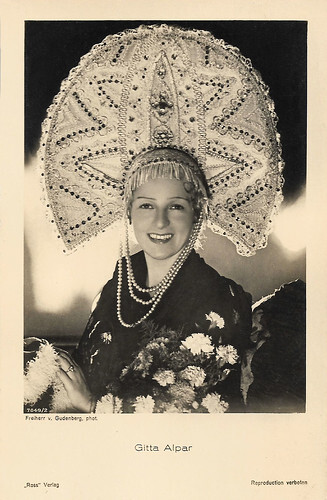
German postcard by Ross Verlag, no. 7049/2, 1932-1933. Photo: Frhr. von Gudenberg Phot. Gitta Alpár in the operetta `Katharina` (1932).
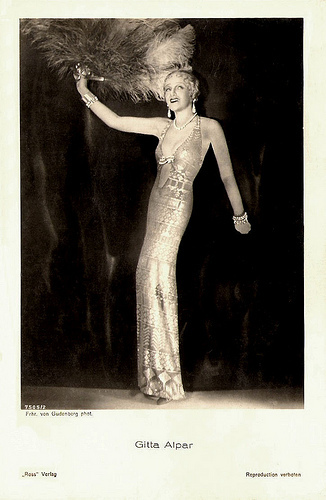
German postcard by Ross Verlag, no. 7505/2, 1932-1933. Photo: Frhr. von Gudenberg Phot.
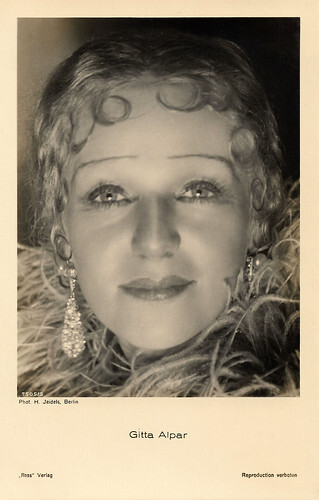
German postcard by Ross Verlag, no. 7505/3, 1932-1933. Photo: H. Jeidels, Berlin.
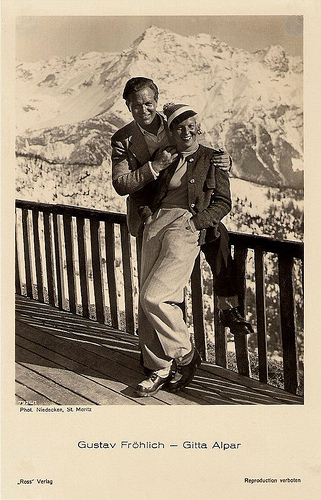
With Gustav Fröhlich . German postcard by Ross Verlag, no. 7926/1, 1932-1933. Photo: Niedecken, St. Moritz.
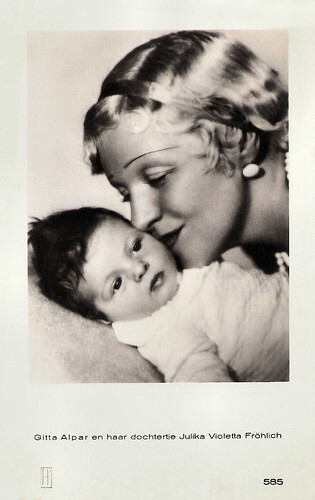
Dutch postcard by JosPe, no. 585. Sent by mail in 1935. Caption: Gitta Alper and her little daughter Julika Violetta Fröhlich.
Gitta Alpár sings In meinen weißen Armen in Ball im Savoy (1935). Source: Alparfan (YouTube).
Sources: Thomas Staedeli (Cyranos), Karin Nusko (Universität Wien - now defunct), Hal Erickson (AllMovie), Wikipedia and .

French postcard by Europe, no. 2944. Photo: Cinéma.

German postcard by Ross Verlag, no. 6683/2, 1931-1932. Photo: FFG.

German postcard by Ross Verlag, no. 7049/1, 1932-1933. Photo: Frhr. von Gudenberg Phot.

German postcard by Ross Verlag, no. 8347/1, 1933-1934. Photo: Angelo Photos, Budapest.

German postcard by Ross Verlag, no. 8756/1, 1933-1934. Photo: Angelo Fotos.
Opera
Gitta Alpár was born as Regina Klopfer in Budapest, Austria-Hungary (now Hungary) in 1903 as the daughter of a cantor, a clergy member who fills a diverse role within the Jewish community.
At 16, she studied singing and pianoforte at Liszt Ferenc Zeneművészeti Egyetem, the Conservatory of Budapest. With it, she laid the foundations for a successful singing career.
Her first public appearance as a coloratura soprano under the name of Alpár was in 1923 at the Magyar Állami Operaház (Hungarian State Opera House) in Budapest.
In 1927 she started to sing at the Wiener Staatsoper (Vienna State Opera). Her career there was promoted by eminent conductors such as Erich Kleiber. Her nickname was 'The Hungarian Nightingale'.
Later she moved on to Berlin, where she sang in operas like 'Die Zauberflöte' (The Magic Flute) by W.A. Mozart as the Queen of the Night, 'Il Barbiere di Siviglia' (The Barber of Seville) by Gioacchino Rossini, and 'Rigoletto' and 'La Traviata', both by Giuseppe Verdi.

Small German collectors card by Ross Verlag.

German postcard by Ross Verlag, no. 6317/1, 1931-1932. Photo: Atelier Schneider, Berlin.

Dutch postcard by Remaco, no. 236. Publicity still for Gitta entdeckt ihr Herz/Gitta Discovers Her Heart (Carl Froelich, 1932).

Dutch postcard by Jospe, no. 379. Photo: Remaco. Gitta Alpár and Gustav Fröhlich co-starred in Gitta entdeckt ihr Herz/Gitta discovers her heart (Carl Froelich, 1932).

Dutch postcard by Remaco, no. 291. Photo: publicity still for Gitta entdeckt ihr Herz/Gitta Discovers Her Heart (Carl Froelich, 1932).
The new operetta diva
In 1930, Gitta Alpaá had a huge success in the operetta 'Der Bettelstudent' (The Beggar Student) by Carl Millocker at the Metropol Theater in Berlin, and she was hailed as 'the new operetta diva'.
At the Metropol Theater, she next created the role of Princess Elisabeth in the operetta 'Schön is die Welt' (The World is Beautiful, 1930), a reworking of 'Endlich allein' (Alone at Last) by Franz Lehár. Her co-star was Richard Tauber , and they recorded several excerpts for the Odeon Records company.
At the Admiralspalast in Berlin, she then played Marie Jeanne Bécu, a milliner, later Comtesse Dubarry in 'Die Dubarry' (The Dubarry, 1931), the radically revised version of 'Gräfin Dubarry' (Dubarry) by Carl Millöcker. The new version was prepared by Theo Mackeben with music from the original 'Gräfin Dubarry' as well as other works, and a new text was written by Paul Knepler, Ignaz Michael Welleminsky and Hans Martin Cremer.
Also in 1931, Gitta Alpar married film star Gustav Fröhlich , with whom she had a child, Julika Fröhlich. She had been married before to a businessman in Budapest.
The film industry became aware of the new darling of the public. For Carl Froelich-Film GmbH (FFG), she made films like Gitta entdeckt ihr Herz/Gitta Discovers Her Heart (Carl Froelich, 1932) with Gustav Fröhlich , and Die - oder keine/She, or Nobody (Carl Froelich, 1932), in which she co-starred with Max Hansen .

German postcard by Ross Verlag, no. 154/1. Photo: FFG (Carl Froelich Film Produktion). Ferdinand von Alten , Gitta Alpar and Max Hansen in Die - oder keine/She - or Nobody (Carl Froelich, 1932).

German postcard by Ross Verlag, no. 154/2. Photo: FFG. Gitta Alpar and Paul Otto in Die - oder keine/She, or Nobody (Carl Froelich, 1932).

German postcard by Ross Verlag, no. 154/3. Photo: FFG. Publicity still for Die - oder keine/This One or None (Carl Froelich, 1932).

German postcard by Ross Verlag, no. 7159/1, 1932-1933. Photo: FFG. Publicity still for Die - oder keine/This One or None (Carl Froelich, 1932) with Max Hansen .

Austrian postcard by Iris Verlag, no. 6608. Photo: Froelich Film / Lux Film Verleih. Max Hansen and Gitta Alpar in Die - oder keine/She - or Nobody (Carl Froelich, 1932).
On Hitler's hit list
In 1932, Gitta Alpár had another stage success at the Großes Schauspielhaus, Berlin, when she created the part of Madeleine de Faublas in the operetta 'Ball im Savoy' (Ball at the Savoy) by Paul Abraham to a libretto by Alfred Grünwald and Fritz Löhner-Beda. This was Abraham's last major success, but also Alpár's. At the top of her success, Gitta Alpár's career abruptly came to an end because of the rise to power of Adolph Hitler. Alpár was Jewish and despite her popularity, she was forced to leave Germany. Alpár appeared on "Hitler's hit list", along with Charlie Chaplin and others, in the pages of the anti-semitic book, 'Juden sehen Dich an' by Johann von Leers. Her marriage to Gustav Fröhlich was dissolved in 1935 because it was illegal in National Socialist Germany. Fröhlich distanced from his wife because he didn't want to endanger his career. He later tried to apologise for his behaviour but Gitta Alpár could not answer his pleas. A circumstance which, according to IMDb , gave Fröhlich a hard time in his last leaving years and which beclouded his lust for life.
Alpár first emigrated to Austria where she took part in the film Ball im Savoy/Ball at Savoy (Steve Sekely, 1935) with Rose Barsony , another Jewish film actress who was forced to flee Nazi Germany. Alpár also acted in the British film I Give My Heart/The Loves of Madame Du Barry (Marcel Varnel, 1935), a faithful adaptation of the stage opera Die Dubarry (The Dubarry) with Owen Nares . Hal Erickson reviews at AllMovie : "The seamier aspects of DuBarry's rise to prominence (notably her brief stopover at a house of ill repute) are neatly glossed over, but that was to be expected. Among those responsible for adapting The Dubarry to the screen was Curt Siodmak. Curt and his brother Robert Siodmak went on to a rewarding Hollywood career".
Until 1936, Alpár worked in Austria, but then she had to emigrate again, first to Great Britain and one year later via Argentina to California. In Great Britain, Alpár appeared in Guilty Melody (Richard Pottier, 1936) with Nils Asther , and Everything in Life (J. Elder Wills, 1936). Guilty Melody (1936) was an alternative language version of the French film Le disque 413/Disk 413 (Richard Pottier, 1937) in which Alpar also starred, now opposite Jules Berry .
Her final film appearance was an appearance as an opera singer in the Universal Pictures period comedy/drama The Flame of New Orleans (René Clair, 1941) with Marlene Dietrich . Much of the film takes place with a background derived from Donizetti's Lucia, the love duet at the beginning of the opera. According to IMDb , her Hollywood career ultimately failed due to her heavy accent and poor command of the English language. In 1939 she married Niels Wessel Bagge. They divorced in 1951.
After the war, Gitta Alpár earned her living as a singing teacher. She seemed to be forgotten, but in 1987 Germany honoured her with the Filmband in Gold for her contributions to the German cinema. In 1991 Gitta Alpár passed away in Los Angeles, just before her 88th birthday.

With Gustav Fröhlich . German postcard by Ross Verlag, no. 6810/1, 1931-1932. Photo: Angelo Photos.

German postcard by Ross Verlag, no. 7049/2, 1932-1933. Photo: Frhr. von Gudenberg Phot. Gitta Alpár in the operetta `Katharina` (1932).

German postcard by Ross Verlag, no. 7505/2, 1932-1933. Photo: Frhr. von Gudenberg Phot.

German postcard by Ross Verlag, no. 7505/3, 1932-1933. Photo: H. Jeidels, Berlin.

With Gustav Fröhlich . German postcard by Ross Verlag, no. 7926/1, 1932-1933. Photo: Niedecken, St. Moritz.

Dutch postcard by JosPe, no. 585. Sent by mail in 1935. Caption: Gitta Alper and her little daughter Julika Violetta Fröhlich.
Gitta Alpár sings In meinen weißen Armen in Ball im Savoy (1935). Source: Alparfan (YouTube).
Sources: Thomas Staedeli (Cyranos), Karin Nusko (Universität Wien - now defunct), Hal Erickson (AllMovie), Wikipedia and .
Published on June 26, 2023 22:00
June 25, 2023
Rouben Mamoulian: A Touch of Desire
Known for his ability to encode his vision in light, movement, and later in colour, the Tbilisi-born Armenian Rouben Mamoulian had one of the most consistent bodies of work in American cinema. Rightly celebrated for his invaluable contribution to Hollywood’s transition to sound, he both unchained the camera and used dialogue like a work of musical accompaniment. His mobile camera was envied and imitated, and his style is instantly recognisable for its sophistication, humour and erotic undertone. Mamoulian was equally efficient in more sombre types of cinema, serving as a pioneering figure in both gangster and horror genres.
Il Cinema Ritrovato 2023 presents a career retrospective, curated by Ehsan Khoshbakht, that showcases Mamoulian’s work from his only silent film, to the early sound period, to his final musical, in colour and CinemaScope.

British postcard. Photo: Paramount Pictures. Marlene Dietrich in The Song of Songs (Rouben Mamoulian, 1933).
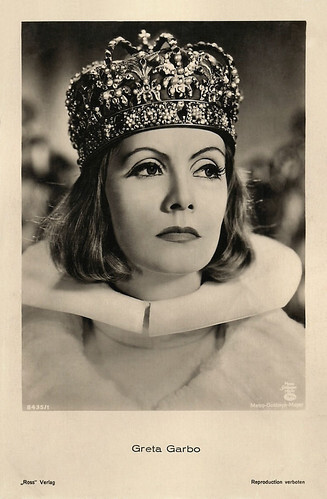
German postcard by Ross Verlag, no. 8435/1, 1933-1934. Photo: Metro-Goldwyn-Mayer. Greta Garbo in Queen Christina (Rouben Mamoulian, 1933).
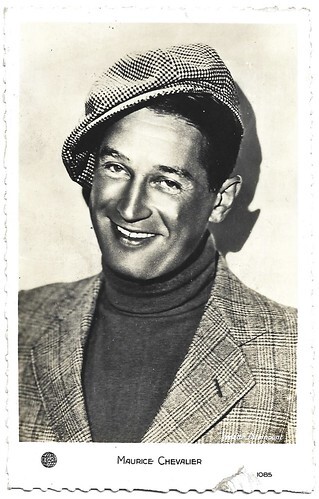
French postcard by EDUG, no. 1085. Photo: Paramount. Maurice Chevalier dressed as 'apache' at the costumed ball in Love Me Tonight (Rouben Mamoulian, 1932).
[image error]
British card. Photo: United Artists. Anna Sten in We Live Again (Rouben Mamoulian, 1934), an adaptation of Leo Tolstoy's 1899 novel 'Resurrection'.
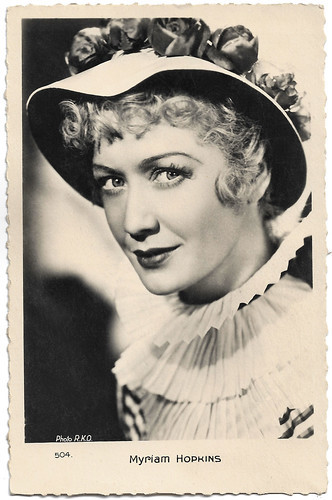
French postcard by Editions EC, Paris, no. 504. Photo: RKO. Miriam Hopkins in Becky Sharp (Rouben Mamoulian, 1935).
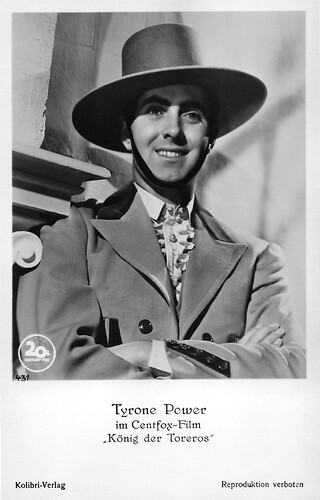
German postcard by Kolibri-Verlag. Photo: Twentieth Century Fox. Tyrone Power in Blood and Sand (Rouben Mamoulian, 1941).
Revolutionary use of interior dialogue
Rouben Zachary Mamoulian (Armenian: Ռուբէն Մամուլեան) was born in Tiflis, Russian Empire (now Tbilisi, Republic of Georgia), in 1897. His mother, Virginia (née Kalantarian), was a director of the Armenian theatre, and his father, Zachary Mamoulian, was a bank president. Mamoulian spent part of his childhood in Paris. He studied criminology at the University of Moscow and later, he studied acting, dramaturgy and directing with Constantin Stanislavsky and Yevgeny Vakhtangov. In 1918 he founded his own stage in Tbilisi. In 1920, he went on a tour of England and decided to stay there. He spent three years in London taking acting and drama classes and in 1922 he made his debut as a stage director.
Mamoulian was brought to the United States in 1923 by Vladimir Rosing to teach at the Eastman School of Music, the music school of the University of Rochester. There he was involved in directing opera and theatre. In 1925, Mamoulian was head of the School of Drama, where Martha Graham was working at the time. Among other performances, together they produced a short, two-colour film titled The Flute of Krishna, featuring Eastman students. By 1926 he was teaching at the New York Theatre Guild, where he staged a critically admired performance of 'Porgy and Bess' in 1927. In 1929 he took over the direction of the early sound film Applause (1929), which was filmed at Paramount's Astoria Studios in New York. The musical starred Helen Morgan in the leading role. The film was highly praised by critics for its innovative use of sound and dialogue to dramatise the story. In 1931 he went to Hollywood with a contract at Paramount to make City Streets (1931) starring Gary Cooper and Sylvia Sidney . German Wikipedia: "The camerawork of this crime film is fluid, almost as if shot with a handheld camera, and the use of interior dialogue is revolutionary for the time".
Mamoulian broke through with the drama Dr Jekyll and Mr Hyde (1931) based on the novel 'The Strange Case of Dr Jekyll and Mr Hyde' (1886) by Scottish author Robert Louis Stevenson. Fredric March won an Oscar for Best Actor in a Leading Role as Dr. Henry Jekyll and Miriam Hopkins as Ivy Pearson. The scenes between March and Hopkins, balancing violence and sexuality, made Mamoulian the most-talked-about director of the year. Another artistic and financial success was the slightly frivolous social comedy Love Me Tonight (1932) with Maurice Chevalier and Jeanette MacDonald. Some critics praised Mamoulian for beating Ernst Lubitsch on his own ground. The studio entrusted Mamoulian with directing Marlene Dietrich in Song of Songs (1933). Dietrich's career was in crisis and this would be her first American film without the participation of Josef von Sternberg . Song of Songs tells the story of a peasant girl who, after many erotic adventures, finally finds true happiness. The story had already been filmed a few years earlier as a silent movie with Pola Negri. Most critics thought the studio should have left it at that.
Mamoulian's prestige was so great that Louis B. Mayer personally lobbied to lend him to MGM for Greta Garbo 's comeback after an eighteen-month absence from the screen. Queen Christine (1933) was a very vague biopic of Queen Christine of Sweden, with only a rudimentary reference to the actual events that led to the Queen's abdication. Produced at great expense, it contains two of Mamoulian's most famous scenes: the "I remember room" sequence, in which Garbo moves silently through a room to the beat of a metronome, touching all the objects to preserve the magic of the moment. And the final scene, in which only the actress' completely blank, expressionless face appears on the screen. With a profit of $650,000, Queen Christine was instrumental in getting MGM solvent through the film industry's toughest year ever economically.
Producer Samuel Goldwyn hired Mamoulian the following year to turn his protégée Anna Sten into Hollywood's biggest dramatic star. We Live Again, loosely based on Tolstoy's tale 'Resurrection' was disappointing artistically and financially. The next film, the first feature-length film in three-strip Technicolor film, Becky Sharp, the adaptation of the novel 'Vanity Fair' (1847-1848) by William Makepeace Thackeray, was also technically innovative and stylistic, but financially and artistically a flop. The Duchess's Ball before the Battle of Waterloo became proof that the deliberate use of colour could heighten the dramaturgy of scenes. Over the next few years, Mamoulian made a number of films in a wide variety of genres, but none of them could match the quality of the early 1930s.
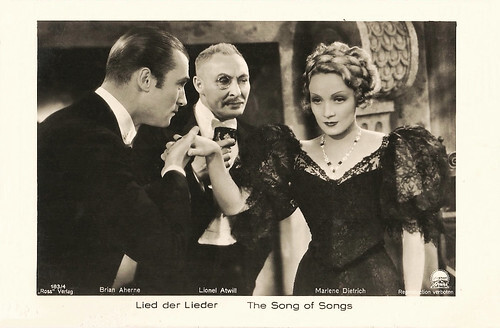
German postcard by Ross Verlag, no. 183/4. Photo: Paramount. Brian Aherne (Richard), Lionel Atwill (Baron von Merzbach) and Marlene Dietrich (Lily) in The Song of Songs (Rouben Mamoulian, 1933). Dietrich is a naive peasant girl who models (naked) for a sculptor and falls in love with him. A rich baron, the sculptor's client, presses the artist to leave the girl to him. The baron turns her into a lady, but, incidentally, in a world-wise woman too. He invites the sculptor to show Lily's metamorphosis. Lily is terribly hurt by both men.
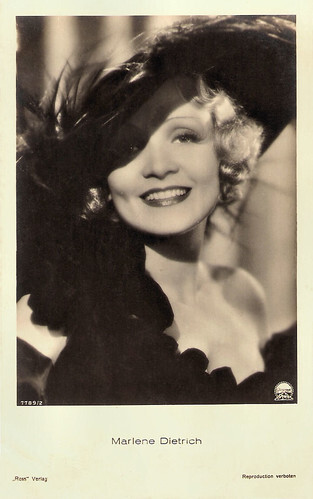
German postcard by Ross Verlag, no. 7789/2, 1932-1933. Photo: Paramount. Marlene Dietrich in Song of Songs (Rouben Mamoulian, 1933).
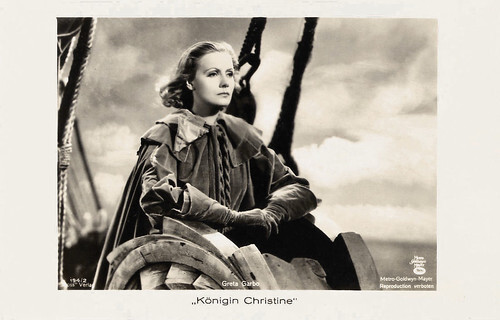
German postcard by Ross Verlag, no. 194/2. Photo: Metro-Goldwyn-Mayer (MGM). Greta Garbo in Queen Christina (Rouben Mamoulian, 1933).
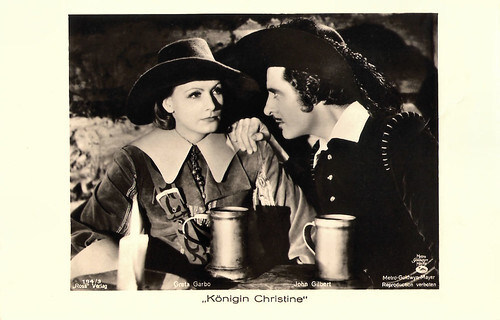
German postcard by Ross Verlag, no. 194/3. Photo: MGM. Greta Garbo and John Gilbert in Queen Christina (Rouben Mamoulian, 1933).
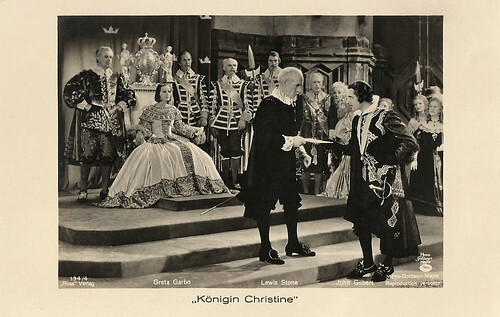
German postcard by Ross Verlag, no. 194/4. Photo: Metro-Goldwyn-Mayer. Greta Garbo , Lewis Stone and John Gilbert in Queen Christina (Rouben Mamoulian, 1933).
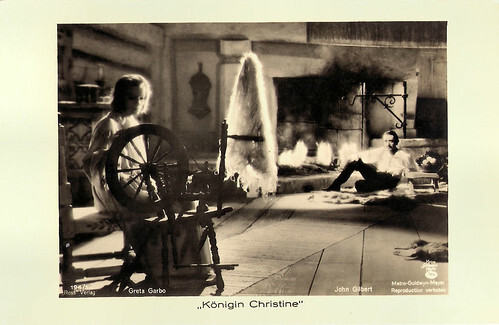
German postcard by Ross Verlag, no. 194/5. Photo: MGM. Greta Garbo and John Gilbert in Queen Christina (Rouben Mamoulian, 1933).
Problems with the studio bosses
Rouben Mamoulian directed Tyrone Power in the cloak-and-dagger epic In the Sign of Zorro (1940) also starring Linda Darnell and Basil Rathbone . The film was characterised by elegant camera work and fluid staging. It was followed by Blood and Sand (1941), about bullfighting, shot again with Power now opposite Rita Hayworth . Blood and Sand was filmed in Technicolor, and used colour schemes based on the work of Spanish artists such as Francisco Goya, Diego Velázquez and El Greco.
After World War II, Rouben Mamoulian's films included the musicals Summer Holiday (1948) with Mickey Rooney and Gloria DeHaven and Silk Stockings (1957). Summer Holiday was based on the play 'Ah, Wilderness!' (1933) by American author Eugene O'Neill. Both musicals are particularly noteworthy for their incorporation of song and dance interludes into the staging of the action.
Silk Stockings (1957), starring Fred Astaire and Cyd Charisse , is based on the 1955 Broadway musical of the same name by Cole Porter. This musical was itself based on Ernst Lubitsch 's film Ninotchka (1939) with Greta Garbo . Silk Stockings was a success, bringing in 4.4 million worldwide. The film was nominated for two Golden Globes (best film and best actress). Silk Stockings (1957) marked Fred Astaire 's provisional last appearance as a dancer in a musical and his last film for MGM. It was also the last MGM film musical to be shot in its entirety at Culver City's MGM studios and it was Rouben Mamoulian's last film.
Mamoulian made just 16 films in 29 years. He often had problems with the studio bosses. In 1944, for example, he was replaced by Otto Preminger in the middle of filming Laura. In 1958, he also lost the direction of Porgy and Bess to Preminger. His involvement in 1959 in the mammoth venture Cleopatra (1961), with Elizabeth Taylor as the Egyptian queen, also ended in his sacking. The finished film, which was to see many directorial changes, contains a good ten-minute segment still directed by Mamoulian.
Over the years, Mamoulian returned again and again to Broadway, where he was responsible for some of the most spectacular productions ever. In particular, his production of 'Oklahoma!' in 1943, with Agnes de Mille as the choreographer in charge, revolutionised the staging of musicals overnight. The play ran for 2,212 performances between 1943 and 1948. 'Carousel' from 1945 was also a great artistic success. In 1964 he wrote the children's book 'Abigayil' and in 1965 'Hamlet Revised and Interpreted'. In 1982, the Directors Guild of America presented him with the D.W. Griffith Award. In 1987, Rouben Mamoulian passed away at the Motion Picture & Television Country House and Hospital of natural causes at the age of 90 in Woodland Hills, California. He had been married to Azida Newman since 1945.
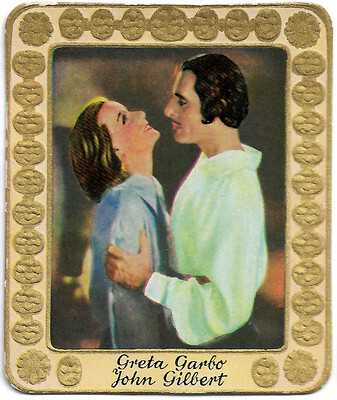
German collectors card in the Moderne Schönheitsgalerie by Ross Verlag for Edelzigarette Kurmark, series 2, no. 47 (of 300). Photo: Metro-Goldwyn-Mayer. Greta Garbo and John Gilbert in Queen Christina (Rouben Mamoulian, 1933).
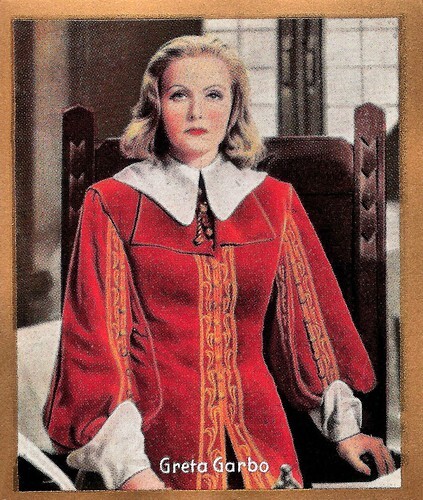
German cigarette card in the series Unsere Bunten Filmbilder by Ross Verlag for Cigarettenfabrik Josetti, Berlin, no. 23. Photo: Metro-Goldwyn-Mayer. Greta Garbo in Queen Christina (Rouben Mamoulian, 1933).
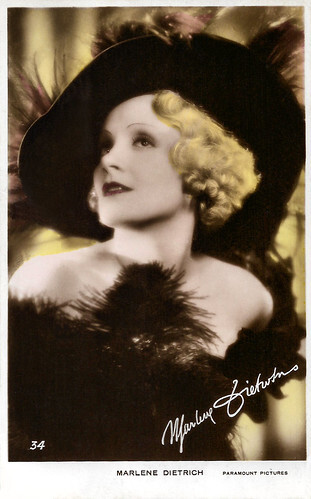
British postcard, no. 34. Photo: Paramount Pictures. Marlene Dietrich in the American pre-Code movie The Song of Songs (Rouben Mamoulian, 1932), based on 'Das hohe Lied' by German author Hermann Sudermann.
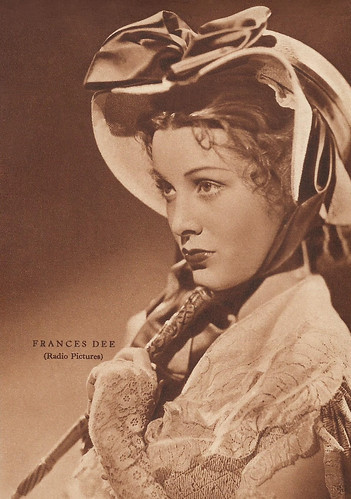
Italian postcard by Rizzoli & C. Milano, 1938. Photo: Radio Pictures (RKO). Frances Dee in Becky Sharp (Rouben Mamoulian, 1935).
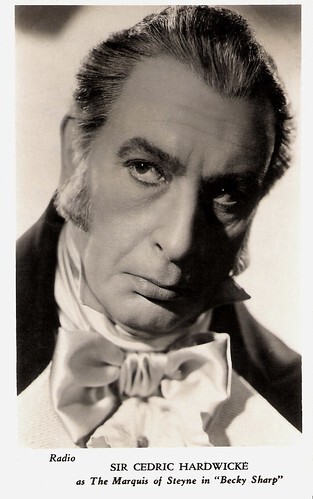
British postcard. Photo: Radio. Cedric Hardwicke in Becky Sharp (Rouben Mamoulian, 1935).

Belgian collectors card by Kwatta, Bois d'Haine, no. C. 172. Photo: MGM. Mickey Rooney and Gloria DeHaven in Summer Holiday (Rouben Mamoulian, 1948).
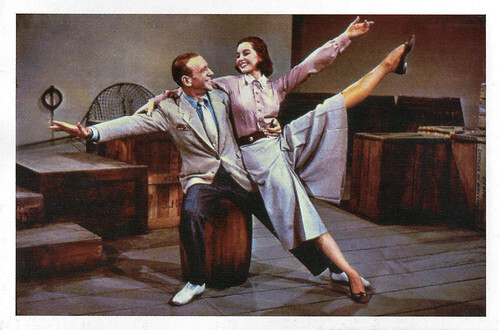
French postcard in the Collection Cinéstar. Fred Astaire and Cyd Charisse in Silk Stockings (Rouben Mamoulian, 1957).
Sources: Il Cinema Ritrovato, Wikipedia (Dutch, German and English) and .
Il Cinema Ritrovato 2023 presents a career retrospective, curated by Ehsan Khoshbakht, that showcases Mamoulian’s work from his only silent film, to the early sound period, to his final musical, in colour and CinemaScope.

British postcard. Photo: Paramount Pictures. Marlene Dietrich in The Song of Songs (Rouben Mamoulian, 1933).

German postcard by Ross Verlag, no. 8435/1, 1933-1934. Photo: Metro-Goldwyn-Mayer. Greta Garbo in Queen Christina (Rouben Mamoulian, 1933).

French postcard by EDUG, no. 1085. Photo: Paramount. Maurice Chevalier dressed as 'apache' at the costumed ball in Love Me Tonight (Rouben Mamoulian, 1932).
[image error]
British card. Photo: United Artists. Anna Sten in We Live Again (Rouben Mamoulian, 1934), an adaptation of Leo Tolstoy's 1899 novel 'Resurrection'.

French postcard by Editions EC, Paris, no. 504. Photo: RKO. Miriam Hopkins in Becky Sharp (Rouben Mamoulian, 1935).

German postcard by Kolibri-Verlag. Photo: Twentieth Century Fox. Tyrone Power in Blood and Sand (Rouben Mamoulian, 1941).
Revolutionary use of interior dialogue
Rouben Zachary Mamoulian (Armenian: Ռուբէն Մամուլեան) was born in Tiflis, Russian Empire (now Tbilisi, Republic of Georgia), in 1897. His mother, Virginia (née Kalantarian), was a director of the Armenian theatre, and his father, Zachary Mamoulian, was a bank president. Mamoulian spent part of his childhood in Paris. He studied criminology at the University of Moscow and later, he studied acting, dramaturgy and directing with Constantin Stanislavsky and Yevgeny Vakhtangov. In 1918 he founded his own stage in Tbilisi. In 1920, he went on a tour of England and decided to stay there. He spent three years in London taking acting and drama classes and in 1922 he made his debut as a stage director.
Mamoulian was brought to the United States in 1923 by Vladimir Rosing to teach at the Eastman School of Music, the music school of the University of Rochester. There he was involved in directing opera and theatre. In 1925, Mamoulian was head of the School of Drama, where Martha Graham was working at the time. Among other performances, together they produced a short, two-colour film titled The Flute of Krishna, featuring Eastman students. By 1926 he was teaching at the New York Theatre Guild, where he staged a critically admired performance of 'Porgy and Bess' in 1927. In 1929 he took over the direction of the early sound film Applause (1929), which was filmed at Paramount's Astoria Studios in New York. The musical starred Helen Morgan in the leading role. The film was highly praised by critics for its innovative use of sound and dialogue to dramatise the story. In 1931 he went to Hollywood with a contract at Paramount to make City Streets (1931) starring Gary Cooper and Sylvia Sidney . German Wikipedia: "The camerawork of this crime film is fluid, almost as if shot with a handheld camera, and the use of interior dialogue is revolutionary for the time".
Mamoulian broke through with the drama Dr Jekyll and Mr Hyde (1931) based on the novel 'The Strange Case of Dr Jekyll and Mr Hyde' (1886) by Scottish author Robert Louis Stevenson. Fredric March won an Oscar for Best Actor in a Leading Role as Dr. Henry Jekyll and Miriam Hopkins as Ivy Pearson. The scenes between March and Hopkins, balancing violence and sexuality, made Mamoulian the most-talked-about director of the year. Another artistic and financial success was the slightly frivolous social comedy Love Me Tonight (1932) with Maurice Chevalier and Jeanette MacDonald. Some critics praised Mamoulian for beating Ernst Lubitsch on his own ground. The studio entrusted Mamoulian with directing Marlene Dietrich in Song of Songs (1933). Dietrich's career was in crisis and this would be her first American film without the participation of Josef von Sternberg . Song of Songs tells the story of a peasant girl who, after many erotic adventures, finally finds true happiness. The story had already been filmed a few years earlier as a silent movie with Pola Negri. Most critics thought the studio should have left it at that.
Mamoulian's prestige was so great that Louis B. Mayer personally lobbied to lend him to MGM for Greta Garbo 's comeback after an eighteen-month absence from the screen. Queen Christine (1933) was a very vague biopic of Queen Christine of Sweden, with only a rudimentary reference to the actual events that led to the Queen's abdication. Produced at great expense, it contains two of Mamoulian's most famous scenes: the "I remember room" sequence, in which Garbo moves silently through a room to the beat of a metronome, touching all the objects to preserve the magic of the moment. And the final scene, in which only the actress' completely blank, expressionless face appears on the screen. With a profit of $650,000, Queen Christine was instrumental in getting MGM solvent through the film industry's toughest year ever economically.
Producer Samuel Goldwyn hired Mamoulian the following year to turn his protégée Anna Sten into Hollywood's biggest dramatic star. We Live Again, loosely based on Tolstoy's tale 'Resurrection' was disappointing artistically and financially. The next film, the first feature-length film in three-strip Technicolor film, Becky Sharp, the adaptation of the novel 'Vanity Fair' (1847-1848) by William Makepeace Thackeray, was also technically innovative and stylistic, but financially and artistically a flop. The Duchess's Ball before the Battle of Waterloo became proof that the deliberate use of colour could heighten the dramaturgy of scenes. Over the next few years, Mamoulian made a number of films in a wide variety of genres, but none of them could match the quality of the early 1930s.

German postcard by Ross Verlag, no. 183/4. Photo: Paramount. Brian Aherne (Richard), Lionel Atwill (Baron von Merzbach) and Marlene Dietrich (Lily) in The Song of Songs (Rouben Mamoulian, 1933). Dietrich is a naive peasant girl who models (naked) for a sculptor and falls in love with him. A rich baron, the sculptor's client, presses the artist to leave the girl to him. The baron turns her into a lady, but, incidentally, in a world-wise woman too. He invites the sculptor to show Lily's metamorphosis. Lily is terribly hurt by both men.

German postcard by Ross Verlag, no. 7789/2, 1932-1933. Photo: Paramount. Marlene Dietrich in Song of Songs (Rouben Mamoulian, 1933).

German postcard by Ross Verlag, no. 194/2. Photo: Metro-Goldwyn-Mayer (MGM). Greta Garbo in Queen Christina (Rouben Mamoulian, 1933).

German postcard by Ross Verlag, no. 194/3. Photo: MGM. Greta Garbo and John Gilbert in Queen Christina (Rouben Mamoulian, 1933).

German postcard by Ross Verlag, no. 194/4. Photo: Metro-Goldwyn-Mayer. Greta Garbo , Lewis Stone and John Gilbert in Queen Christina (Rouben Mamoulian, 1933).

German postcard by Ross Verlag, no. 194/5. Photo: MGM. Greta Garbo and John Gilbert in Queen Christina (Rouben Mamoulian, 1933).
Problems with the studio bosses
Rouben Mamoulian directed Tyrone Power in the cloak-and-dagger epic In the Sign of Zorro (1940) also starring Linda Darnell and Basil Rathbone . The film was characterised by elegant camera work and fluid staging. It was followed by Blood and Sand (1941), about bullfighting, shot again with Power now opposite Rita Hayworth . Blood and Sand was filmed in Technicolor, and used colour schemes based on the work of Spanish artists such as Francisco Goya, Diego Velázquez and El Greco.
After World War II, Rouben Mamoulian's films included the musicals Summer Holiday (1948) with Mickey Rooney and Gloria DeHaven and Silk Stockings (1957). Summer Holiday was based on the play 'Ah, Wilderness!' (1933) by American author Eugene O'Neill. Both musicals are particularly noteworthy for their incorporation of song and dance interludes into the staging of the action.
Silk Stockings (1957), starring Fred Astaire and Cyd Charisse , is based on the 1955 Broadway musical of the same name by Cole Porter. This musical was itself based on Ernst Lubitsch 's film Ninotchka (1939) with Greta Garbo . Silk Stockings was a success, bringing in 4.4 million worldwide. The film was nominated for two Golden Globes (best film and best actress). Silk Stockings (1957) marked Fred Astaire 's provisional last appearance as a dancer in a musical and his last film for MGM. It was also the last MGM film musical to be shot in its entirety at Culver City's MGM studios and it was Rouben Mamoulian's last film.
Mamoulian made just 16 films in 29 years. He often had problems with the studio bosses. In 1944, for example, he was replaced by Otto Preminger in the middle of filming Laura. In 1958, he also lost the direction of Porgy and Bess to Preminger. His involvement in 1959 in the mammoth venture Cleopatra (1961), with Elizabeth Taylor as the Egyptian queen, also ended in his sacking. The finished film, which was to see many directorial changes, contains a good ten-minute segment still directed by Mamoulian.
Over the years, Mamoulian returned again and again to Broadway, where he was responsible for some of the most spectacular productions ever. In particular, his production of 'Oklahoma!' in 1943, with Agnes de Mille as the choreographer in charge, revolutionised the staging of musicals overnight. The play ran for 2,212 performances between 1943 and 1948. 'Carousel' from 1945 was also a great artistic success. In 1964 he wrote the children's book 'Abigayil' and in 1965 'Hamlet Revised and Interpreted'. In 1982, the Directors Guild of America presented him with the D.W. Griffith Award. In 1987, Rouben Mamoulian passed away at the Motion Picture & Television Country House and Hospital of natural causes at the age of 90 in Woodland Hills, California. He had been married to Azida Newman since 1945.

German collectors card in the Moderne Schönheitsgalerie by Ross Verlag for Edelzigarette Kurmark, series 2, no. 47 (of 300). Photo: Metro-Goldwyn-Mayer. Greta Garbo and John Gilbert in Queen Christina (Rouben Mamoulian, 1933).

German cigarette card in the series Unsere Bunten Filmbilder by Ross Verlag for Cigarettenfabrik Josetti, Berlin, no. 23. Photo: Metro-Goldwyn-Mayer. Greta Garbo in Queen Christina (Rouben Mamoulian, 1933).

British postcard, no. 34. Photo: Paramount Pictures. Marlene Dietrich in the American pre-Code movie The Song of Songs (Rouben Mamoulian, 1932), based on 'Das hohe Lied' by German author Hermann Sudermann.

Italian postcard by Rizzoli & C. Milano, 1938. Photo: Radio Pictures (RKO). Frances Dee in Becky Sharp (Rouben Mamoulian, 1935).

British postcard. Photo: Radio. Cedric Hardwicke in Becky Sharp (Rouben Mamoulian, 1935).

Belgian collectors card by Kwatta, Bois d'Haine, no. C. 172. Photo: MGM. Mickey Rooney and Gloria DeHaven in Summer Holiday (Rouben Mamoulian, 1948).

French postcard in the Collection Cinéstar. Fred Astaire and Cyd Charisse in Silk Stockings (Rouben Mamoulian, 1957).
Sources: Il Cinema Ritrovato, Wikipedia (Dutch, German and English) and .
Published on June 25, 2023 22:00
June 24, 2023
One Hundred Years Ago: L’ombra (1923)
Now in its 20th anniversary year, the One Hundred Years Ago section at Il Cinema Ritrovato continues its annual exploration of a single year in cinema’s rich and varied history with a selection of enduring classics and archival rarities as well as thought-provoking documentaries from 1923. The Italian silent melodrama L'ombra/The Shadow (1923) was one of the final Diva films in which Italia Almirante (Manzini) was directed by her husband, Mario Almirante for Alba Film. The film, based on a play by Dario Niccodemi, co-starred Alberto Collo, Liliana Ardea, Oreste Bilancia, Andrea Habay and Vittorio Pieri. EFSP's Ivo Blom wrote for the festival catalogue about the film.
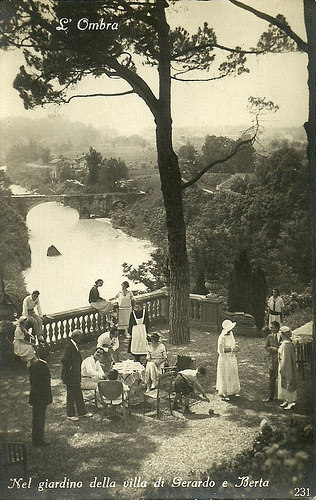
Italian postcard by Ed. Ballerini & Fratini, Firenze, no. 231. Photo: Alba Film. Publicity still for L'ombra (Mario Almirante, 1923). Caption: "In the garden of the villa of Gerardo and Berta".
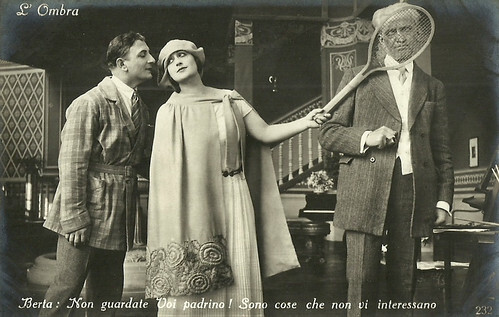
Italian postcard by Ed. Ballerini & Fratini, Firenze, no. 232. Photo: Alba Film. Italia Almirante Manzini as Berta, Alberto Collo as Gerardo and Vittorio Pieri as Berta's godfather Michele in L'ombra (Mario Almirante, 1923). Caption: "Berta: Don't look, godfather! These are matters which don't concern you."
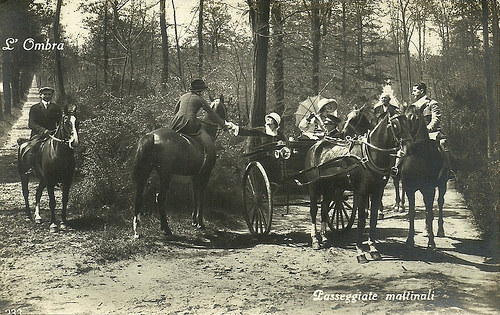
Italian postcard by Ed. Ballerini & Fratini, Firenze, no. 233. Photo: Alba Film. Publicity still for L'ombra (Mario Almirante). Caption: Morning strolls.
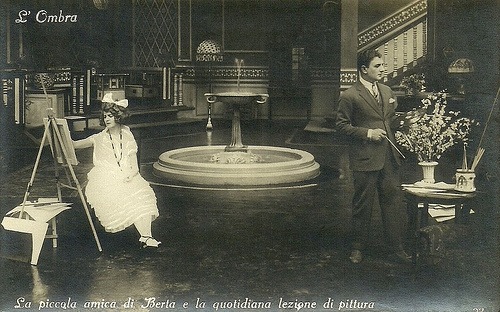
Italian postcard by Ed. Ballerini & Fratini, Firenze, no. 23?. Photo: Alba Film. Publicity still for L'ombra (Mario Almirante, 1923) with Liliana Ardea as Elena and Alberto Collo as Gerardo. Caption: "Berta's little friend and the daily painting lesson".
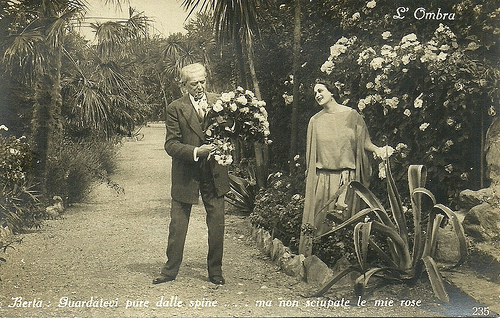
Italian postcard by Ed. Ballerini & Fratini, Firenze, no. 235. Photo: Alba Film. Publicity still for L'ombra (Mario Almirante, 1923), with Italia Almirante Manzini as Berta and Vittorio Pieri as Berta's godfather Michele. Caption: "Berta: Beware of the thorns, but don't ruin my roses".
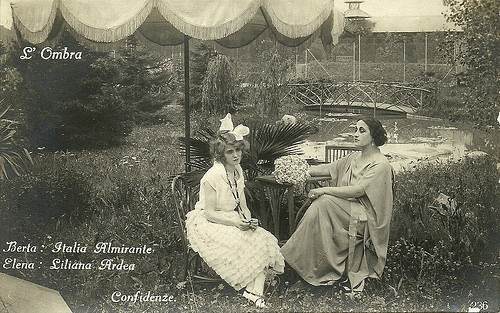
Italian postcard by Ed. Ballerini & Fratini, Firenze, no. 236. Photo: Alba Film. Publicity still for L'ombra (Mario Almirante, 1923) with Italia Almirante as Berta and Liliana Ardea as Elena. Caption: "Confidential matters".
Life between enduring her misfortune and the illusion of love
Italia Almirante Manzini plays in L'ombra/The Shadow (1923) the beautiful young Berta Trégner. In an accident, Berta is paralysed. She then spends her life between enduring her misfortune and the illusion that her husband Gerardo ( Alberto Collo ) continues to love her.
After six years, however, almost miraculously, she recovers and discovers that Gerardo has created another family with Elena (Liliana Ardea), her best friend and that they also have a child.
Distraught, she runs away from home. The situation is saved by Michele (Vittorio Pieri), Berta's godfather, who manages to discover that Elena has reconnected with her ex-husband Alberto, and informs Gerardo, who, having rejected the unworthy Elena, can return to Berta to find love again.
L'ombra/The Shadow (1923) was scripted by director Mario Almirante himself. It is an adaptation of the 1915 play of the same name written by Dario Niccodemi. It was first performed at Milan's Teatro Manzoni in 1916 by the Compagnia Giannina Chiantoni, Irma Gramatica and Ernesto Sabbatini.
The first film adaptation was L'ombra/The Shadow (1917) by Mario Caserini starring Vittoria Lepanto . In 1954, a new adaptation was made by Giorgio Bianchi, L'ombra/The Shadow, starring Märta Torén and Pierre Cressoy.
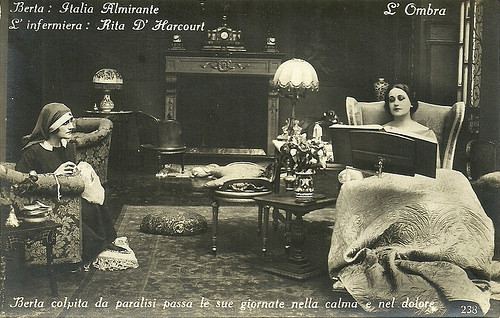
Italian postcard by Ed. Ballerini & Fratini, Firenze, no. 238. Photo: Alba Film. Publicity still for L'ombra (Mario Almirante, 1923). Caption: "Struck by paralysis, Berta ( Italia Almirante ) passed her days in tranquillity and suffering." The nurse was played by Rita D'Harcourt.
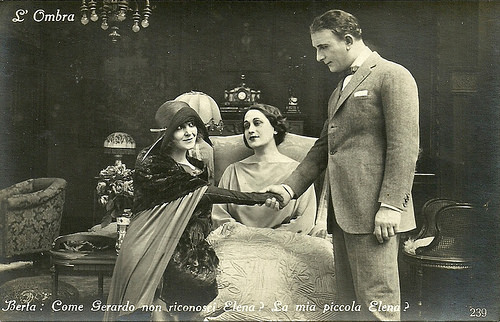
Italian postcard by Ed. Ballerini & Fratini, Firenze, no. 239. Photo: Alba Film. Publicity still for L'ombra (Mario Almirante, 1923). Caption: "Berta: Why, Gerardo, don't you recognize Elena? My little Elena?" Italia Almirante as Berta, Alberto Collo as Gerardo and Liliana Ardea as Elena.
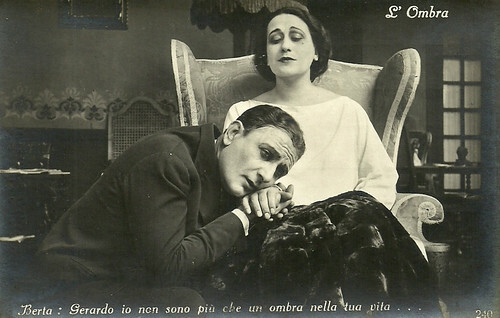
Italian postcard by Ed. Ballerini & Fratini, Firenze, no. 240. Photo: Alba Film. Alberto Collo and Italia Almirante in L'ombra (Mario Almirante, 1923). Caption: "Berta: Gerardo, I am no more than a shadow in your life...."
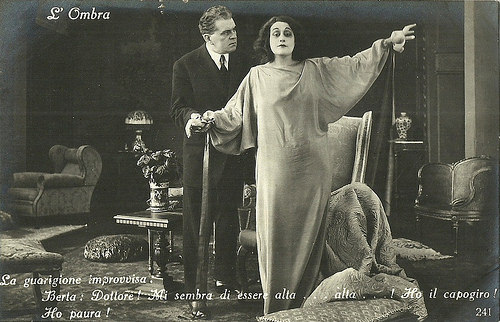
Italian postcard by Ed. Ballerini & Fratini, Firenze, no. 241. Photo: Alba Film. Publicity still for L'ombra (Mario Almirante, 1923). Caption: "The sudden healing. Berta: Doctor! It seems as if I am tall... tall. My head spins! I am afraid!" The doctor was played by Domenico Marverti.
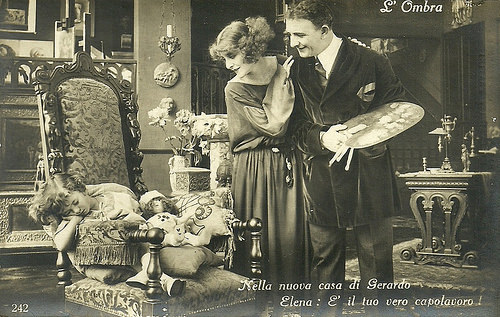
Italian postcard by Ed. Ballerini & Fratini, Firenze, no. 242. Photo: Alba Film. Alberto Collo as Gerardo and Liliana Ardea as Elena in L'ombra (Mario Almirante, 1923). Caption: "In the new house of Gerardo. Elena: He is your real masterpiece!".
A titanic struggle between opposing feelings and erupting passions
How did the critics judge the film hundred years ago? In La rivista cinematografica, 'Gulliver' writes on 25 April 1924: "The drama unfolds intensely and collectedly in the soul of the protagonist. Everything is contained within her, a titanic struggle between opposing feelings and erupting passions, without, however, addressing ideological and moral problems. If these erupt suddenly and vehemently, without preparation and almost without entanglement, it is because of that strange game that an author sometimes enjoys for a sense of acrobatic and theatrical virtuosity [...]. The theatrical intricacy, which in many works extends from the first to the last scene with progressive potential, here is muted and only appears in the evolution of the woman's consequent soul, in its passages, nuances and, we would say, in the foreboding of the obscure immanence of destiny [...].
This having wanted to develop a superior concept evidently creates imbalances between the idea, abstraction and reality, matter: imbalances that remain in the cinema, even though it possesses greater means of implementation and greater possibilities so that the realistic event suffocates the symbolic meaning that we, unlike other writers, wanted to emphasise for a greater understanding and penetration of the work, also because we followed the comments of the public that crowded Ghersi, comments based on exteriority and impression. Instead, how much understanding would be needed and how much less levity of judgement, for a just appreciation of art. If the public reads us, they can profit well from these notes."
In the catalogue of Il Cinema Ritrovato 2023, Ivo Blom writes: "The film partly re-enacts the silent parable of people suffering from paralysis who regain their strength in a miraculous way, as in The Home Maker (King Baggot, 1925) or Lucky Star (Frank Borzage, 1929). Even more, the film follows the parables of silent films about the blind who, once they regain their sight, discover a bitter reality, e.g. that their friend, husband or wife no longer feels love for them, as for instance in the French film, Mieux valait la nuit (Éclair, 1911) with Cécile Guyon, or the Danish film Hjertestorme (August Blom, 1916) with Clara Wieth ."
In another article, 'Italia Almirante e le arti', Blom observes: "While Niccodemi's text begins in medias res. Berta is already paralysed, 'in a statue-like immobility' (again a statuesque, sculptural quality, as in another film with Italia Almirante : La statua di carne ), the film instead shows what precedes Berta's paralysis. [...] In the prologue, we see the happiness of Gerardo and Berta. He is an accomplished painter, and she is a tennis player, living in an elegant house. In a close-up, we see Gerardo in front of Berta's painted portrait. The portrait expresses the man's love for his wife, but it is also the face of the film's star, Italia Almirante Manzini , who thus confirms her status, as with the portrait in La statua di carne .
We see the latter only in passing, briefly, but it stands in contrast to the later portraits in the film. We then witness Gerardo's painting lesson to Elena, Berta's coquettish young niece. In the film, the camera pans from left to right, while in the film's promotional postcard depicting this scene, we have a visual synthesis. The captions ironise Elena's crush on Gerardo. Later, Elena marries her young lover and goes on a trip. It is then that Berta suffers from paralysis. Very beautiful at this point in the film is the play with a large mirror, raised so that Berta can no longer observe herself. At first, Gerardo takes care of his wife and feels guilty. Berta says she now feels like a shadow, thus establishing an explicit reference to the film's title. As soon as Elena returns, tired of the groom, Gerardo secretly starts an affair with her. From the two a child is born: the son Berta could not give him."
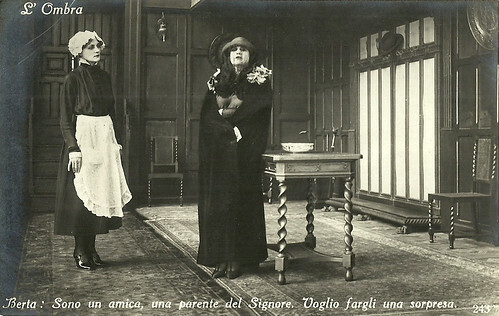
Italian postcard by Ed. Ballerini & Fratini, Firenze, no. 243. Photo: Alba Film. Italia Almirante as Berta in L'ombra (Mario Almirante, 1923). Caption: "Berta: I am a friend, a relative of His Lordship. I want to give him a surprise."
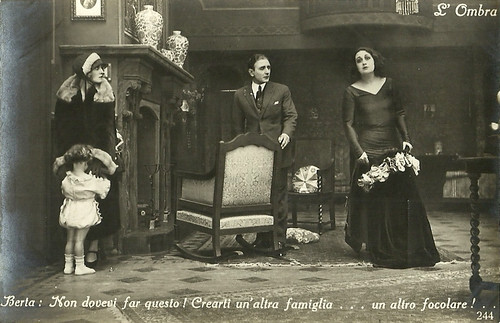
Italian postcard by Ed. Ballerini & Fratini, Firenze, no. 244. Photo: Alba Film. Italia Almirante as Berta, Liliana Ardea as Elena and Alberto Collo as Gerardo in L'ombra (Mario Almirante, 1923). Caption: "Berta [to Gerardo]: You shouldn't have done this! Raise another family... another home!".
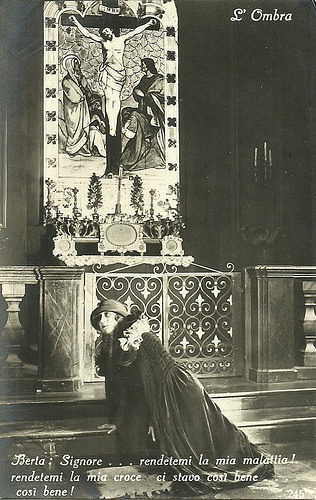
Italian postcard by Ed. Ballerini & Fratini, Firenze, no. 245. Photo: Alba Film. Publicity still for L'ombra (Mario Almirante, 1923). Caption: "Berta: Lord... return me my illness! Return me my cross, it felt so good, so good!"
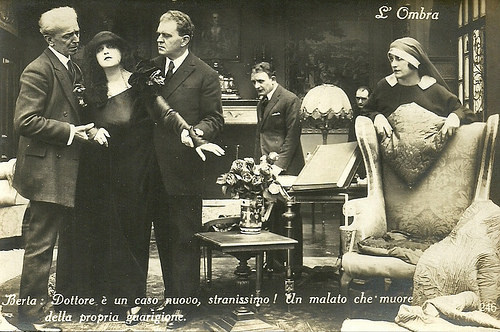
Italian postcard by Ed. Ballerini & Fratini, Firenze, no. 246. Photo: Alba Film. Publicity still for L'ombra (Mario Almirante, 1923). Caption: "Berta: Doctor, this is a new case, very strange! A sick person who dies of her own healing." Italia Almirante as Berta, in the back Alberto Collo as Gerardo, who repents his bigamy. Extreme left godfather Michele (Vittorio Pieri), and next to him was the doctor (Domenico Marverti).
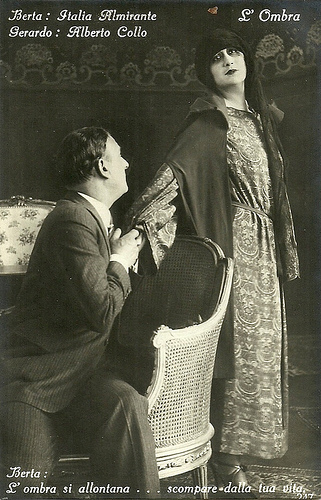
Italian postcard by Ed. Ballerini & Fratini, Firenze, no. 247. Photo: Alba Film. Italia Almirante as Berta and Alberto Collo as Gerardo in L'ombra (Mario Almirante, 1923). Caption: Berta: "The shadow is receding... disappearing from your life."
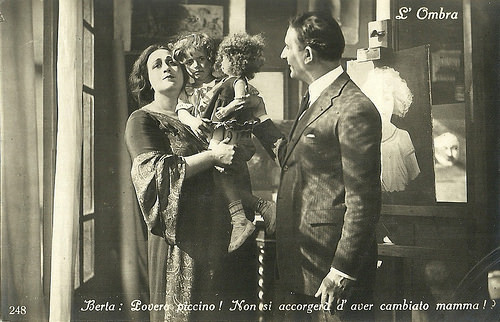
Italian postcard by Ed. Ballerini & Fratini, Firenze, no. 248. Photo: Alba Film. Publicity still for L'ombra (Mario Almirante, 1923), with Italia Almirante as Berta and Alberto Collo as Gerardo. Caption: "Berta: Poor little one! He won't realize to have changed mother." This image represents the final scene of the film.
Sources: Ivo Blom (Italia Almirante e le arti: Relazioni pittoriche, scultoree e teatrali in Femmina, La statua di carne e L’ombra‘, in: Alessandro Faccioli, Elena Mosconi eds., Divine. Nuove prospettive sul cinema muto italiano), Il Cinema Ritrovato, Wikipedia (Italian) and IMDb.

Italian postcard by Ed. Ballerini & Fratini, Firenze, no. 231. Photo: Alba Film. Publicity still for L'ombra (Mario Almirante, 1923). Caption: "In the garden of the villa of Gerardo and Berta".

Italian postcard by Ed. Ballerini & Fratini, Firenze, no. 232. Photo: Alba Film. Italia Almirante Manzini as Berta, Alberto Collo as Gerardo and Vittorio Pieri as Berta's godfather Michele in L'ombra (Mario Almirante, 1923). Caption: "Berta: Don't look, godfather! These are matters which don't concern you."

Italian postcard by Ed. Ballerini & Fratini, Firenze, no. 233. Photo: Alba Film. Publicity still for L'ombra (Mario Almirante). Caption: Morning strolls.

Italian postcard by Ed. Ballerini & Fratini, Firenze, no. 23?. Photo: Alba Film. Publicity still for L'ombra (Mario Almirante, 1923) with Liliana Ardea as Elena and Alberto Collo as Gerardo. Caption: "Berta's little friend and the daily painting lesson".

Italian postcard by Ed. Ballerini & Fratini, Firenze, no. 235. Photo: Alba Film. Publicity still for L'ombra (Mario Almirante, 1923), with Italia Almirante Manzini as Berta and Vittorio Pieri as Berta's godfather Michele. Caption: "Berta: Beware of the thorns, but don't ruin my roses".

Italian postcard by Ed. Ballerini & Fratini, Firenze, no. 236. Photo: Alba Film. Publicity still for L'ombra (Mario Almirante, 1923) with Italia Almirante as Berta and Liliana Ardea as Elena. Caption: "Confidential matters".
Life between enduring her misfortune and the illusion of love
Italia Almirante Manzini plays in L'ombra/The Shadow (1923) the beautiful young Berta Trégner. In an accident, Berta is paralysed. She then spends her life between enduring her misfortune and the illusion that her husband Gerardo ( Alberto Collo ) continues to love her.
After six years, however, almost miraculously, she recovers and discovers that Gerardo has created another family with Elena (Liliana Ardea), her best friend and that they also have a child.
Distraught, she runs away from home. The situation is saved by Michele (Vittorio Pieri), Berta's godfather, who manages to discover that Elena has reconnected with her ex-husband Alberto, and informs Gerardo, who, having rejected the unworthy Elena, can return to Berta to find love again.
L'ombra/The Shadow (1923) was scripted by director Mario Almirante himself. It is an adaptation of the 1915 play of the same name written by Dario Niccodemi. It was first performed at Milan's Teatro Manzoni in 1916 by the Compagnia Giannina Chiantoni, Irma Gramatica and Ernesto Sabbatini.
The first film adaptation was L'ombra/The Shadow (1917) by Mario Caserini starring Vittoria Lepanto . In 1954, a new adaptation was made by Giorgio Bianchi, L'ombra/The Shadow, starring Märta Torén and Pierre Cressoy.

Italian postcard by Ed. Ballerini & Fratini, Firenze, no. 238. Photo: Alba Film. Publicity still for L'ombra (Mario Almirante, 1923). Caption: "Struck by paralysis, Berta ( Italia Almirante ) passed her days in tranquillity and suffering." The nurse was played by Rita D'Harcourt.

Italian postcard by Ed. Ballerini & Fratini, Firenze, no. 239. Photo: Alba Film. Publicity still for L'ombra (Mario Almirante, 1923). Caption: "Berta: Why, Gerardo, don't you recognize Elena? My little Elena?" Italia Almirante as Berta, Alberto Collo as Gerardo and Liliana Ardea as Elena.

Italian postcard by Ed. Ballerini & Fratini, Firenze, no. 240. Photo: Alba Film. Alberto Collo and Italia Almirante in L'ombra (Mario Almirante, 1923). Caption: "Berta: Gerardo, I am no more than a shadow in your life...."

Italian postcard by Ed. Ballerini & Fratini, Firenze, no. 241. Photo: Alba Film. Publicity still for L'ombra (Mario Almirante, 1923). Caption: "The sudden healing. Berta: Doctor! It seems as if I am tall... tall. My head spins! I am afraid!" The doctor was played by Domenico Marverti.

Italian postcard by Ed. Ballerini & Fratini, Firenze, no. 242. Photo: Alba Film. Alberto Collo as Gerardo and Liliana Ardea as Elena in L'ombra (Mario Almirante, 1923). Caption: "In the new house of Gerardo. Elena: He is your real masterpiece!".
A titanic struggle between opposing feelings and erupting passions
How did the critics judge the film hundred years ago? In La rivista cinematografica, 'Gulliver' writes on 25 April 1924: "The drama unfolds intensely and collectedly in the soul of the protagonist. Everything is contained within her, a titanic struggle between opposing feelings and erupting passions, without, however, addressing ideological and moral problems. If these erupt suddenly and vehemently, without preparation and almost without entanglement, it is because of that strange game that an author sometimes enjoys for a sense of acrobatic and theatrical virtuosity [...]. The theatrical intricacy, which in many works extends from the first to the last scene with progressive potential, here is muted and only appears in the evolution of the woman's consequent soul, in its passages, nuances and, we would say, in the foreboding of the obscure immanence of destiny [...].
This having wanted to develop a superior concept evidently creates imbalances between the idea, abstraction and reality, matter: imbalances that remain in the cinema, even though it possesses greater means of implementation and greater possibilities so that the realistic event suffocates the symbolic meaning that we, unlike other writers, wanted to emphasise for a greater understanding and penetration of the work, also because we followed the comments of the public that crowded Ghersi, comments based on exteriority and impression. Instead, how much understanding would be needed and how much less levity of judgement, for a just appreciation of art. If the public reads us, they can profit well from these notes."
In the catalogue of Il Cinema Ritrovato 2023, Ivo Blom writes: "The film partly re-enacts the silent parable of people suffering from paralysis who regain their strength in a miraculous way, as in The Home Maker (King Baggot, 1925) or Lucky Star (Frank Borzage, 1929). Even more, the film follows the parables of silent films about the blind who, once they regain their sight, discover a bitter reality, e.g. that their friend, husband or wife no longer feels love for them, as for instance in the French film, Mieux valait la nuit (Éclair, 1911) with Cécile Guyon, or the Danish film Hjertestorme (August Blom, 1916) with Clara Wieth ."
In another article, 'Italia Almirante e le arti', Blom observes: "While Niccodemi's text begins in medias res. Berta is already paralysed, 'in a statue-like immobility' (again a statuesque, sculptural quality, as in another film with Italia Almirante : La statua di carne ), the film instead shows what precedes Berta's paralysis. [...] In the prologue, we see the happiness of Gerardo and Berta. He is an accomplished painter, and she is a tennis player, living in an elegant house. In a close-up, we see Gerardo in front of Berta's painted portrait. The portrait expresses the man's love for his wife, but it is also the face of the film's star, Italia Almirante Manzini , who thus confirms her status, as with the portrait in La statua di carne .
We see the latter only in passing, briefly, but it stands in contrast to the later portraits in the film. We then witness Gerardo's painting lesson to Elena, Berta's coquettish young niece. In the film, the camera pans from left to right, while in the film's promotional postcard depicting this scene, we have a visual synthesis. The captions ironise Elena's crush on Gerardo. Later, Elena marries her young lover and goes on a trip. It is then that Berta suffers from paralysis. Very beautiful at this point in the film is the play with a large mirror, raised so that Berta can no longer observe herself. At first, Gerardo takes care of his wife and feels guilty. Berta says she now feels like a shadow, thus establishing an explicit reference to the film's title. As soon as Elena returns, tired of the groom, Gerardo secretly starts an affair with her. From the two a child is born: the son Berta could not give him."

Italian postcard by Ed. Ballerini & Fratini, Firenze, no. 243. Photo: Alba Film. Italia Almirante as Berta in L'ombra (Mario Almirante, 1923). Caption: "Berta: I am a friend, a relative of His Lordship. I want to give him a surprise."

Italian postcard by Ed. Ballerini & Fratini, Firenze, no. 244. Photo: Alba Film. Italia Almirante as Berta, Liliana Ardea as Elena and Alberto Collo as Gerardo in L'ombra (Mario Almirante, 1923). Caption: "Berta [to Gerardo]: You shouldn't have done this! Raise another family... another home!".

Italian postcard by Ed. Ballerini & Fratini, Firenze, no. 245. Photo: Alba Film. Publicity still for L'ombra (Mario Almirante, 1923). Caption: "Berta: Lord... return me my illness! Return me my cross, it felt so good, so good!"

Italian postcard by Ed. Ballerini & Fratini, Firenze, no. 246. Photo: Alba Film. Publicity still for L'ombra (Mario Almirante, 1923). Caption: "Berta: Doctor, this is a new case, very strange! A sick person who dies of her own healing." Italia Almirante as Berta, in the back Alberto Collo as Gerardo, who repents his bigamy. Extreme left godfather Michele (Vittorio Pieri), and next to him was the doctor (Domenico Marverti).

Italian postcard by Ed. Ballerini & Fratini, Firenze, no. 247. Photo: Alba Film. Italia Almirante as Berta and Alberto Collo as Gerardo in L'ombra (Mario Almirante, 1923). Caption: Berta: "The shadow is receding... disappearing from your life."

Italian postcard by Ed. Ballerini & Fratini, Firenze, no. 248. Photo: Alba Film. Publicity still for L'ombra (Mario Almirante, 1923), with Italia Almirante as Berta and Alberto Collo as Gerardo. Caption: "Berta: Poor little one! He won't realize to have changed mother." This image represents the final scene of the film.
Sources: Ivo Blom (Italia Almirante e le arti: Relazioni pittoriche, scultoree e teatrali in Femmina, La statua di carne e L’ombra‘, in: Alessandro Faccioli, Elena Mosconi eds., Divine. Nuove prospettive sul cinema muto italiano), Il Cinema Ritrovato, Wikipedia (Italian) and IMDb.
Published on June 24, 2023 22:00
June 23, 2023
Ronald Colman
We're in Bologna, Italy, for Il Cinema Ritrovato 2023! The Orchestra of Teatro Comunale di Bologna returns to the Piazza Maggiore stage for two breathtaking cineconcerts to be conducted by Timothy Brock. The masterpieces that will receive full orchestral accompaniment are Stella Dallas by Henry King on 26 June, featuring a new original score by Stephen Horne, and Ernst Lubitsch’s Lady Windermere’s Fan on 30 June with a new score by Timothy Brock. We'll be there. In both films, the leading man is elegant British actor Ronald Colman (1891-1958). He was a top box office draw in Hollywood films as the archetypal English gentleman throughout the 1920s, 1930s and 1940s. ‘The Man with the velvet voice’ was nominated for four Academy Awards. In 1948 he finally won the Oscar for his splendid portrayal of a tormented actor in A Double Life.
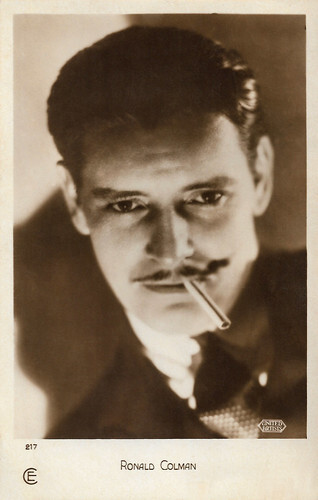
French postcard by Editions Cinémagazine, no. 217. Photo: United Artists.
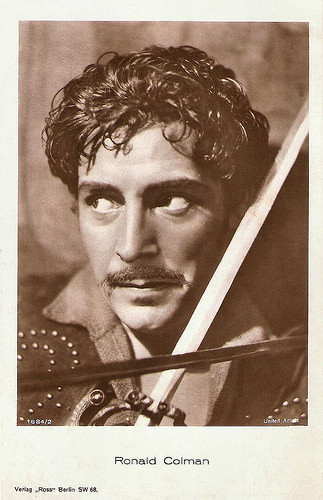
German postcard by Ross Verlag, no. 1684/2, 1927-1928. Photo: United Artists. Publicity still for Two Lovers (Fred Niblo, 1928).
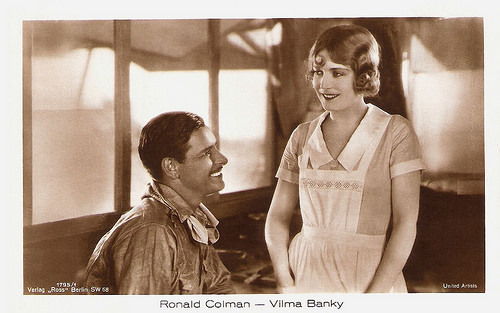
German postcard by Ross Verlag, no. 1795/1, 1927-1928. Photo: United Artists. Publicity still for The Winning of Barbara Worth (Henry King, 1926) with Vilma Bánky .
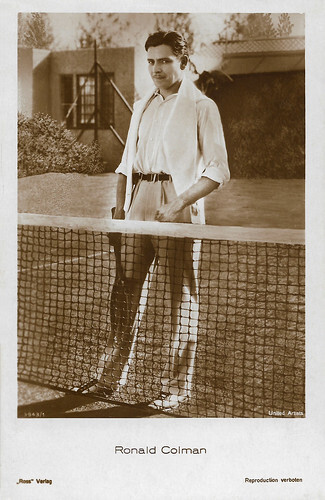
German postcard by Ross Verlag, no. 3943/1, 1928-1929. Photo: United Artists.
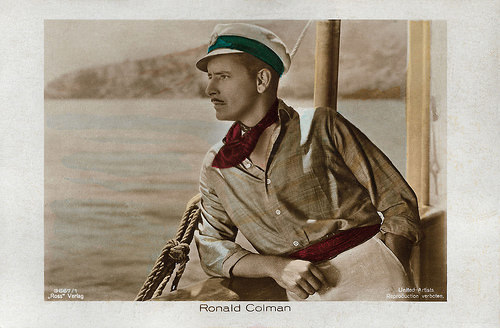
German postcard by Ross Verlag, no. 3667/1, 1928-1929. Photo: United Artists. Publicity still for The Rescue (Herbert Brenon, 1929).
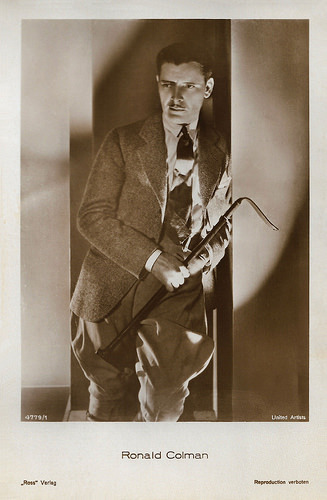
German postcard by Ross Verlag, no. 4779/1, 1929-1930. Photo: United Artists.
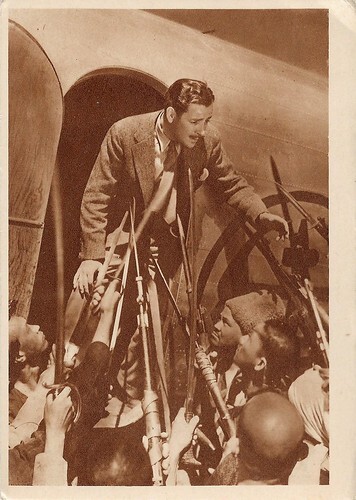
Italian postcard by Vecchioni & Guadagno, Roma. Photo: Columbia EIA. Ronald Colman in Lost Horizon (Frank Capra, 1937).
Decorated, discharged and depressed
Ronald Charles Colman was born in 1891 in Richmond, England. He was the fifth of six children of silk importer Charles Colman and his wife Marjory Read Fraser. Ronald was educated at a boarding school in Littlehampton, where he discovered he enjoyed acting. When Ronald was 16 his father died of pneumonia, putting an end to the boy's plans to attend Cambridge and become an engineer. He went to work as a shipping clerk at the British Steamship Company.
He also became a well-known amateur actor and was a member of the West Middlesex Dramatic Society (1908-1909). In 1909, he joined the London Scottish Regiment, a territorial army force, and he was sent to France at the outbreak of World War I. Colman took part in the First Battle of Ypres and was severely wounded at the battle at Messines in Belgium. The shrapnel wounds he took to his legs invalided him out of active service.
In May 1915, decorated, discharged and depressed, he returned home with a limp that he would attempt to hide throughout the rest of his acting career. He tried to enter the consular service, but a chance encounter got him a small role in the London play The Maharanee of Arakan (1916). He dropped other plans and concentrated on the theatre.
Producers soon noted the young actor with his striking good looks, rich voice and rare dignity, and Colman was rewarded with a succession of increasingly prominent parts. He worked with stage greats Gladys Cooper and Gerald du Maurier. He made extra money appearing in films like the two-reel silent comedy The Live Wire (Cecil Hepworth, 1917). The set was an old house with a negligible budget, and Colman doubled as the leading character and prop man. The film was never released though.
Other silent British films were The Snow of the Desert (Walter West, 1919) with Violet Hopson and Stewart Rome , and The Black Spider (William Humphrey, 1920) with Mary Clare. The negatives of all of Colman's early British films have probably been destroyed during the 1941 London Blitz. After a brief courtship, he married actress Thelma Raye in 1919. The marriage was in trouble almost from the beginning. The two separated in 1923 but were not divorced until 1934.
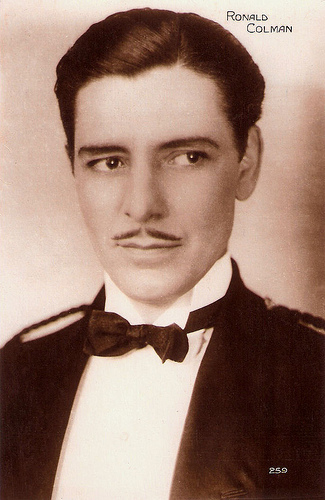
French postcard by Cinémagazine-Edition, Paris, no. 259.
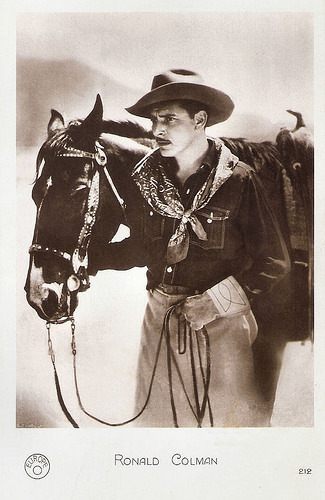
French postcard by Europe, no. 212. Photo: publicity still for The Winning of Barbara Worth (Henry King, 1926).
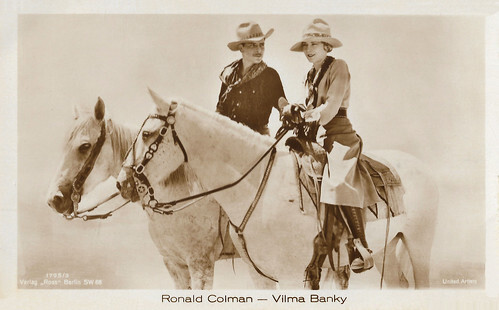
German postcard by Ross Verlag, no. 1795/3, 1927-1928. Photo: United Artists. Ronald Colman and Vilma Banky in The Winning of Barbara Worth (Henry King, 1926).
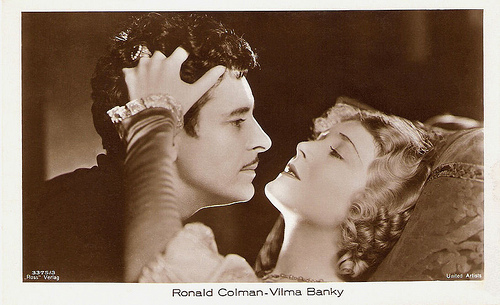
German postcard by Ross Verlag, no. 3375/3, 1928-1929. Photo: United Artists. Publicity still for Two Lovers (Fred Niblo, 1928) with Vilma Bánky .
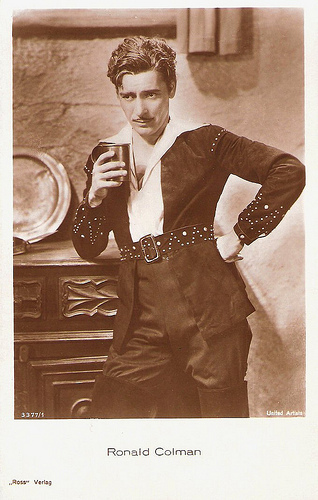
German postcard by Ross Verlag, no. 3377/1, 1928-1929. Photo: United Artists.
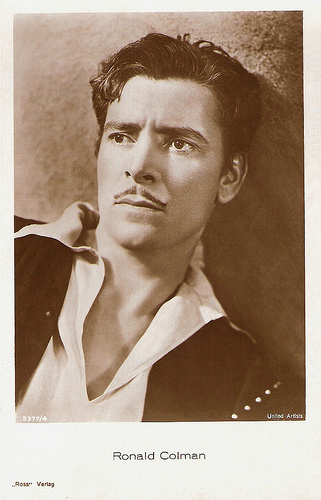
German postcard by Ross Verlag, no. 3377/4, 1928-1929. Photo: United Artists. Ronald Colman in Two Lovers (Fred Niblo 1928).
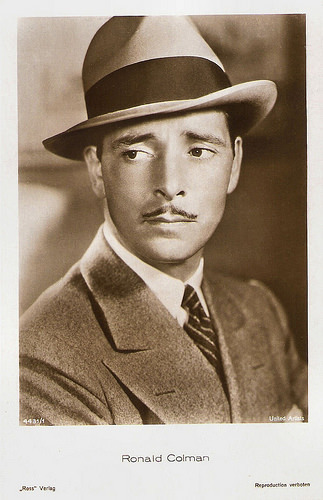
German postcard by Ross Verlag, no. 4431/1, 1929-1930. Photo: United Artists.
Romantic tearjerker
In 1920 Ronald Colman set out for New York in hopes of finding greater fortune there than in war-depressed England. His American film debut was in the tawdry melodrama Handcuffs or Kisses? (George Archainbaud, 1920). He toured with Robert Warwick in 'The Dauntless Three', and subsequently toured with Fay Bainter in 'East is West'.
After two years of impoverishment, he was cast in the Broadway hit play 'La Tendresse' (1922). Director Henry King spotted him and cast him as Lillian Gish 's leading man in The White Sister (Henry King, 1923), filmed in Italy. The romantic tear-jerker was wildly popular and Colman was quickly proclaimed a new film star.
This success led to a contract with prominent independent film producer Samuel Goldwyn, and in the following ten years, he became a very popular silent film star in both romantic and adventure films. Among his most successful films for Goldwyn were The Dark Angel (George Fitzmaurice, 1925) with Hungarian actress Vilma Bánky , Stella Dallas (Henry King, 1926), the Oscar Wilde adaptation Lady Windermere's Fan (Ernst Lubitsch, 1925) and The Winning of Barbara Worth (Henry King, 1926) with Gary Cooper .
Colman's dark hair and eyes and his athletic and riding ability led reviewers to describe him as a ‘Valentino type’. He was often cast in similar, exotic roles. The film that cemented this position as a top star was Beau Geste (Herbert Brenon, 1926), Paramount's biggest hit of 1926. It was the rousing tale of three brothers (Colman, Neil Hamilton and Ralph Forbes ), who join the Foreign Legion to escape the law. Beau Geste was full of mystery, desert action, intrigue and above all, brotherly loyalty. Colman's gentlemanly courage and quiet strength were showcased to perfection in the role of the oldest brother, Beau. The film is still referred to as possibly the greatest Foreign Legion film ever produced.
Towards the end of the silent era, Colman was teamed again with Vilma Bánky under Samuel Goldwyn. The two would make a total of five films together and their popularity rivalled that of Greta Garbo and John Gilbert .
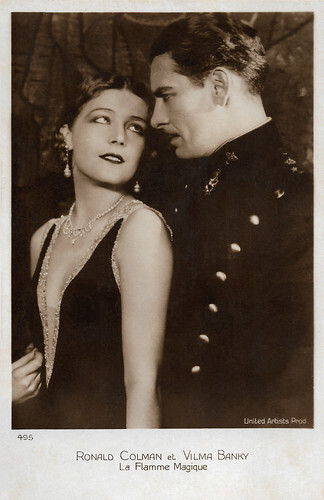
French postcard by Cinémagazine-Edition, Paris, no. 495. Photo: United Artists. Ronald Colman and Vilma Banky in The Magic Flame (Henry King, 1927).
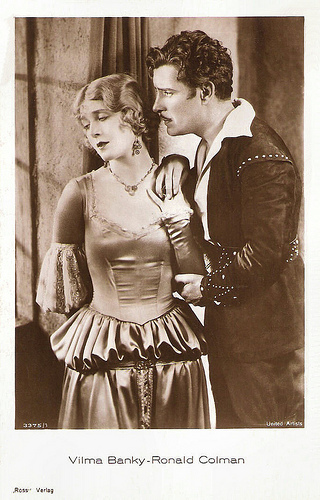
German postcard by Ross Verlag, no. 3375/1, 1928-1929. Photo: United Artists. Publicity still for Two Lovers (Fred Niblo, 1928) with Vilma Bánky .

German postcard by Ross Verlag, no. 3667/1, 1928-1929. Photo: United Artists. Publicity still for The Rescue (Herbert Brenon, 1929).
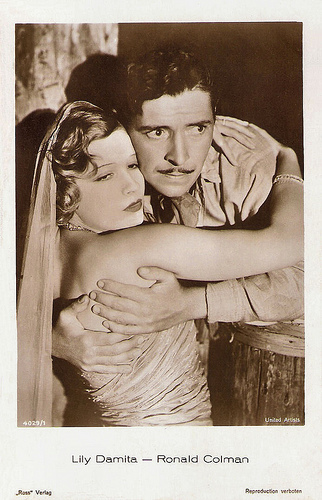
German postcard by Ross Verlag, no. 4029/1, 1929-1930. Photo: United Artists. Ronald Colman and Lily Damita in The Rescue (Herbert Brenon, 1929).
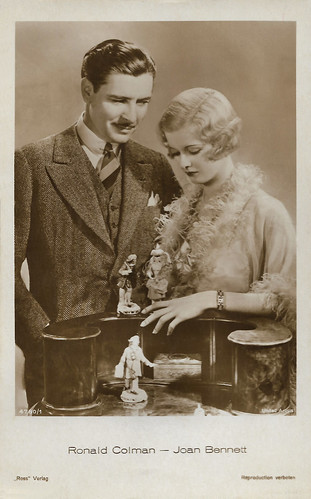
German postcard by Ross Verlag, no. 4780/1, 1929-1930. Photo: United Artists. Ronald Colman and Joan Bennett in Bulldog Drummond (F. Richard Jones, 1929).
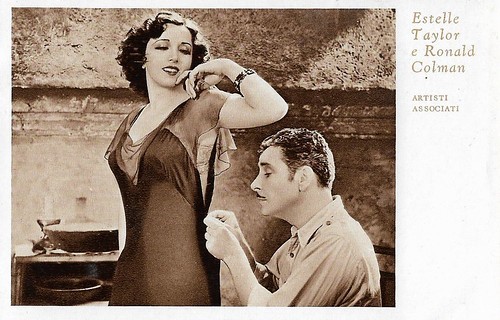
Italian postcard by Cinema-Illustrazione, series 2, no. 24. Photo: United Artists. Estelle Taylor and Ronald Colman in The Unholy Garden (George Fitzmaurice, 1931).
Sophisticated thoughtful characters of integrity
Although Ronald Colman was a huge success in silent films, with the coming of sound, his extraordinarily beautiful speaking voice made him even more important to the film industry. His first major talkie success was in 1930 when he was nominated for the Academy Award for Best Actor for two roles - Condemned (Wesley Ruggles, 1929) with Lily Damita , and Bulldog Drummond (F. Richard Jones, 1929) with Joan Bennett .
Thereafter he played a number of sophisticated, noble characters with enormous aplomb such as Clive of India (Richard Boleslawski, 1935) with Colin Clive , but he also swashbuckled expertly when called to do so in films like The Prisoner of Zenda (John Cromwell, 1937) with Madeleine Carroll .
A falling out with Goldwyn in 1934 prompted Colman to avoid long-term contracts for the rest of his career. He became one of just a handful of top stars to successfully freelance, picking and choosing his assignments and studios. His notable films included the Charles Dickens adaptation A Tale of Two Cities (Jack Conway, 1935), the poetic classic Lost Horizon (Frank Capra, 1937), and If I Were King (Frank Lloyd, 1938) with Basil Rathbone as vagabond poet Francois Villon.
During the war, he made two of his very best films - Talk of the Town (George Stevens, 1942) with Cary Grant and Jean Arthur , and the romantic tearjerker Random Harvest (Mervyn LeRoy, 1942), as an amnesiac victim, co-starring with the luminous Greer Garson. For his role in A Double Life (George Cukor, 1947), an actor playing Othello who comes to identify with the character, he won both the Golden Globe for Best Actor in 1947 and the Best Actor Oscar in 1948. Colman made many guest appearances on The Jack Benny Program on the radio, alongside his second wife, British stage and screen actress Benita Hume . Their comedy work as Benny's next-door neighbours led to their own radio comedy The Halls of Ivy from 1950 to 1952, and then on television from 1954 to 1955.
Incidentally, he appeared in films, such as the romantic comedy Champagne for Caesar (Richard Whorf, 1950), and his final film The Story of Mankind (Irwin Allen, 1957) with Hedy Lamarr . Hal Erickson at AllMovie : "a laughably wretched extravaganza from which Colman managed to emerge with his dignity and reputation intact." Ronald Colman died in 1958, aged 67, from a lung infection in Santa Barbara, California. He was survived by Benita Hume , and their daughter Juliet Benita Colman (1944). In 1975, Juliet published the biography 'Ronald Colman: A Very Private Person'.
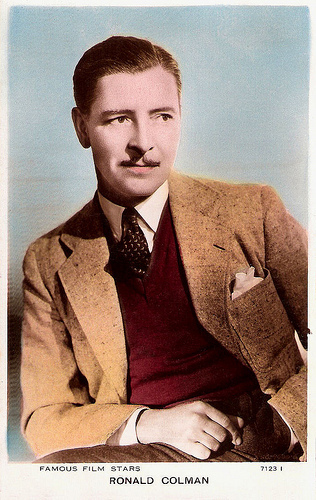
British Valentine's postcard in the Famous Film Stars Series, no. 7123 I.
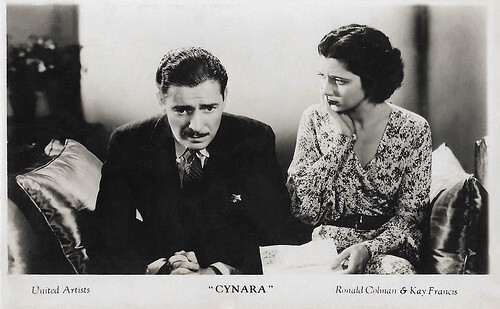
British postcard in the Film Weekly series. Photo: United Artists. Ronald Colman and Kay Francis in Cynara (King Vidor, 1932), a romantic drama film about a British lawyer (Colman) who pays a heavy price for an affair. Francis plays his wife.
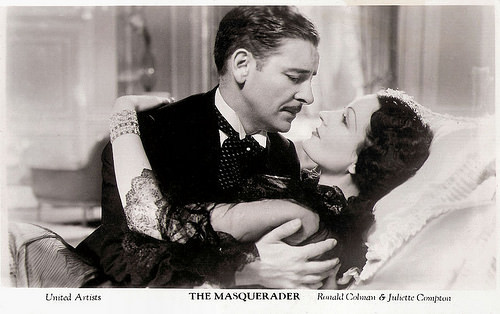
British postcard in the Filmshots series by Film Weekly. Photo: United Artists. Publicity still for The Masquerader (Richard Wallace, 1933) with Juliet Compton.
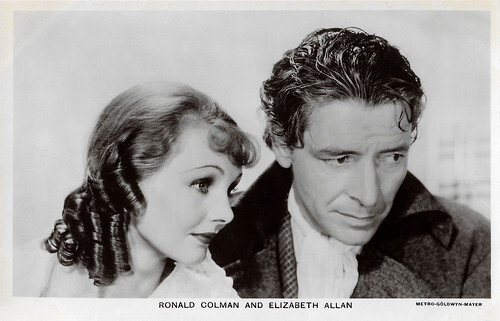
British postcard in the Film Partners Series, London, no. F 201. Photo: Metro-Goldwyn-Mayer. Ronald Colman and Elizabeth Allan in A Tale of Two Cities (Jack Conway, 1935).
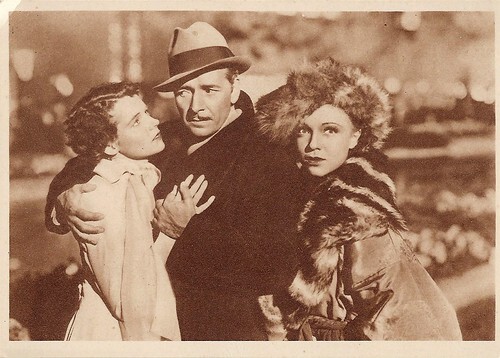
Italian postcard by Vecchioni & Guadagno, Roma. Photo: Columbia EIA. Ronald Colman, Jane Wyatt and Margo in Lost Horizon (Frank Capra, 1937).
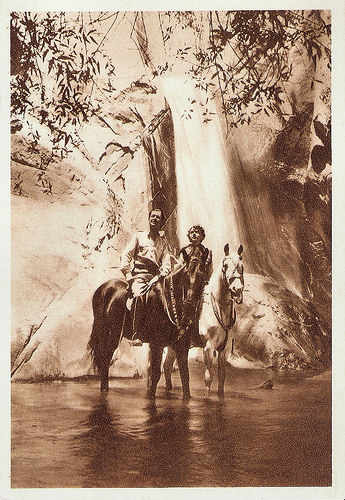
Italian postcard by Vecchioni & Guadagno, Roma. Photo: Columbia EIA. Publicity still for Lost Horizon (Frank Capra, 1937) with Jane Wyatt.
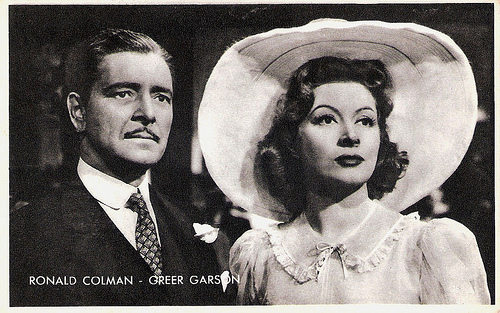
Belgian collectors card by Kwatta, Bois-D'Haine, Serie C, no. C. 170. Photo: M.G.M. Publicity still for Random Harvest (1942) with Greer Garson .
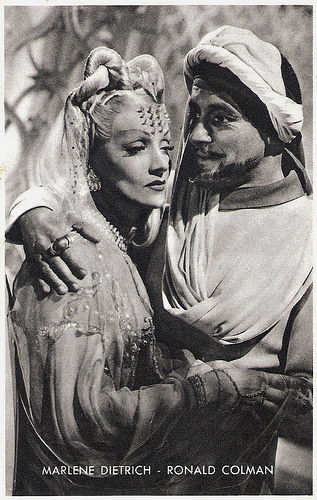
Belgian collectors card by Kwatta, Bois d'Haine, no. C 156. Photo: M.G.M. Publicity still for Kismet (William Dieterle, 1944) with Marlene Dietrich .
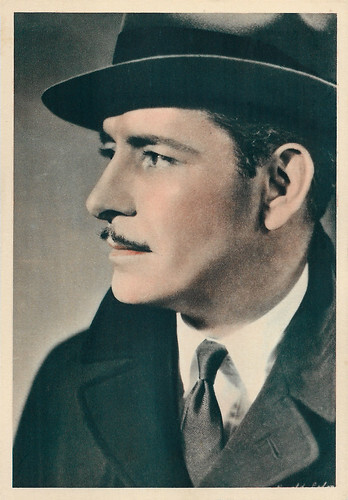
British postcard by De Reszke Cigarettes, no. 19 (of a series of 24 cards).
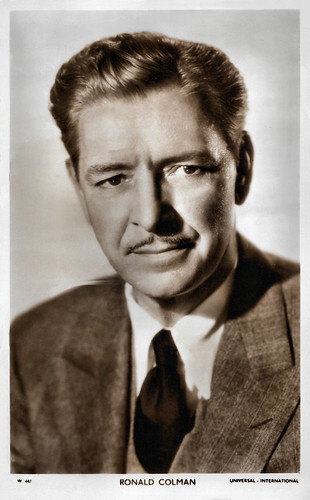
British postcard in the Picturegoer Series, London, no. W 447. Photo: Universal International.
Sources: Hal Erickson (AllMovie), (IMDb), Julie Stowe (The Ronald Colman Pages), Encyclopaedia Britannica, Il Cinema Ritrova 2023, Wikipedia and .

French postcard by Editions Cinémagazine, no. 217. Photo: United Artists.

German postcard by Ross Verlag, no. 1684/2, 1927-1928. Photo: United Artists. Publicity still for Two Lovers (Fred Niblo, 1928).

German postcard by Ross Verlag, no. 1795/1, 1927-1928. Photo: United Artists. Publicity still for The Winning of Barbara Worth (Henry King, 1926) with Vilma Bánky .

German postcard by Ross Verlag, no. 3943/1, 1928-1929. Photo: United Artists.

German postcard by Ross Verlag, no. 3667/1, 1928-1929. Photo: United Artists. Publicity still for The Rescue (Herbert Brenon, 1929).

German postcard by Ross Verlag, no. 4779/1, 1929-1930. Photo: United Artists.

Italian postcard by Vecchioni & Guadagno, Roma. Photo: Columbia EIA. Ronald Colman in Lost Horizon (Frank Capra, 1937).
Decorated, discharged and depressed
Ronald Charles Colman was born in 1891 in Richmond, England. He was the fifth of six children of silk importer Charles Colman and his wife Marjory Read Fraser. Ronald was educated at a boarding school in Littlehampton, where he discovered he enjoyed acting. When Ronald was 16 his father died of pneumonia, putting an end to the boy's plans to attend Cambridge and become an engineer. He went to work as a shipping clerk at the British Steamship Company.
He also became a well-known amateur actor and was a member of the West Middlesex Dramatic Society (1908-1909). In 1909, he joined the London Scottish Regiment, a territorial army force, and he was sent to France at the outbreak of World War I. Colman took part in the First Battle of Ypres and was severely wounded at the battle at Messines in Belgium. The shrapnel wounds he took to his legs invalided him out of active service.
In May 1915, decorated, discharged and depressed, he returned home with a limp that he would attempt to hide throughout the rest of his acting career. He tried to enter the consular service, but a chance encounter got him a small role in the London play The Maharanee of Arakan (1916). He dropped other plans and concentrated on the theatre.
Producers soon noted the young actor with his striking good looks, rich voice and rare dignity, and Colman was rewarded with a succession of increasingly prominent parts. He worked with stage greats Gladys Cooper and Gerald du Maurier. He made extra money appearing in films like the two-reel silent comedy The Live Wire (Cecil Hepworth, 1917). The set was an old house with a negligible budget, and Colman doubled as the leading character and prop man. The film was never released though.
Other silent British films were The Snow of the Desert (Walter West, 1919) with Violet Hopson and Stewart Rome , and The Black Spider (William Humphrey, 1920) with Mary Clare. The negatives of all of Colman's early British films have probably been destroyed during the 1941 London Blitz. After a brief courtship, he married actress Thelma Raye in 1919. The marriage was in trouble almost from the beginning. The two separated in 1923 but were not divorced until 1934.

French postcard by Cinémagazine-Edition, Paris, no. 259.

French postcard by Europe, no. 212. Photo: publicity still for The Winning of Barbara Worth (Henry King, 1926).

German postcard by Ross Verlag, no. 1795/3, 1927-1928. Photo: United Artists. Ronald Colman and Vilma Banky in The Winning of Barbara Worth (Henry King, 1926).

German postcard by Ross Verlag, no. 3375/3, 1928-1929. Photo: United Artists. Publicity still for Two Lovers (Fred Niblo, 1928) with Vilma Bánky .

German postcard by Ross Verlag, no. 3377/1, 1928-1929. Photo: United Artists.

German postcard by Ross Verlag, no. 3377/4, 1928-1929. Photo: United Artists. Ronald Colman in Two Lovers (Fred Niblo 1928).

German postcard by Ross Verlag, no. 4431/1, 1929-1930. Photo: United Artists.
Romantic tearjerker
In 1920 Ronald Colman set out for New York in hopes of finding greater fortune there than in war-depressed England. His American film debut was in the tawdry melodrama Handcuffs or Kisses? (George Archainbaud, 1920). He toured with Robert Warwick in 'The Dauntless Three', and subsequently toured with Fay Bainter in 'East is West'.
After two years of impoverishment, he was cast in the Broadway hit play 'La Tendresse' (1922). Director Henry King spotted him and cast him as Lillian Gish 's leading man in The White Sister (Henry King, 1923), filmed in Italy. The romantic tear-jerker was wildly popular and Colman was quickly proclaimed a new film star.
This success led to a contract with prominent independent film producer Samuel Goldwyn, and in the following ten years, he became a very popular silent film star in both romantic and adventure films. Among his most successful films for Goldwyn were The Dark Angel (George Fitzmaurice, 1925) with Hungarian actress Vilma Bánky , Stella Dallas (Henry King, 1926), the Oscar Wilde adaptation Lady Windermere's Fan (Ernst Lubitsch, 1925) and The Winning of Barbara Worth (Henry King, 1926) with Gary Cooper .
Colman's dark hair and eyes and his athletic and riding ability led reviewers to describe him as a ‘Valentino type’. He was often cast in similar, exotic roles. The film that cemented this position as a top star was Beau Geste (Herbert Brenon, 1926), Paramount's biggest hit of 1926. It was the rousing tale of three brothers (Colman, Neil Hamilton and Ralph Forbes ), who join the Foreign Legion to escape the law. Beau Geste was full of mystery, desert action, intrigue and above all, brotherly loyalty. Colman's gentlemanly courage and quiet strength were showcased to perfection in the role of the oldest brother, Beau. The film is still referred to as possibly the greatest Foreign Legion film ever produced.
Towards the end of the silent era, Colman was teamed again with Vilma Bánky under Samuel Goldwyn. The two would make a total of five films together and their popularity rivalled that of Greta Garbo and John Gilbert .

French postcard by Cinémagazine-Edition, Paris, no. 495. Photo: United Artists. Ronald Colman and Vilma Banky in The Magic Flame (Henry King, 1927).

German postcard by Ross Verlag, no. 3375/1, 1928-1929. Photo: United Artists. Publicity still for Two Lovers (Fred Niblo, 1928) with Vilma Bánky .

German postcard by Ross Verlag, no. 3667/1, 1928-1929. Photo: United Artists. Publicity still for The Rescue (Herbert Brenon, 1929).

German postcard by Ross Verlag, no. 4029/1, 1929-1930. Photo: United Artists. Ronald Colman and Lily Damita in The Rescue (Herbert Brenon, 1929).

German postcard by Ross Verlag, no. 4780/1, 1929-1930. Photo: United Artists. Ronald Colman and Joan Bennett in Bulldog Drummond (F. Richard Jones, 1929).

Italian postcard by Cinema-Illustrazione, series 2, no. 24. Photo: United Artists. Estelle Taylor and Ronald Colman in The Unholy Garden (George Fitzmaurice, 1931).
Sophisticated thoughtful characters of integrity
Although Ronald Colman was a huge success in silent films, with the coming of sound, his extraordinarily beautiful speaking voice made him even more important to the film industry. His first major talkie success was in 1930 when he was nominated for the Academy Award for Best Actor for two roles - Condemned (Wesley Ruggles, 1929) with Lily Damita , and Bulldog Drummond (F. Richard Jones, 1929) with Joan Bennett .
Thereafter he played a number of sophisticated, noble characters with enormous aplomb such as Clive of India (Richard Boleslawski, 1935) with Colin Clive , but he also swashbuckled expertly when called to do so in films like The Prisoner of Zenda (John Cromwell, 1937) with Madeleine Carroll .
A falling out with Goldwyn in 1934 prompted Colman to avoid long-term contracts for the rest of his career. He became one of just a handful of top stars to successfully freelance, picking and choosing his assignments and studios. His notable films included the Charles Dickens adaptation A Tale of Two Cities (Jack Conway, 1935), the poetic classic Lost Horizon (Frank Capra, 1937), and If I Were King (Frank Lloyd, 1938) with Basil Rathbone as vagabond poet Francois Villon.
During the war, he made two of his very best films - Talk of the Town (George Stevens, 1942) with Cary Grant and Jean Arthur , and the romantic tearjerker Random Harvest (Mervyn LeRoy, 1942), as an amnesiac victim, co-starring with the luminous Greer Garson. For his role in A Double Life (George Cukor, 1947), an actor playing Othello who comes to identify with the character, he won both the Golden Globe for Best Actor in 1947 and the Best Actor Oscar in 1948. Colman made many guest appearances on The Jack Benny Program on the radio, alongside his second wife, British stage and screen actress Benita Hume . Their comedy work as Benny's next-door neighbours led to their own radio comedy The Halls of Ivy from 1950 to 1952, and then on television from 1954 to 1955.
Incidentally, he appeared in films, such as the romantic comedy Champagne for Caesar (Richard Whorf, 1950), and his final film The Story of Mankind (Irwin Allen, 1957) with Hedy Lamarr . Hal Erickson at AllMovie : "a laughably wretched extravaganza from which Colman managed to emerge with his dignity and reputation intact." Ronald Colman died in 1958, aged 67, from a lung infection in Santa Barbara, California. He was survived by Benita Hume , and their daughter Juliet Benita Colman (1944). In 1975, Juliet published the biography 'Ronald Colman: A Very Private Person'.

British Valentine's postcard in the Famous Film Stars Series, no. 7123 I.

British postcard in the Film Weekly series. Photo: United Artists. Ronald Colman and Kay Francis in Cynara (King Vidor, 1932), a romantic drama film about a British lawyer (Colman) who pays a heavy price for an affair. Francis plays his wife.

British postcard in the Filmshots series by Film Weekly. Photo: United Artists. Publicity still for The Masquerader (Richard Wallace, 1933) with Juliet Compton.

British postcard in the Film Partners Series, London, no. F 201. Photo: Metro-Goldwyn-Mayer. Ronald Colman and Elizabeth Allan in A Tale of Two Cities (Jack Conway, 1935).

Italian postcard by Vecchioni & Guadagno, Roma. Photo: Columbia EIA. Ronald Colman, Jane Wyatt and Margo in Lost Horizon (Frank Capra, 1937).

Italian postcard by Vecchioni & Guadagno, Roma. Photo: Columbia EIA. Publicity still for Lost Horizon (Frank Capra, 1937) with Jane Wyatt.

Belgian collectors card by Kwatta, Bois-D'Haine, Serie C, no. C. 170. Photo: M.G.M. Publicity still for Random Harvest (1942) with Greer Garson .

Belgian collectors card by Kwatta, Bois d'Haine, no. C 156. Photo: M.G.M. Publicity still for Kismet (William Dieterle, 1944) with Marlene Dietrich .

British postcard by De Reszke Cigarettes, no. 19 (of a series of 24 cards).

British postcard in the Picturegoer Series, London, no. W 447. Photo: Universal International.
Sources: Hal Erickson (AllMovie), (IMDb), Julie Stowe (The Ronald Colman Pages), Encyclopaedia Britannica, Il Cinema Ritrova 2023, Wikipedia and .
Published on June 23, 2023 22:00
Paul van Yperen's Blog
- Paul van Yperen's profile
- 13 followers
Paul van Yperen isn't a Goodreads Author
(yet),
but they
do have a blog,
so here are some recent posts imported from
their feed.



